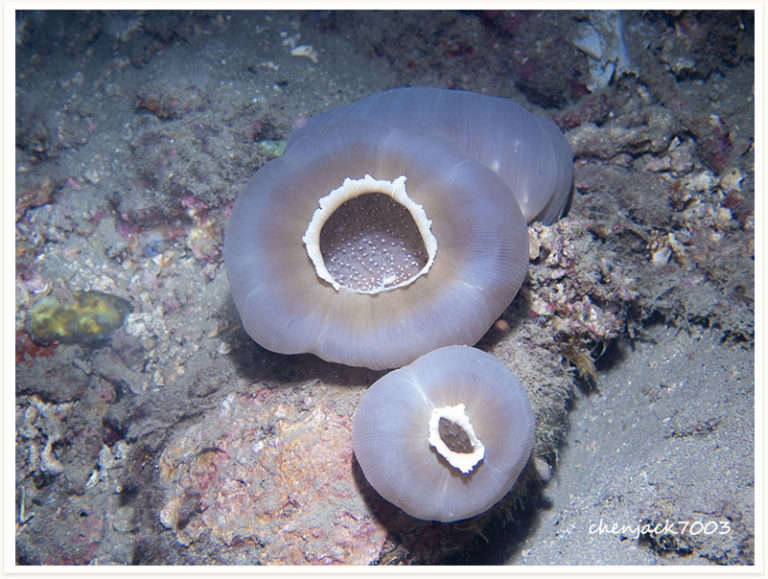卡塔拉海星
Thromidia catalai is a sea star species. It was first described by Pope and Ross Robert Mackerras Rowe circa 1977. Thromidia catalai belongs to the genus Thromidia in the family Mithrodiidae.
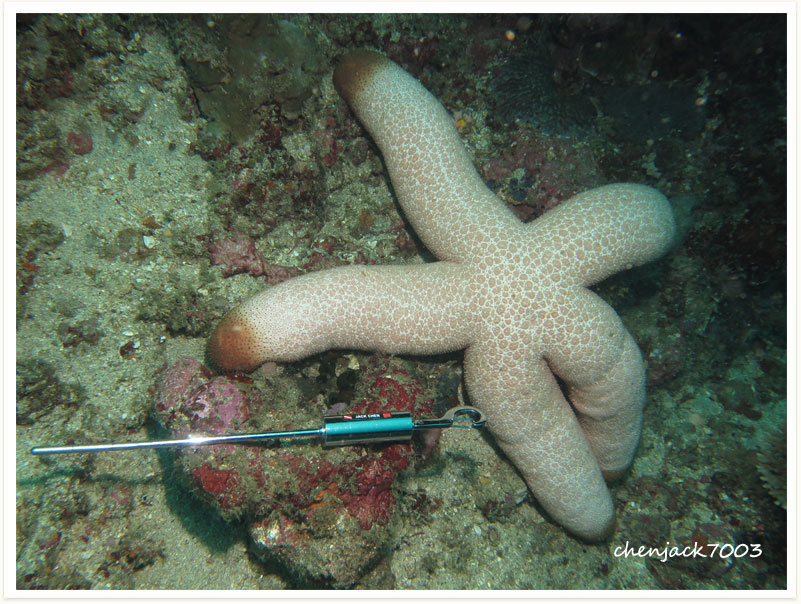
 Underwater Photography
Underwater PhotographyThromidia catalai is a sea star species. It was first described by Pope and Ross Robert Mackerras Rowe circa 1977. Thromidia catalai belongs to the genus Thromidia in the family Mithrodiidae.

Brittle stars or ophiuroids are echinoderms in the class Ophiuroidea closely related to starfish. They crawl across the sea floor using their flexible arms for locomotion. The ophiuroids generally have five long, slender, whip-like arms which may reach up to 60 cm (24 in) in length on the largest specimens. They are also known as serpent stars; the New Latin class name Ophiuroidea is derived from the Ancient Greek ὄφις, meaning “serpent”.
Fromia monilis can reach a diameter of about 30 centimetres (12 in). Tips of the arms and the disc center of this starfish are bright red, while the remaining parts are paler, forming large plates.
The appearance of this sea star can be highly variable (colors, plates, presence of plates on the central disc, armpits…), and its identification using picture can be difficult, as many other species (like Fromia nodosa) can have a very similar aspect.
Growing to a maximum diameter of 26 cm (10 in), Echinaster callosus has a small central disc and five slender cylindrical arms. The aboral (upper) surface is densely covered by warty protuberances. The colour of this starfish is variable, but may be orange, pink or violet, with the warts being a contrasting colour, usually white, pink, red or mauve. The white warts often occur in bands, particularly towards the tips of the arms. There are small yellowish-green retractable pedicellaria between the warts. The oral (under) surface of the starfish is white with white warts. There are ambulacral grooves on the underside of the arms along which food is passed by ciliary action. The tip of each arm bears an eyespot, as well as a bundle of suckers.
A mature C. novaeguineae is pentagonal to subglobose in shape with an inflated appearance and much-abbreviated arms. It can grow to a diameter of 30 cm (12 in). Rows of tube feet are on the underside, and it has a central mouth. The colour is very variable and includes a mottling with darker and lighter shades of fawn, brown, orange, yellow and green. The armoured body wall is made of calcareous ossicles which are supported internally by pillars which buttress the ambulacra. The armouring contains pits into which the tube feet can be retracted. The body cavity is filled with water. On the dorsal face, they can be covered with small conical tubercles, as well inside as outside of papular areas.
The Choriaster granulatus is a species of Asteroidea described by Christian Frederik Lütken in 1869. The Choriaster granulatus belongs to the genus Choriaster, and is known as the Oreasteridae. There are no subspecies listed.
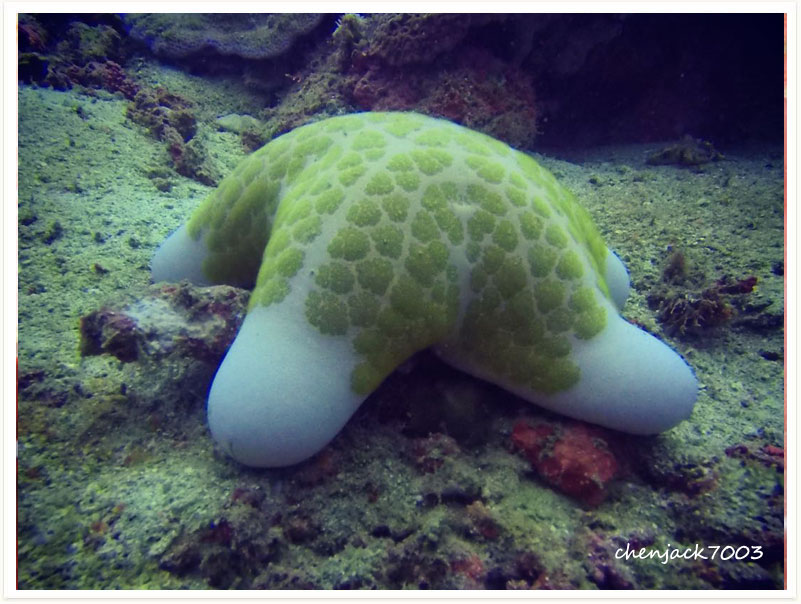
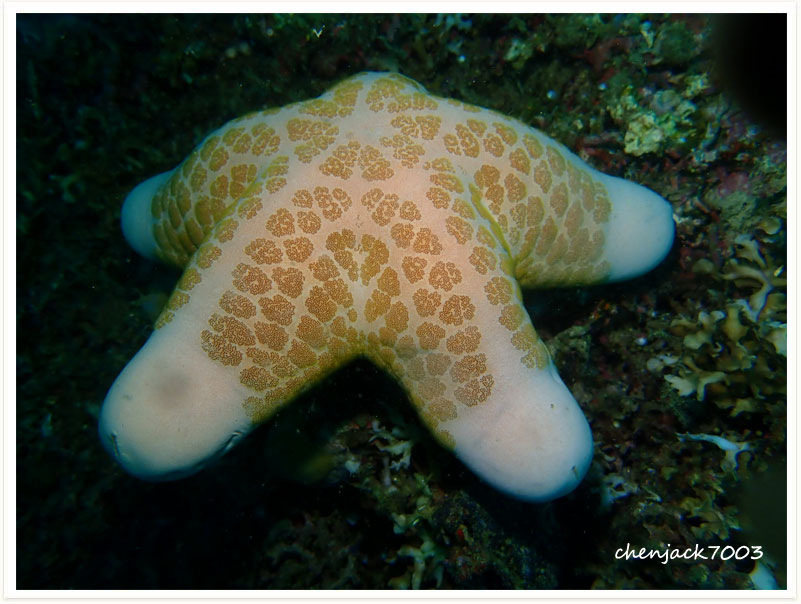
Thylacodes is a genus of sea snails, marine gastropod mollusks in the family Vermetidae, the worm snails or worm shells. The species in this genus were previously placed in the genus Serpulorbis.
Unlike some other vermetids, the species in this genus have no operculum.
Sea butterflies, scientific name Thecosomata (thecosomes, “case/shell-body”), are a taxonomic suborder of small pelagic swimming sea snails. These are holoplanktonic opisthobranch gastropod mollusks in the informal group Opisthobranchia. They include some of the world’s most abundant gastropod species.
Naticarius orientalis is a species of predatory sea snail, a marine gastropod mollusk in the family Naticidae, the moon snails.
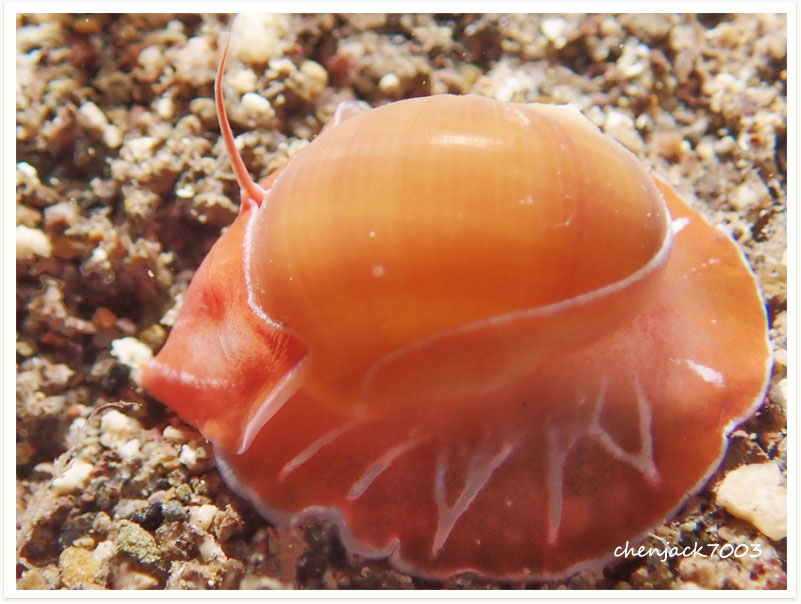
Murex ternispina (also known as Murex Nigrospinosus) is a species of sea snail, a marine gastropod mollusk in the family Muricidae, the murex snails or rock snails.
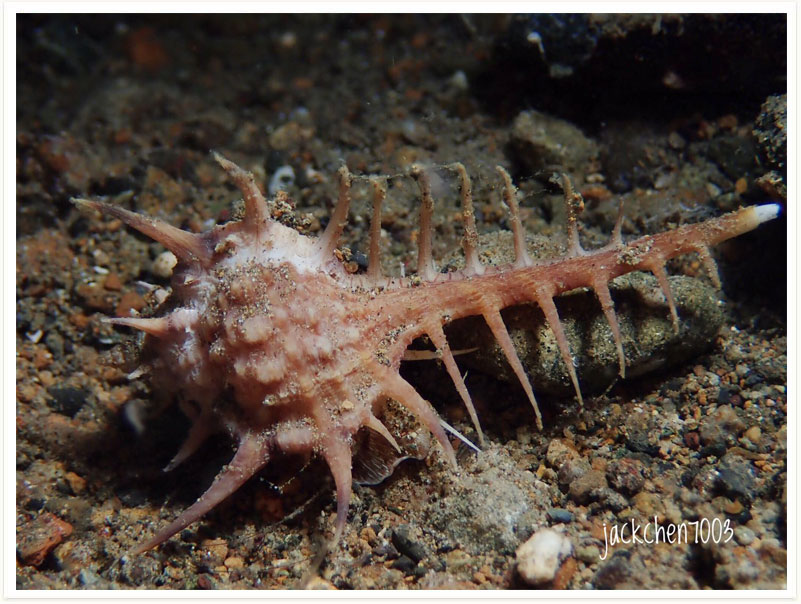
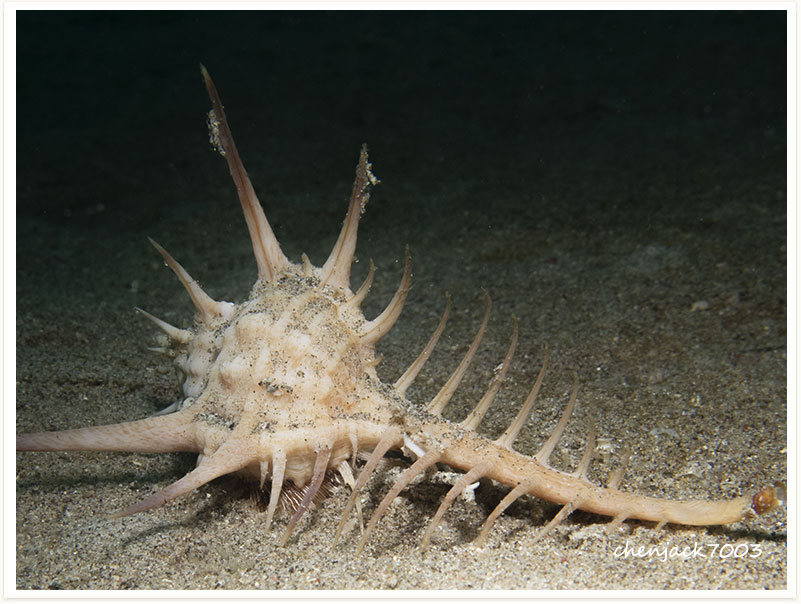
The shells of these very common cowries reach on average 35–45 millimetres (1.4–1.8 in) of length, with a minimum size of 20 millimetres (0.79 in) and a maximum size of 100 millimetres (3.9 in). The shape is usually pear-shaped, the dorsum surface is smooth and shiny and may be pale or dark brown, with several small white spots. The margins and the extremities are clearer, while the base is generally white, with a wide sinuous aperture and long labial teeth. The margins show also numerous thin vertical whitish lines. The juvenile forms have two-three clearer trasversal bands on the shell dorsum. These shells are quite similar and may be confused with the shells of Lyncina camelopardalis. In the living cowries the mantle is grey-brown and almost transparent, with long whitish tree-shaped papillae. Mantle and foot are very well developed, usually with external antennae.
The length of the shell varies between 3.5 mm and 5 mm.
This is a very small species, light violet with a white transverse band around the body whorl. The shell contains 7-8 whorls, with two smooth, acuminate ones in the protoconch. The whorls are rotund and longitudinally crassicostate. The numerous lirae are tenuous. The violet aperture is irregularly sinuate. The outer lip is incrassate and shows four teeth on the inside region. The sinus is below the suture. The sinus is wide open and moderately deep.
Haminoea is a genus of medium-sized sea snails or bubble snails, marine opisthobranch gastropod molluscs in the family Haminoeidae, the haminoea bubble snails, part of the clade Cephalaspidea, the headshield slugs and bubble snails.
Many species within this genus have green algae growing on their shells. The posterior tip of the headshield is bilobed, except in Haminoea elegans.
Echineulima asthenosomae is a species of sea snail, a marine gastropod mollusk in the family Eulimidae.
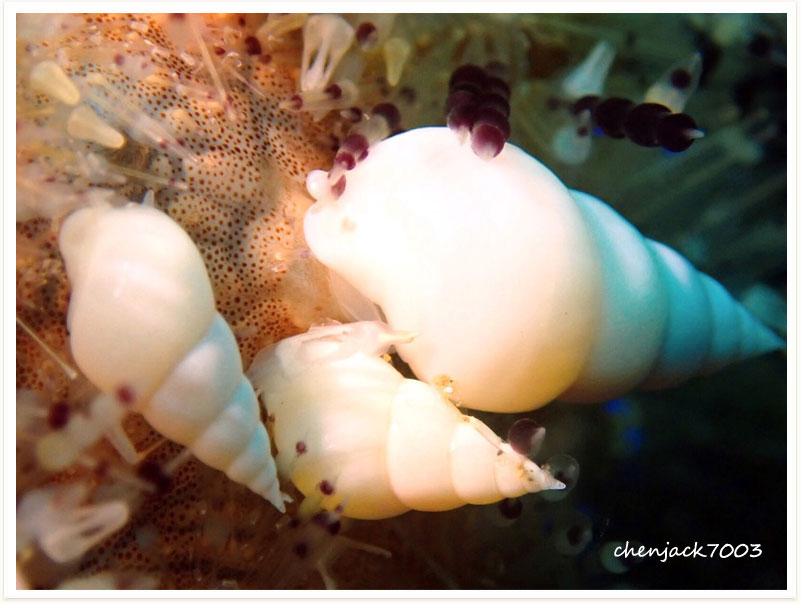
Diminovula culmen is a species of sea snail, a marine gastropod mollusk in the family Ovulidae, the ovulids, cowry allies or false cowries.
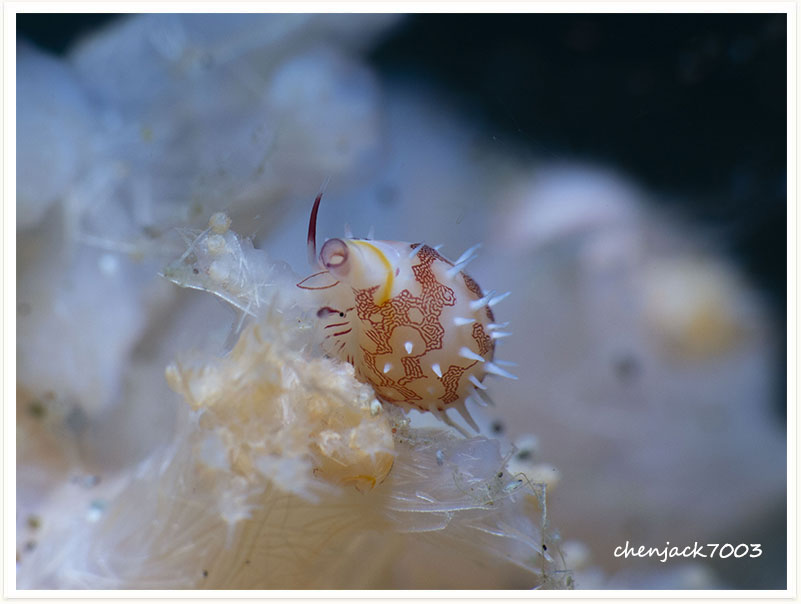
Cystiscus minutissimus is a species of snail from the Cystiscidae family. The scientific name of the species was first validly published in 1876 by Tenison-Woods.
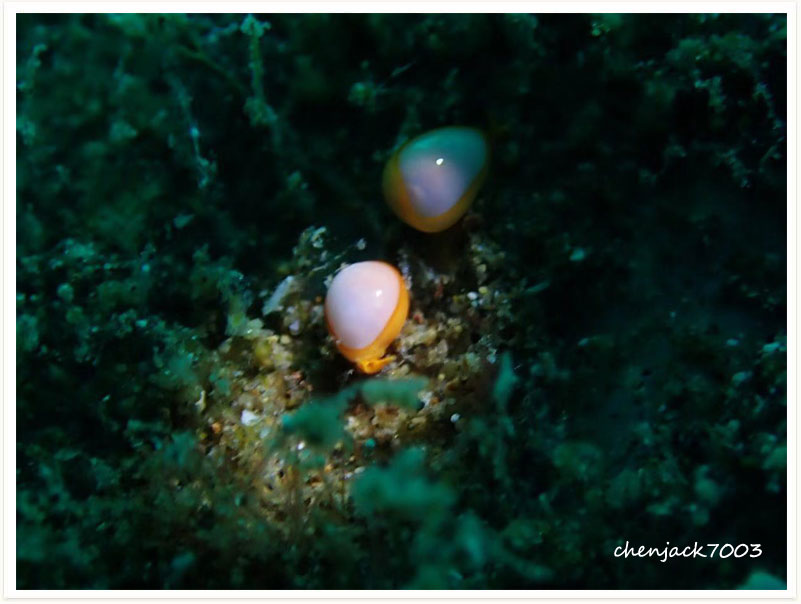
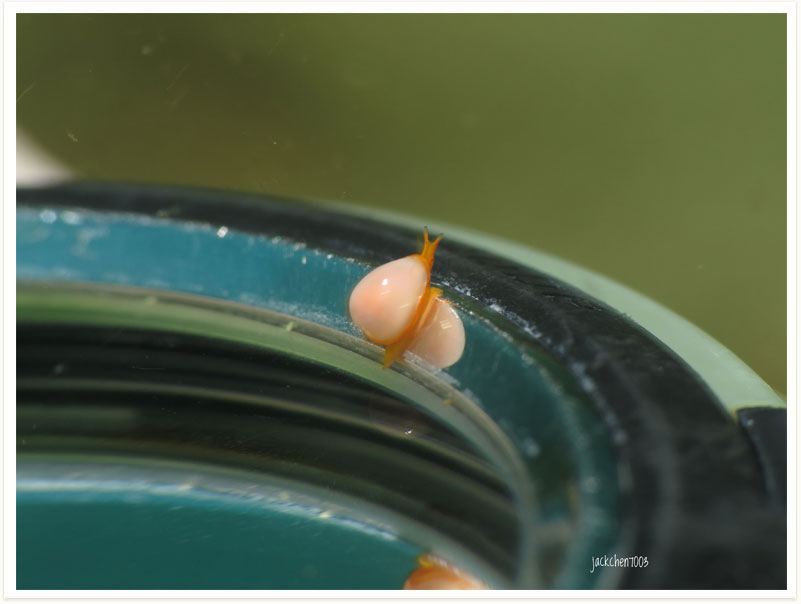

Zenopontonia is a genus of shrimp from the family Palaemonidae and which includes species that often live in symbiosis with larger animals.
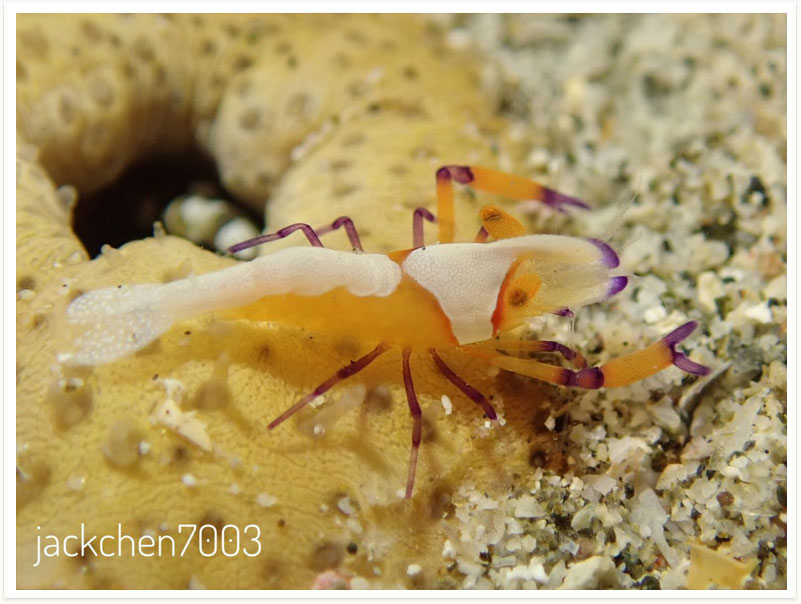
unknow
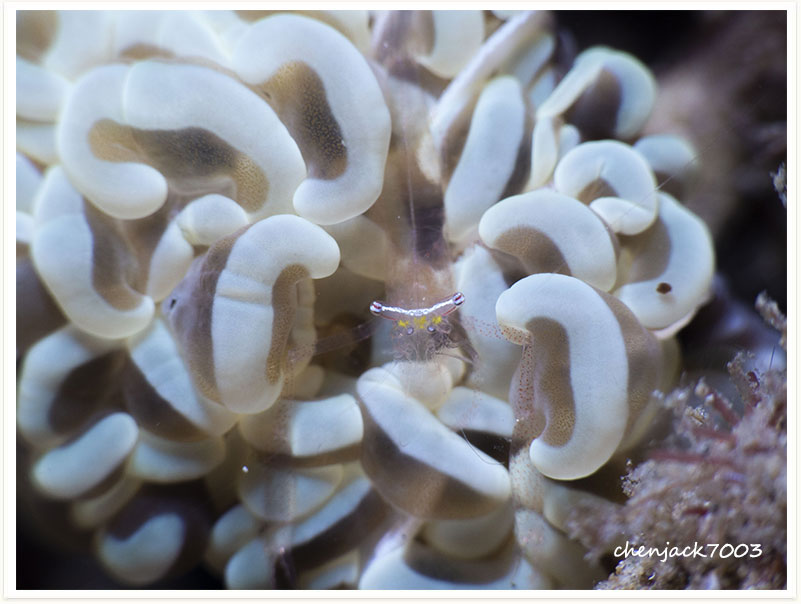
Thor amboinensis is a small shrimp growing to a length of about 13 millimetres (0.5 in). It is an olive brown colour with symmetrically placed white patches edged with thin blue lines. It characteristically carries its abdomen curved upwards with its tail fan above its head.
Synalpheus is a genus of snapping shrimp of the family Alpheidae, presently containing more than 100 species; new ones are described on a regular basis, and the exact number even of described species is disputed.

Stenopus hispidus reaches a total length of 60 millimetres (2.4 in), and has striking colouration. The ground colour is transparent, but the carapace, abdomen and the large third pereiopod are all banded red and white.The antennae and other pereiopods are white. The abdomen, carapace and third pereiopods are covered in spines.
Crustaceous species is Stegopontonia commensalis . It was first described by Giuseppe Nobili in 1906. Stegopontonia commensalis belongs to the genus Stegopontonia in the family Palaemonidae. So far no one was able to send in the perfect solution, which is not strange.
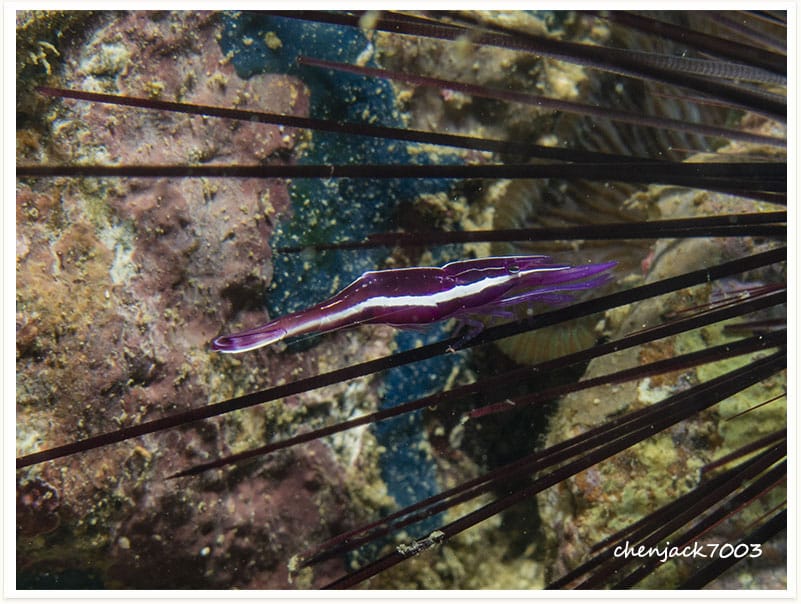
Pontonides ankeri is a shrimp species from the Palaemonidae family. The scientific name of the species was first validly published in 2007 by Marin.
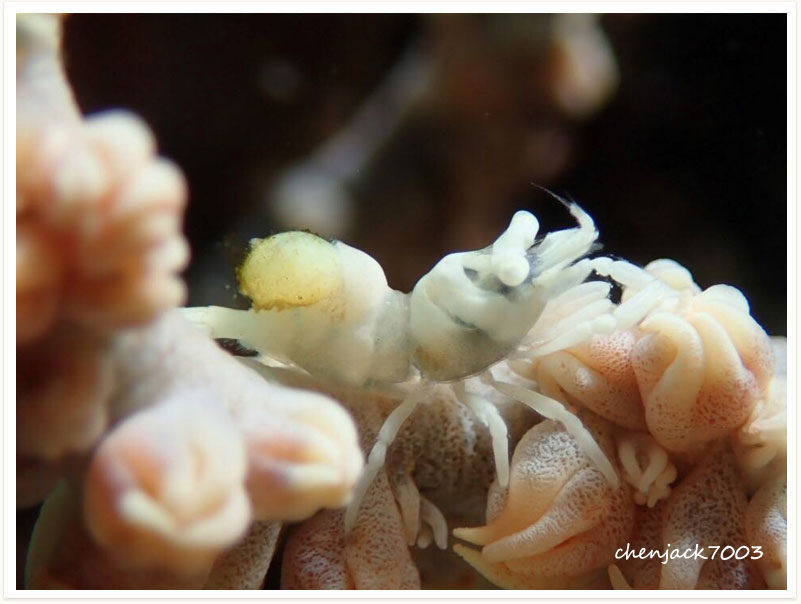
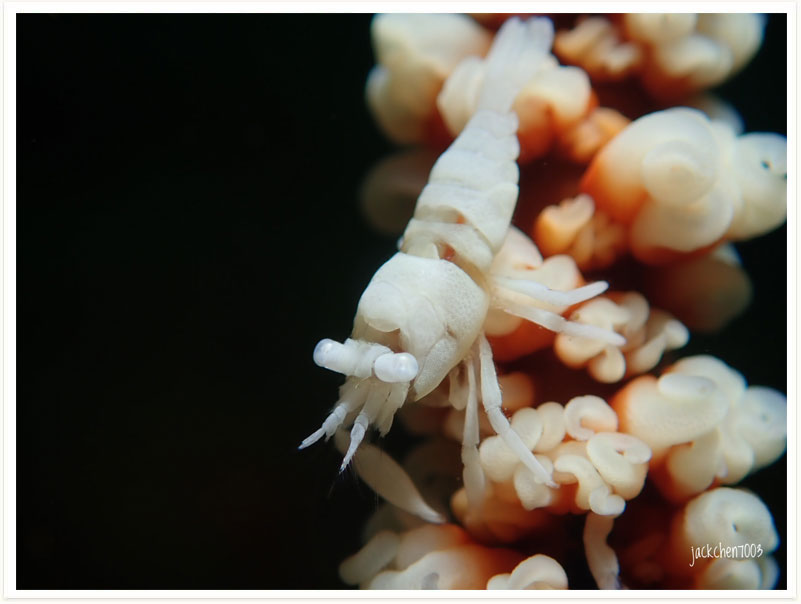
Phyllognathia ceratophthalma is a shrimp species from the Hymenoceridae family. The scientific name of the species was first validly published in 1913 by Balss.
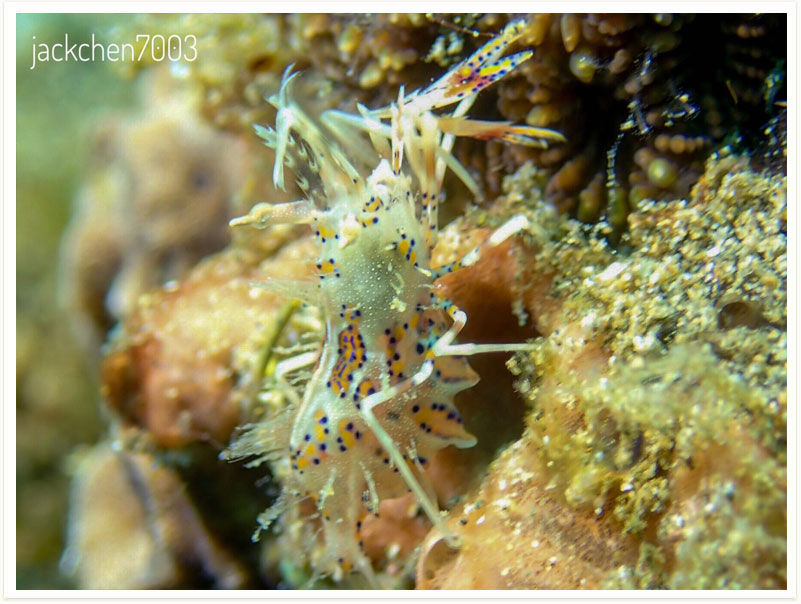
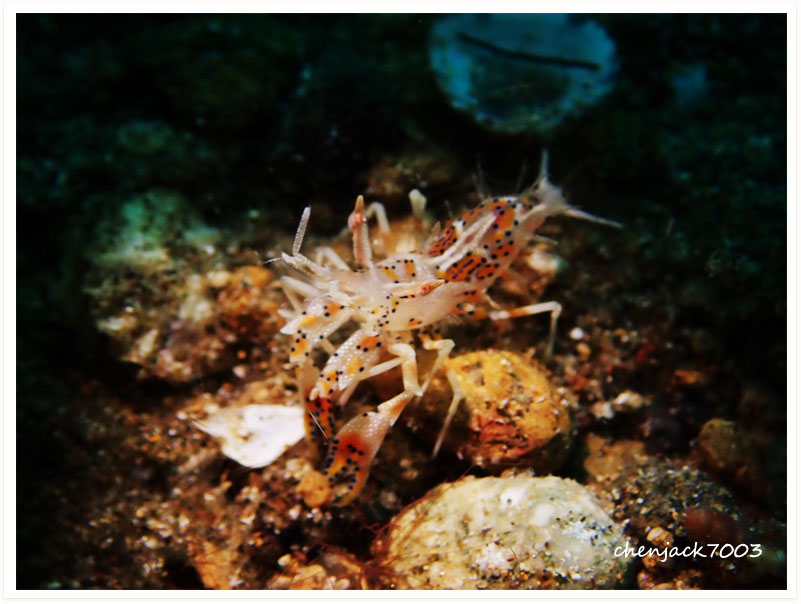
Periclimenes affinis is a species of shrimp found in the Pacific and Indian Oceans.It was first named by Leo Zehntner in 1894.
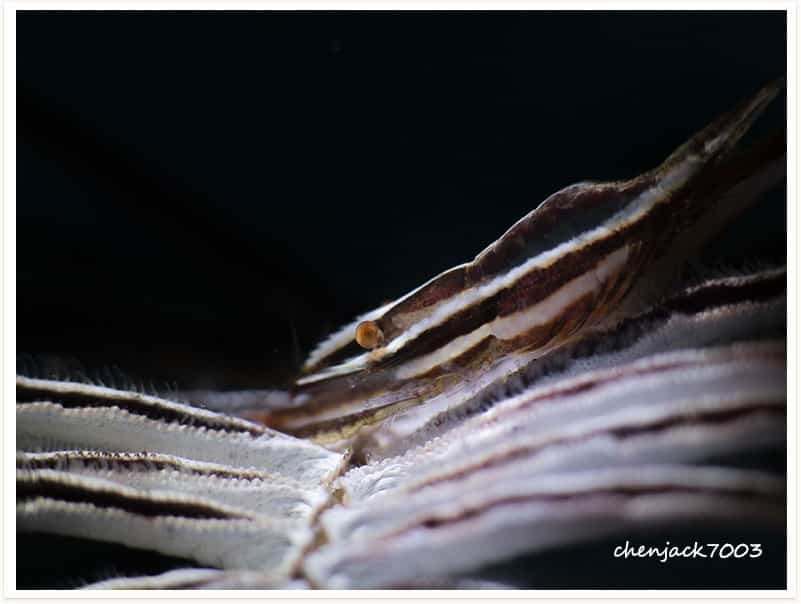
Laomenes pardus is a shrimp species from the Palaemonidae family. The scientific name of the species was first validly published in 2009 by Marin.
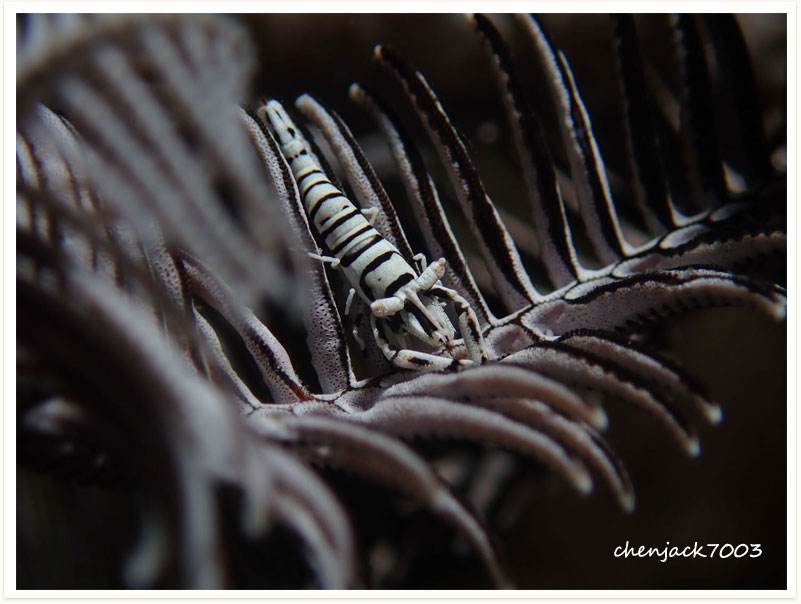
Hippolyte commensalis is a shrimp species from the Hippolytidae family. The scientific name of the species was first validly published in 1925 by Kemp.
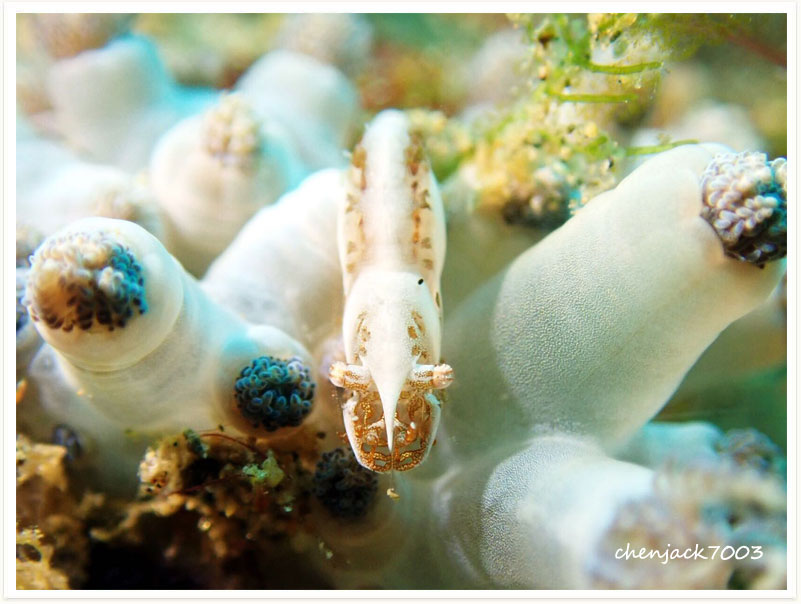
Marin, I. (2012). The “Hamopontonia corallicola” Bruce, 1970 species complex (Crustacea, Decapoda, Palaemonidae): new records and new species from the Great Barrier Reef, Australia. Zootaxa. 3272: 35-56.
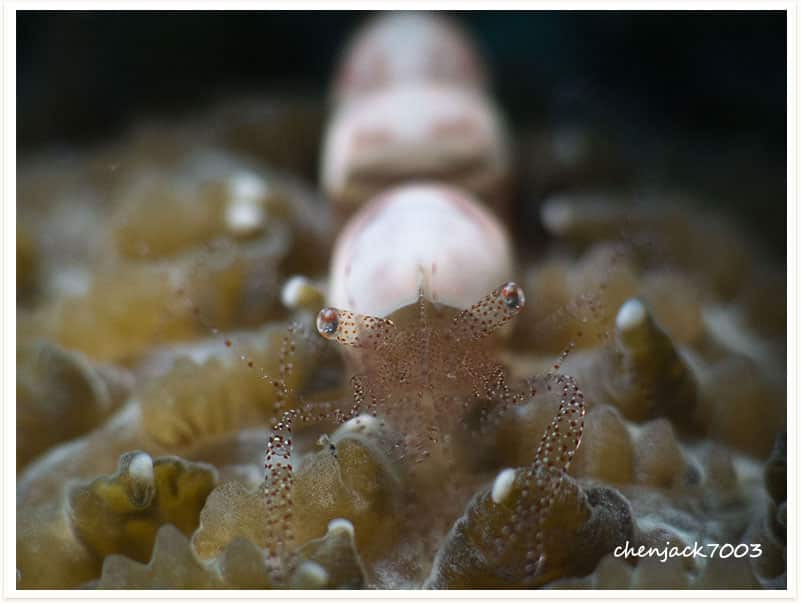
Gelastocaris paronae is a shrimp species from the Hippolytidae family. The scientific name of the species was first validly published in 1905 by Nobili.
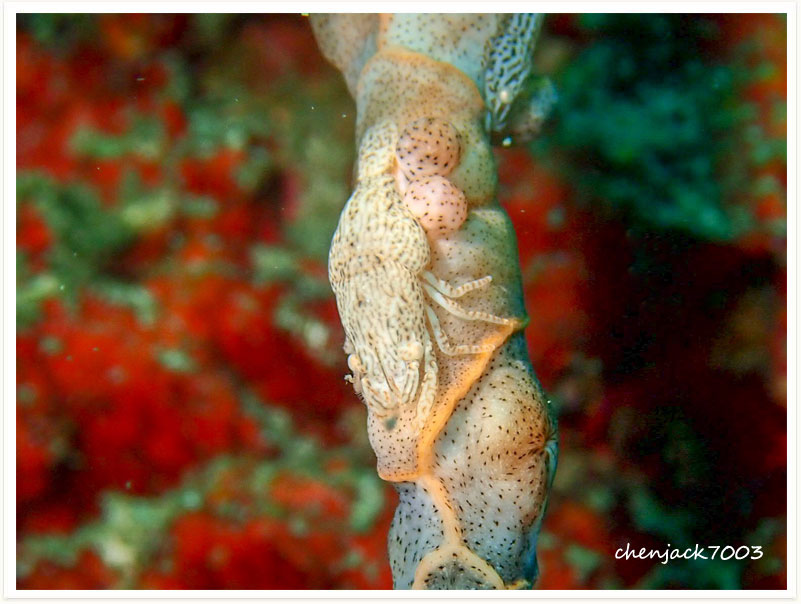
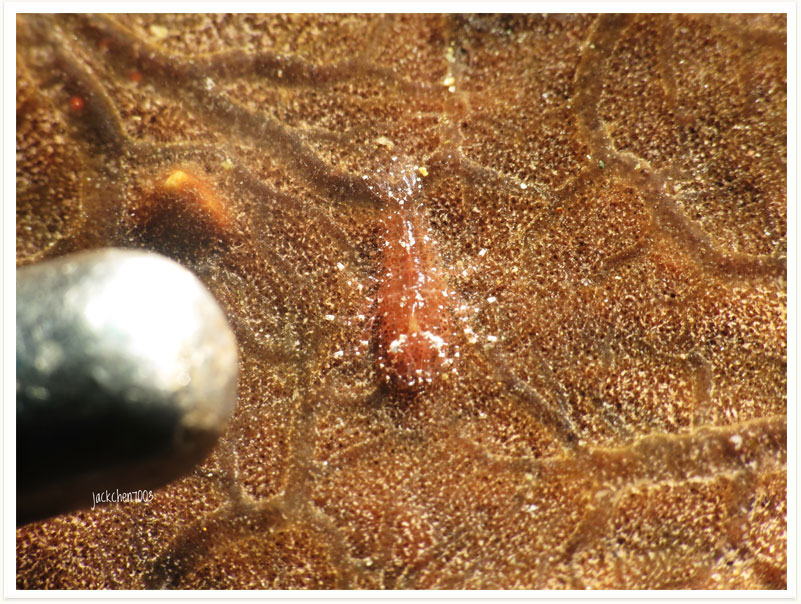
unknow
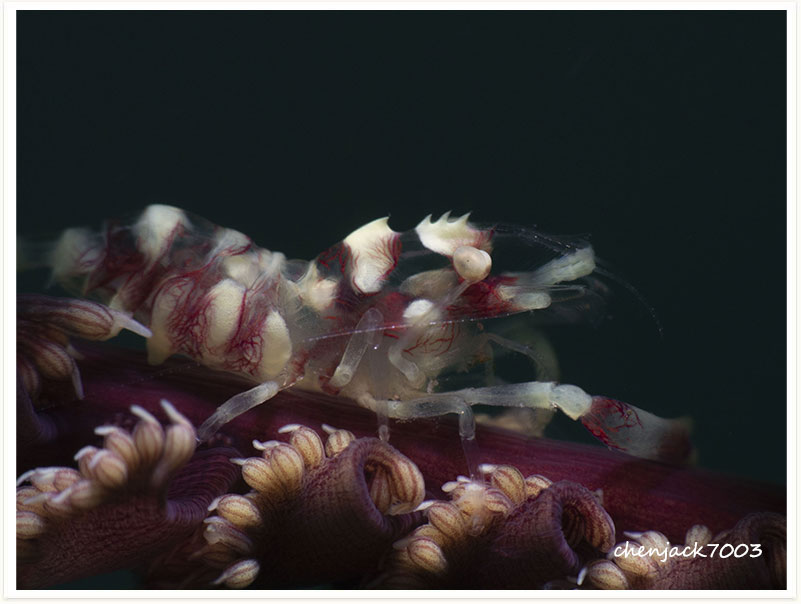
Also known as Anemone Shrimp, Carid Shrimps, Commensal Shrimps, Crown Shrimp, Ghost Shrimp, Heliofungia Shrimp, Mushroom Coral Shrimp, Partner Shrimp, Plate Coral Shrimp, Plumed Shrimp, Popcorn Anemone Shrimp.
Found on coral and rocky reefs living in a symbiotic relationship with various anemones and mushroom corals. They feed on algae, parasites and plankton. Body transparent, red to black with a white spiny head (that looks like a dollop of cream) Length 4cm Depth – 3-30m Widespread Western Central Pacific
Araiopontonia odontorhyncha is a shrimp species from the Palaemonidae family. The scientific name of the species was first validly published in 1970 by Fujino & Miyake.
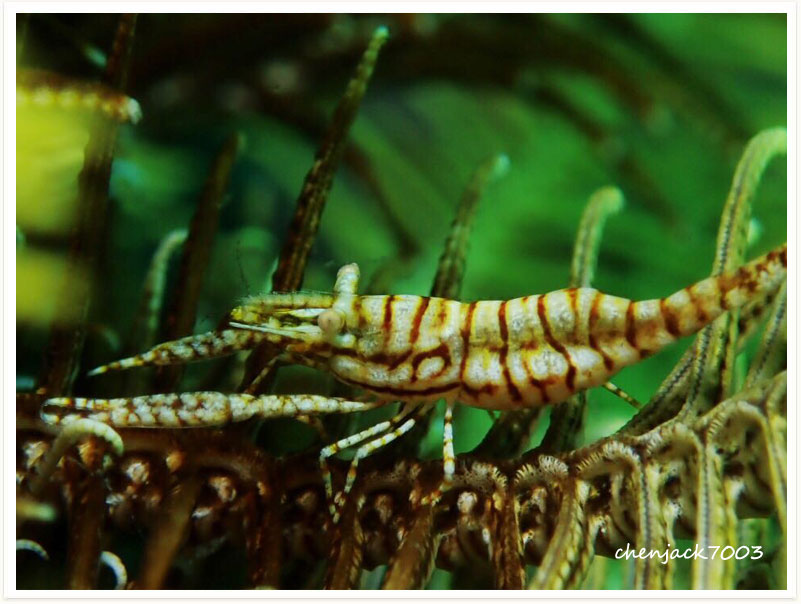
Ancylomenes magnificus, is a kind of cleaner shrimp common to the Western Pacific Ocean at depths of 3–29 metres (10–95 ft).
These shrimp are commonly found on scleractinian coral, Catalaphyllia and the anemone, Dofleinia armata. They have a transparent body except on the carapace and segments of the abdomen which have bands of white specks outlined in red. The tail and the hump on the abdomen are also white.
Periclimenes brevicarpalis can reach a length of 0.5 to 1.0 inch. The body is almost transparent, with some white spots over carapace and tail and orange spots outlined in black over the caudal fin. Females are larger than males and have more white spots. This species lives symbiotically with sea anemones, corals and jelly fish.
Collector urchins are dark in color, usually bluish-purple with white spines. The pedicles are also white, with a dark or black base. Individuals found at Green Island had orange-tipped spines. The spines of some specimens are wholly orange, while those of others are only orange-tipped or completely white. This color disappears when the individual dies or is taken out of the ocean, and is difficult to preserve. Collector urchins reach 10 to 15 centimetres (4 to 6 in) in size. Debris tends to “collect” on these urchins, hence their name.
Flower urchins are relatively large sea urchins. They can reach a maximum diameter of around 15 to 20 cm (6 to 8 in). Like most echinoderms, the body of adult flower urchins is equally divided into identical segments around a central axis in multiples of five (pentaradial symmetry). The rigid “shell” (test) has five interambulacral segments separated from each other by five ambulacral segments, each of them are composed of smaller regularly interlocking plates. It is overlaid by a thin layer of skin in living individuals. The test is variegated in coloration, usually deep red and grey, though there are rare instances of green and pale purple.Each ambulacral segment is ornamented by a large purple zigzag pattern running along its length.
It is a small regular sea urchin of almost spherical shape, whose diameter of the shell (called “test”) can go up to 5 cm1. The quills (“radioles”) are fine and fairly short, not exceeding 2 cm, densely arranged and ringed in black or brown with the white tip. These radioles are arranged in five times two well delimited bands (called “ambulacraires”), all the quills of each band being as “brushed” in the same direction. These bands alternate with ten other bands without spines (perradial and interradial bands), most often brightly colored deep blue (most often Duck blue, Klein blue, royal blue or verdigris, but sometimes also almost greenish black), and whose appearance is reminiscent of velvet. It is in fact a carpet of small denticulate globiferous pedicellars.
Maretia planulata is a sea urchin from the Maretiidae family.
The scientific name of the species was published in 1816 by Jean-Baptiste de Lamarck.
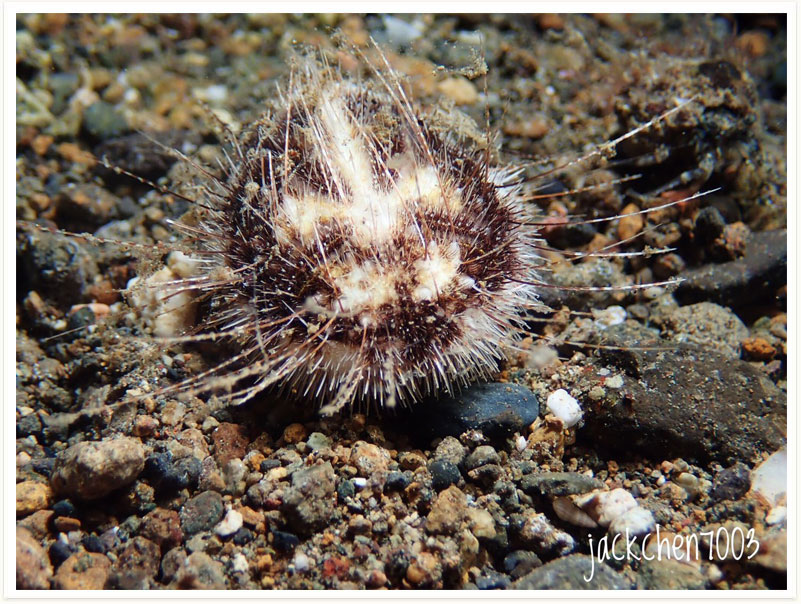
Eucidaris thouarsii, the slate pencil urchin, is a species of cidaroid sea urchins that inhabits littoral regions of the East Pacific Ocean.
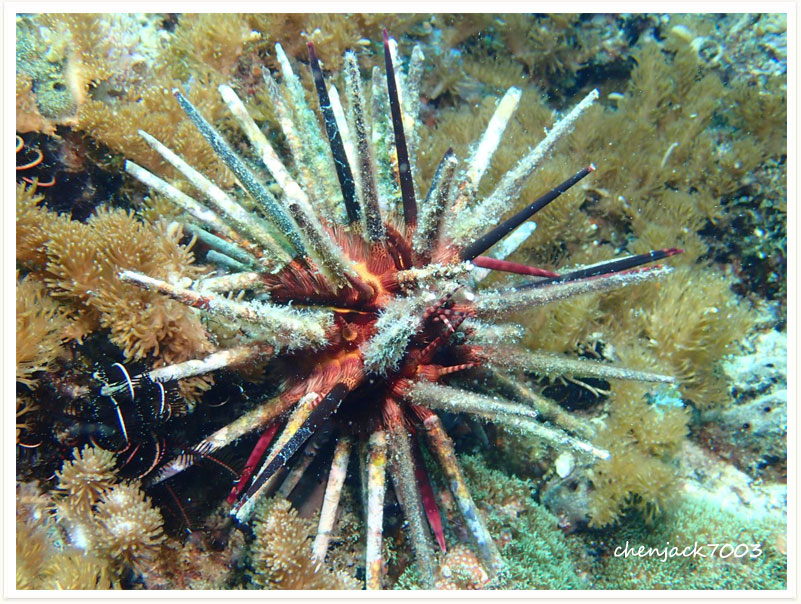
The Banded sea urchin has a slightly oval test (shell), reaching a diameter of about 5 cm. Like almost all the Diadematidae (but it is in Echinothrix calamaris that it is most obvious) it has two different sets of spines, shorter and slender closed spines which are going from yellow to dark (through brown) in colour and can deliver a nasty sting, and longer and thicker spines that are often banded with light and dark colour (but sometimes all dark or all white), and reaching 10 to 15 cm in length. These radiolas can be blunt, and are hollow. The spines are grouped so as to let appear five naked zones on the central part of the test, in a star pattern (called “iridophores”): this pattern can be colored, often in blue. The anal papilla is big, more or less translucent and very obvious on the aborale face; it is generally whitish and speckled with black and white dots, circled by a ring of visual receptors that grant it a rudimentary vision.
As a member of the class Echinoidea, the anatomy of Diadema setosum is that of a typical sea urchin. All of the animal’s internal organs are enclosed within the spherical, black test that is essentially the body of the organism. However, the body is not perfectly spherical – Diadema tests are slightly dorso-ventrally compressed. Protruding outwards from the central body are the long spines iconic of a sea urchin’s appearance. Like the other members of the family Diadematidae, the spines of D. setosum are extremely long and narrow in proportion to its body. The spines, often black but sometimes brown-banded, are hollow and contain a mild venom. D. setosum can be distinguished from other species in the genus Diadema by the presence of five white spots on the animal’s test, strategically located between the urchin’s ambulacral grooves.
Pterelectroma physoides, commonly known as The Zebra Wingshell, can be found attached to various marine growths, and including whip corals, hydroids, black corals and bryozoans. Pterelectroma physoides which exhibits protective coloration for lifing on alcyonarian.
Few cm in size. White background with brown lines, hence its zebra’name. This shell may easily be overlooked.
Pearsonothuria graeffei is a roughly cylindrical, thin-walled sea cucumber that grows to about 30 centimetres (12 in) in length. Its mouth, at one end, is surrounded by a ring of up to 24 leaf-like, paddle-shaped tentacles with black stalks which are black on the upper side and white beneath. The anus is at the other end of the body and there are several rows of tube feet along the underside. The colour of the adults is pale brown and white, with black speckles and small thorn-like protuberances.
Phyllophoridae is a family of sea cucumbers, marine invertebrates with elongated bodies, leathery skins and feeding tentacles.
Members of the family are characterised by a complex ring of calcareous ossicles arranged in a tube, making a mosaic pattern. The tentacles number ten to twenty-five. Some members have spindle-shaped bodies whilst others are buried in the substrate and adopt a U-shaped form.
The mantle is a translucent pink, the mantle margin is cream-white with reddish purple spots.The gills and rhinophores are orange-reddish.A white band on the mantle splits behind the rhinophores and encircled the gills.
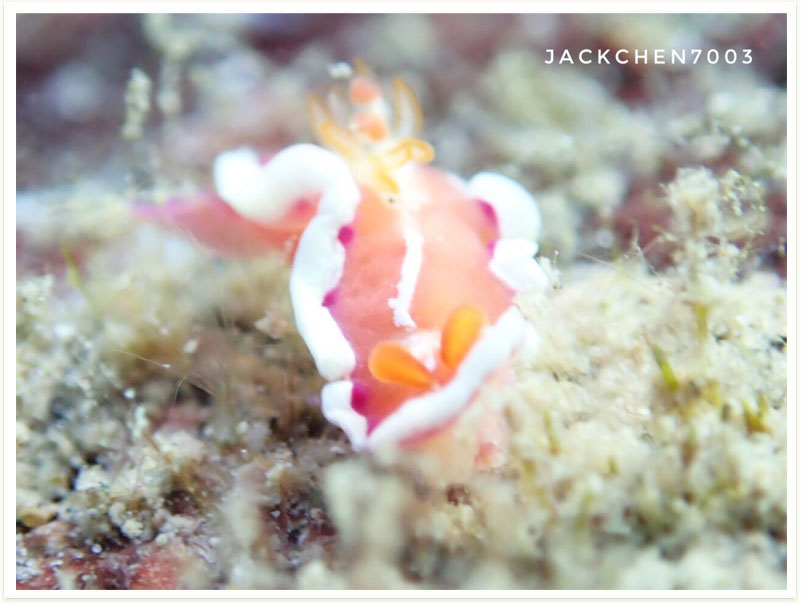
Stiliger is a genus of small and minute sacoglossan or sap-sucking sea slugs. They are marine gastropod mollusks in the family Limapontiidae.
They somewhat resemble nudibranchs, but are not closely related to them. They are a rich green in color, caused by the green algae they eat.
Tritonia nilsodhneri feed on the gorgonian Eunicella verrucosa, Eunicella stricta and Swiftia pallida.

Thorunna furtiva is a species of sea slug, a dorid nudibranch, a shell-less marine gastropod mollusk in the family Chromodorididae. It is the type species of the genus Thorunna.
This species was described from Camiguin, Luzon, the Philippines. It has been reported throughout the western tropical Indo-Pacific Ocean.
This species feeds on Bryozoan (Moss animals).Thecacera picta lives on sand and rubble bottom.There are several color variations and various patterns of this nudibranch.
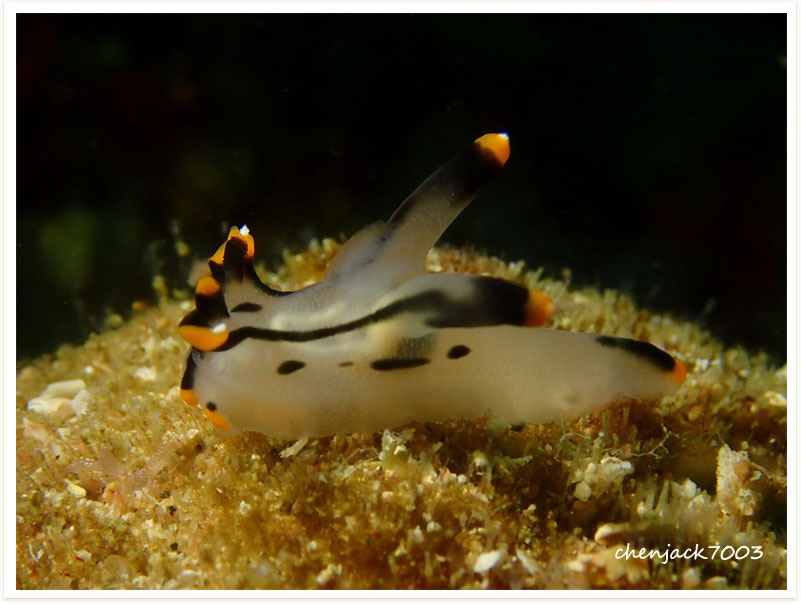
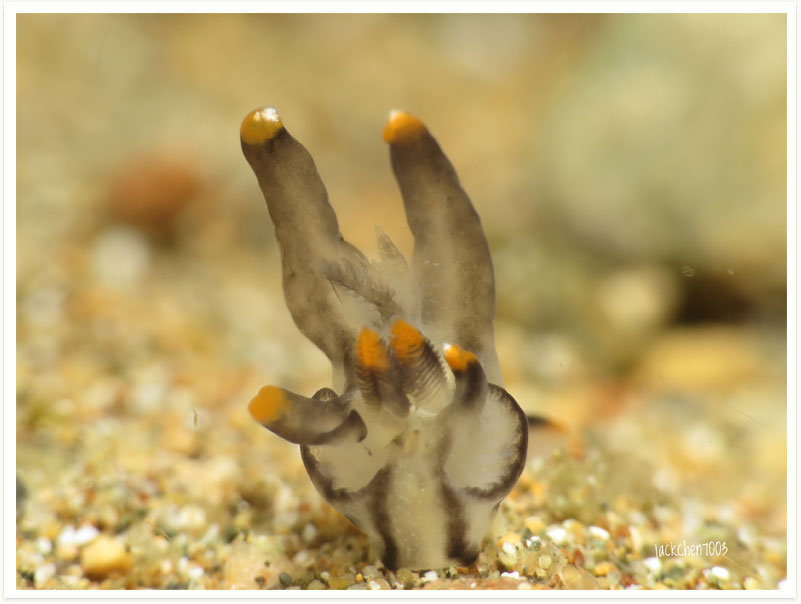
Sebadoris nubilosa is a species of sea slug, a dorid nudibranch, shell-less marine gastropod mollusks in the family Discodorididae.
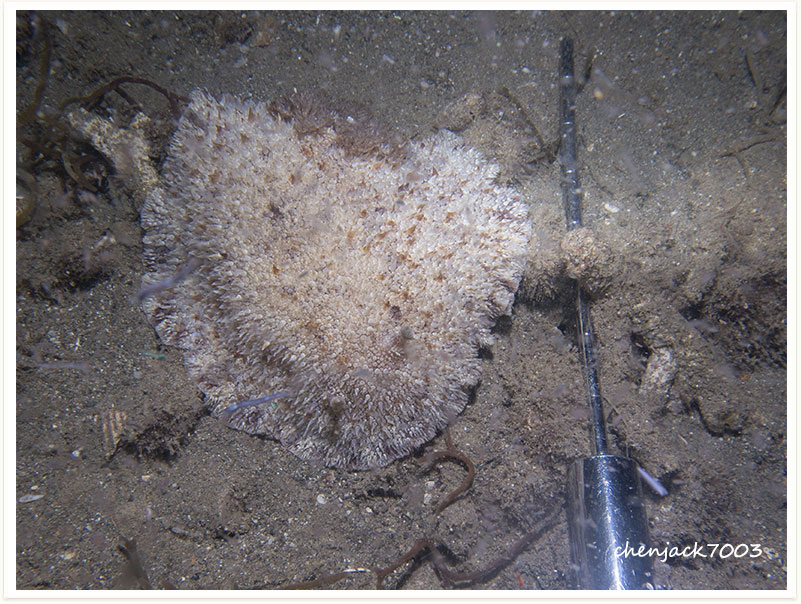
Samla bicolor can grow to a maximum length of 20 mm and has a translucent body and white tips to the oral tentacles. There is an orange band near the tip of the rhinophores and on each of the cerata. Animals from different regions show subtle differences in coloration and in the shape of the oral tentacles and may be members of a species complex.
Feed on the Sponge Dysidea cf herbacea.
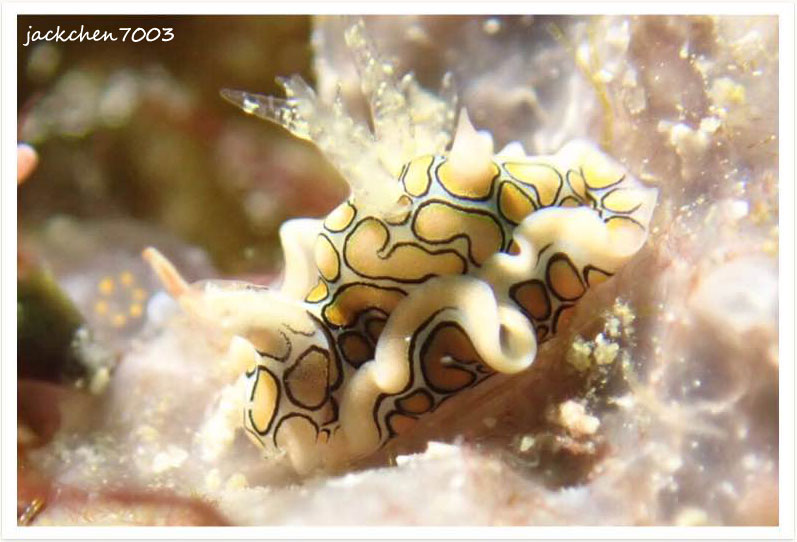
Sagaminopteron nigropunctatum is een slakkensoort uit de familie van de Gastropteridae. De wetenschappelijke naam van de soort is voor het eerst geldig gepubliceerd in 1973
door Carlson & Hoff.
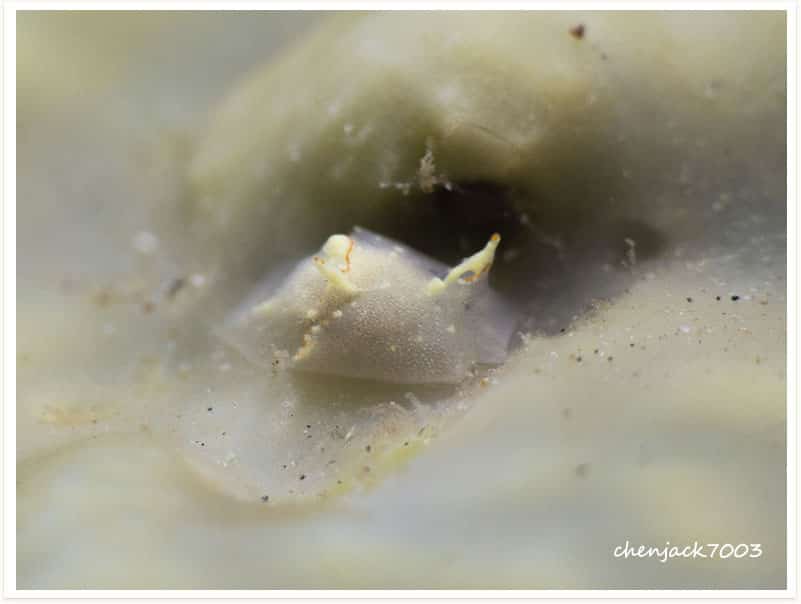
Reticulidia fungiayellow is black ,white and yellow in clolour.This species feeds on sponges.Similar is R.halgerda.
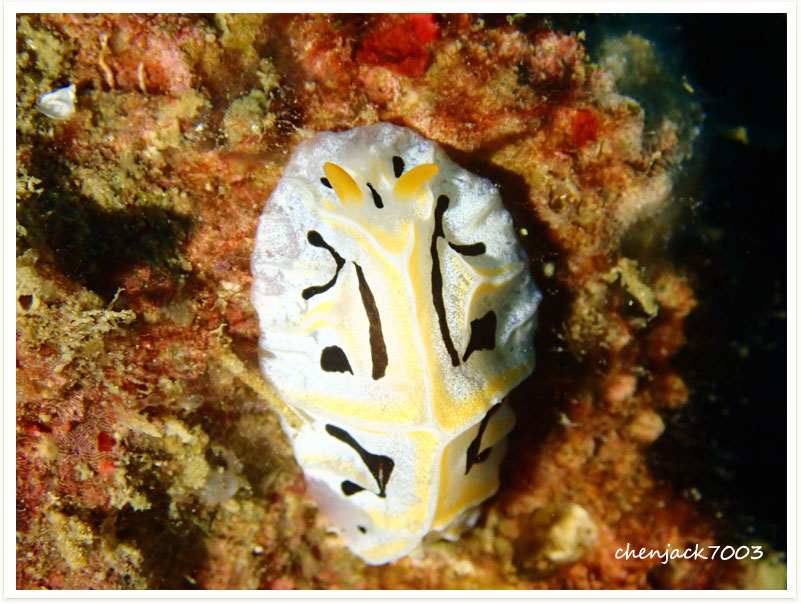
Sea slug genus Phyllodesmium are predatory sea slugs and feeding on octocorals.They are perfect mimics octocorals.
Phyllodesmium tuberculatum is a “solar-powered sea slug” (use the zooxanthellae of their prey).
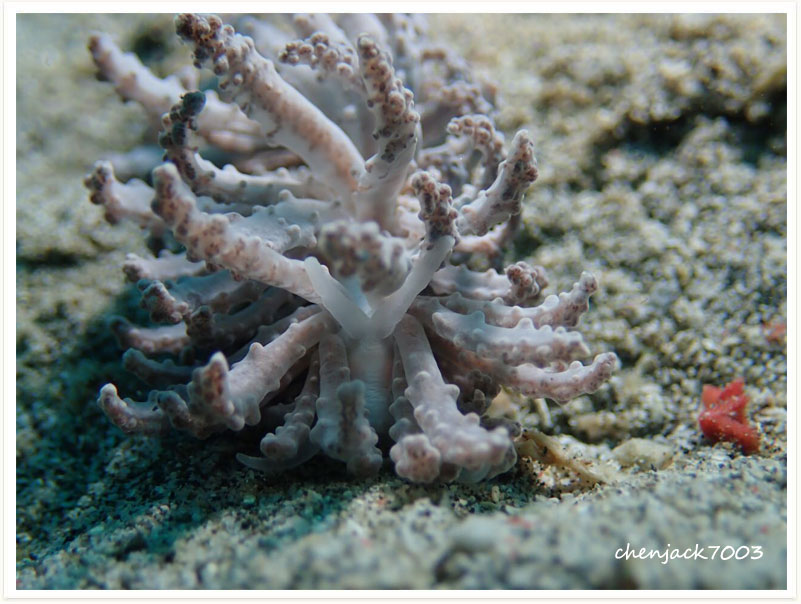
unknow
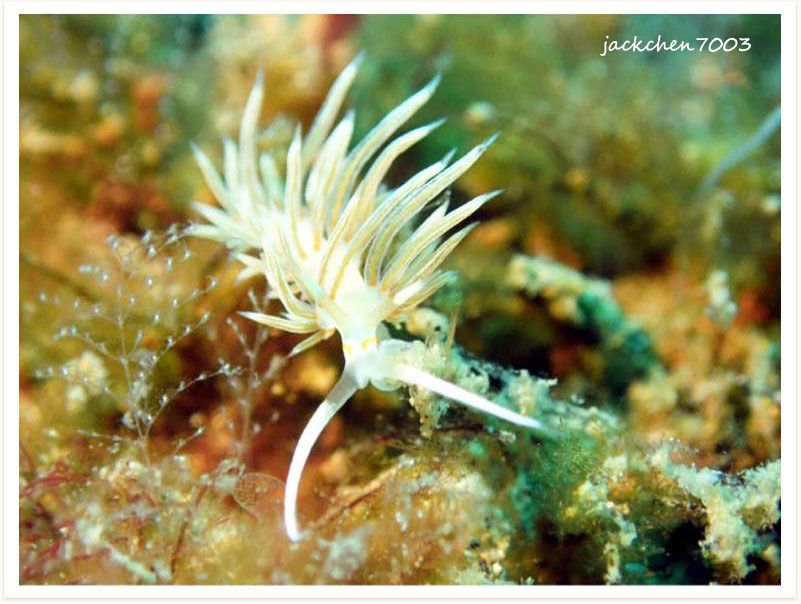
Phyllodesmium lembehense is a species of sea slug, an aeolid nudibranch, a marine gastropod mollusc in the family Facelinidae.

Species of the genus Phyllodesmium are predators,carnivorous and feeds on octocorals.
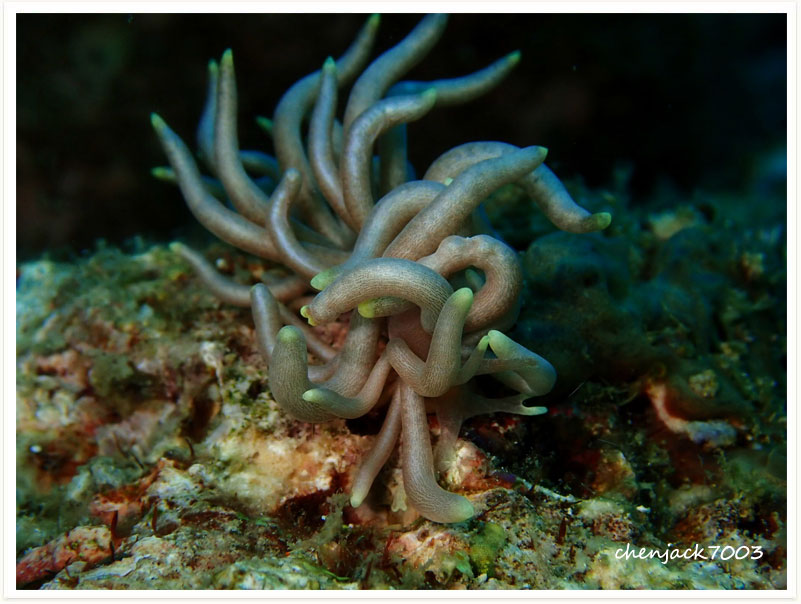
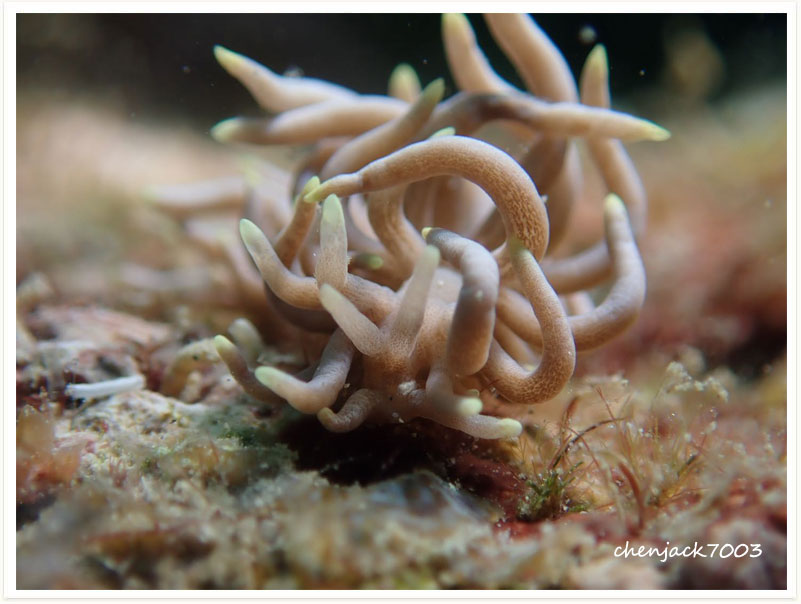
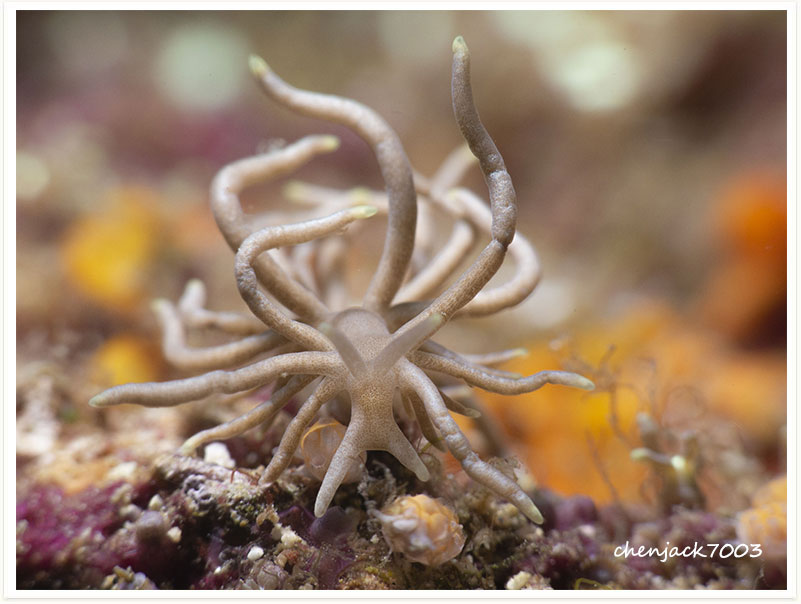
Although this nudibranch changes appearance as it grows, three median clusters of (usually) pink tubercles remain the same, except that they are amalgamated in juveniles and separated in large animals. These tubercles can range in color from pink to green to white. The intensity of the pink coloration and green-grey tones may possibly be related to diet, and the length of time since last feeding. Other distinguishing features are the pale pink edge of the mantle, the broad, triangular, black tipped oral tentacles and the rhinophoral clavus possessing 22 to 26 lamellae (in specimens greater than 35 mm).
This nudibranch has a black dorsum with tall white-capped tubercles with pink or grey bases. These tubercles are in groups of 2-4 on the middle of the back, with smaller, single tubercles towards the edge of the mantle. The rhinophores are black.
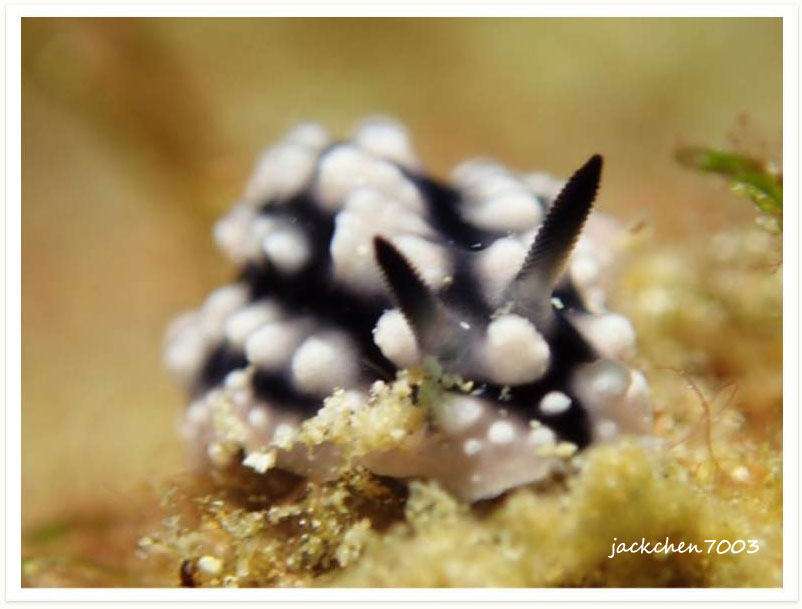
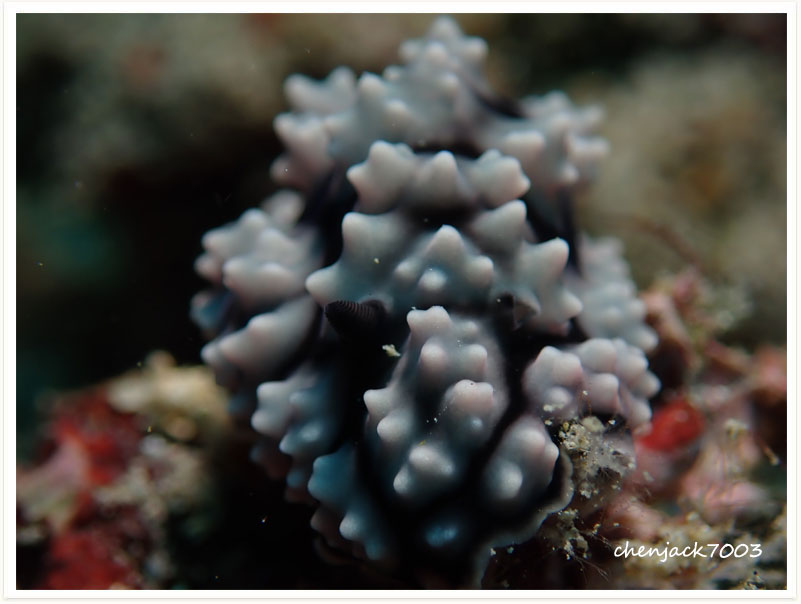
This animal can measure up to 35 mm in length. It has been confused with Phyllidia japonica, Phyllidia multituberculata and Phyllidia undula and a number of other species by most workers.This nudibranch has an orange-brown dorsum interrupted by large white or grey, compound, stalked tubercles. These tubercles are distributed along a line from between the rhinophores to the tail, with more scattered and mostly smaller tubercles towards the mantle edge. There are four black rings surrounding tubercles which are placed symmetrically in the middle region of the back. Large individuals may have two more black patches towards the tail, or two more tubercles surrounded by black rings. A single tubercle in front of the rhinophores is also surrounded by a black ring. The rhinophores are orange-yellow.
Phyllidia elegans is characterized by the pale bluish granular background colour and black swirls on the mantle, and by yellowish-orange spots.
Phyllidia elegans is known from Indonesia, Malaysia, Thailand, the Andaman Sea, Myanmar, the Red Sea, the Mariana Islands, north Sulawesi, Vanuatu and Papua New Guinea.
The backround colur is a cream to light yellow or a pale white, with yellow tubercles in the mittle of the mantle.Rhinophores are yellow.
This species feeds on the yellow sponge Acanthella stipata.
Very similar species are Phyllidia willani and Phyllidia exquisita
Miamira sinuata is a colorful sea slug.Its highly variable in color, from green, yellow, gray, pink to brown, with yellow to pink spots, blue lines, which then form a reticular pattern.This species only feeds on sponges.
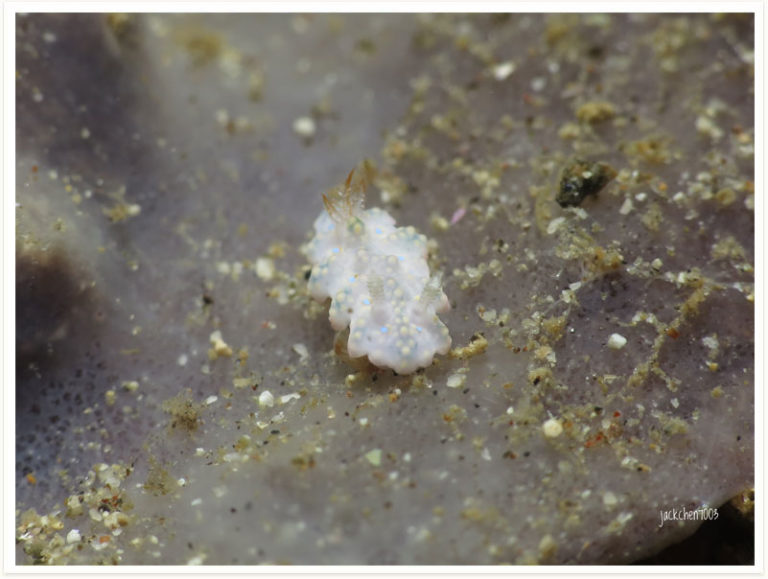
Miamira alleni looks like a xeniid soft coral. It is very well camouflaged.This nudibranch probably feeds on sponges, like other Miamira species.Miamira alleni lives in shallow water and reefs.
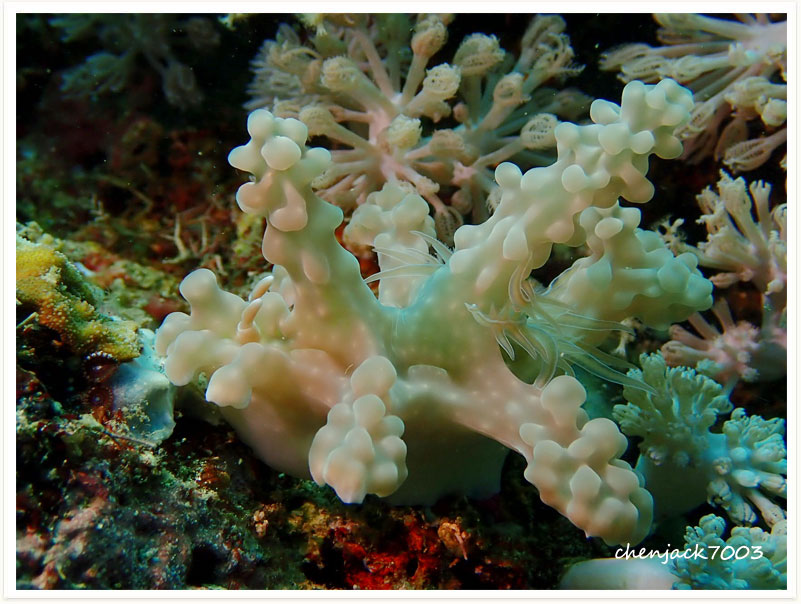
The back ground colour is white.Tubercles,Rhinophres and gills are purple tiped.The mantle margin is purple or orange in colour. Mexichromis multituberculata feeds exclusively on sponges.
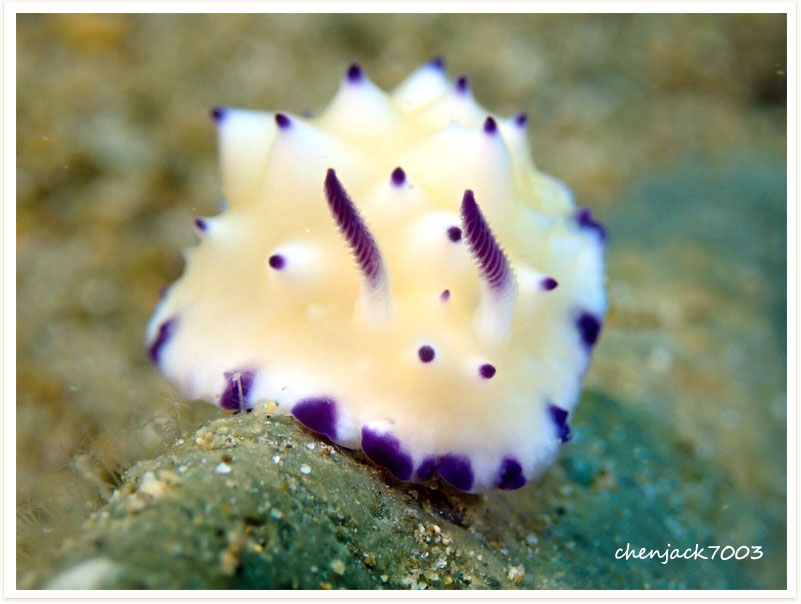
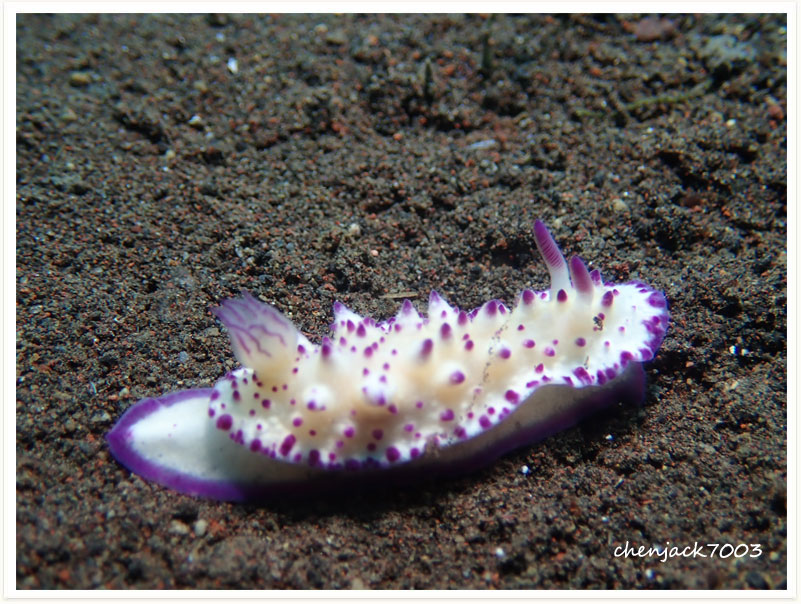
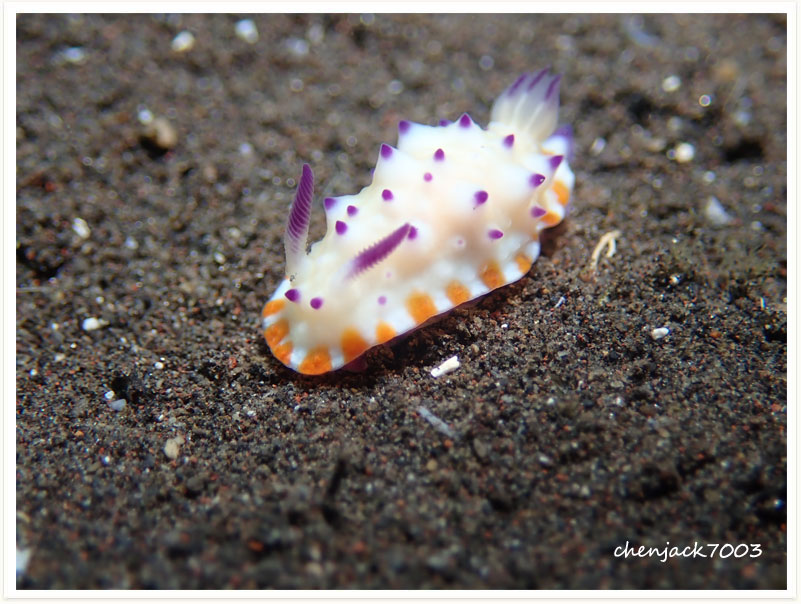
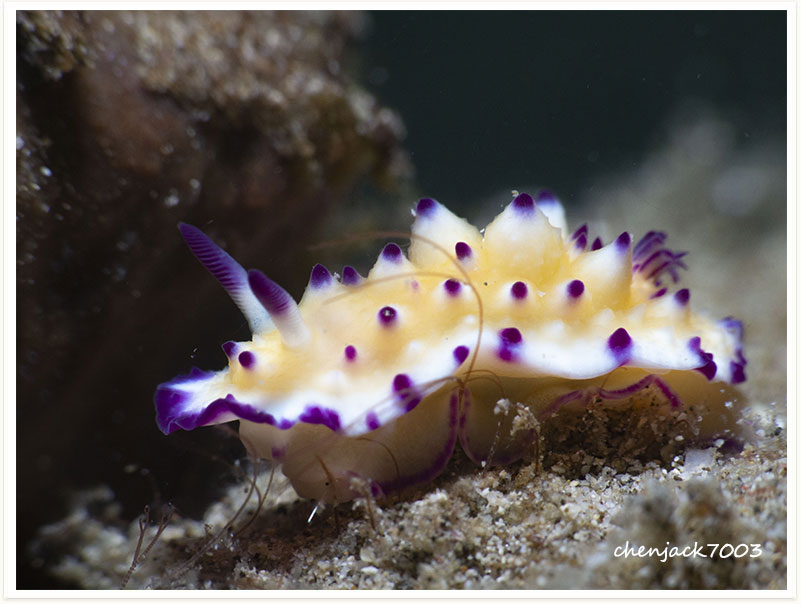
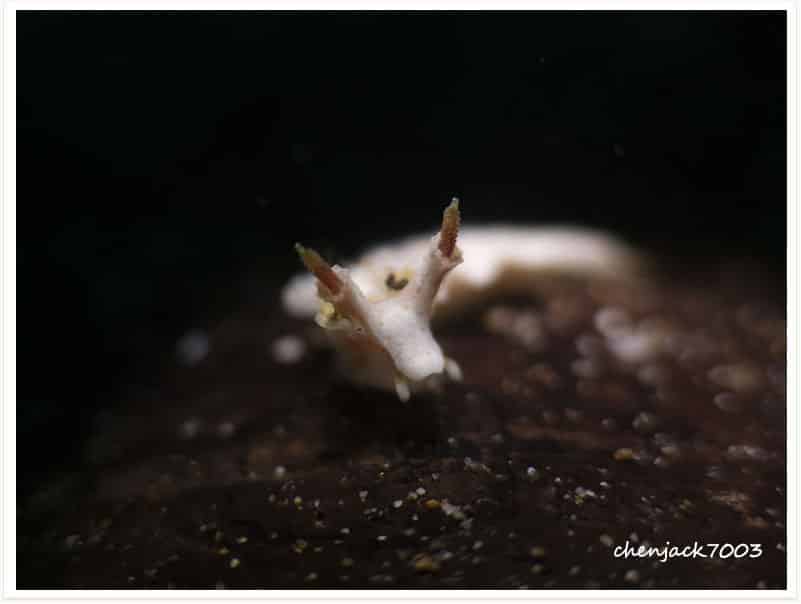
Jorunna funebris, common name the dotted nudibranch, is a large species of sea slug, a dorid nudibranch, a shell-less marinegastropodmollusc in the family Discodorididae.
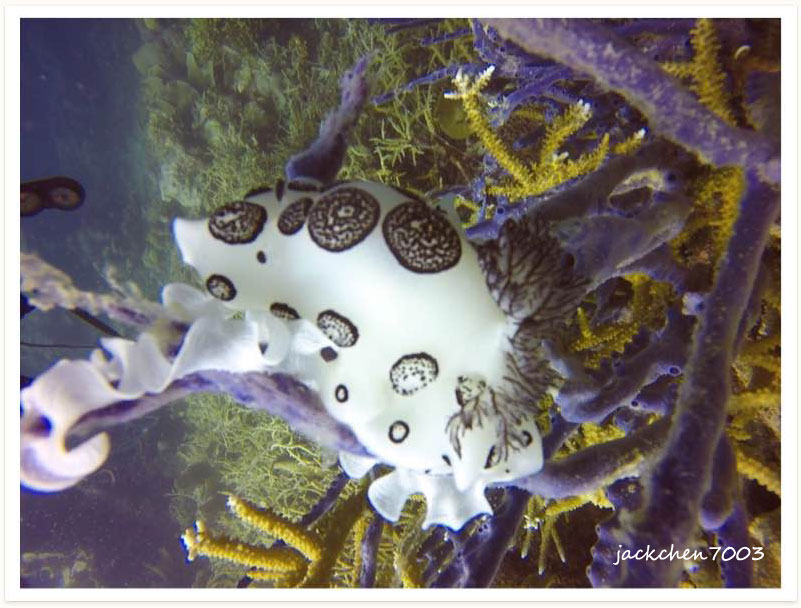
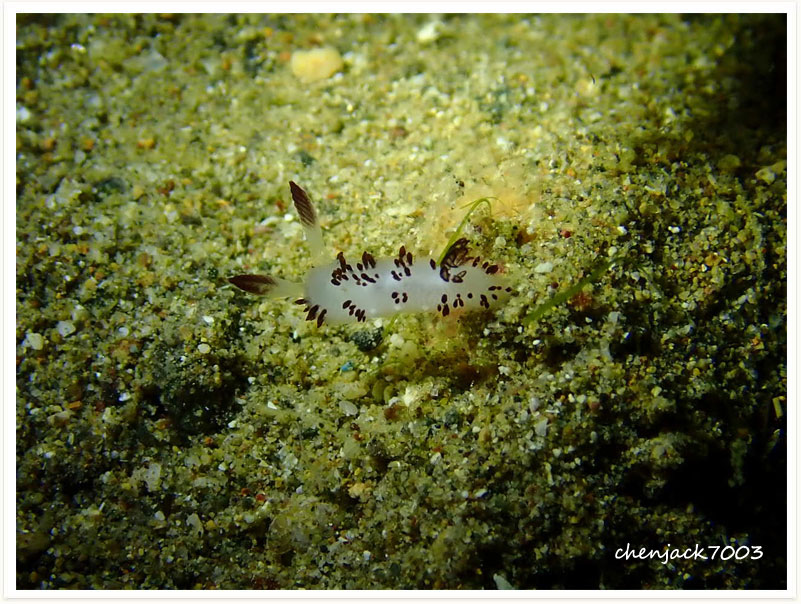
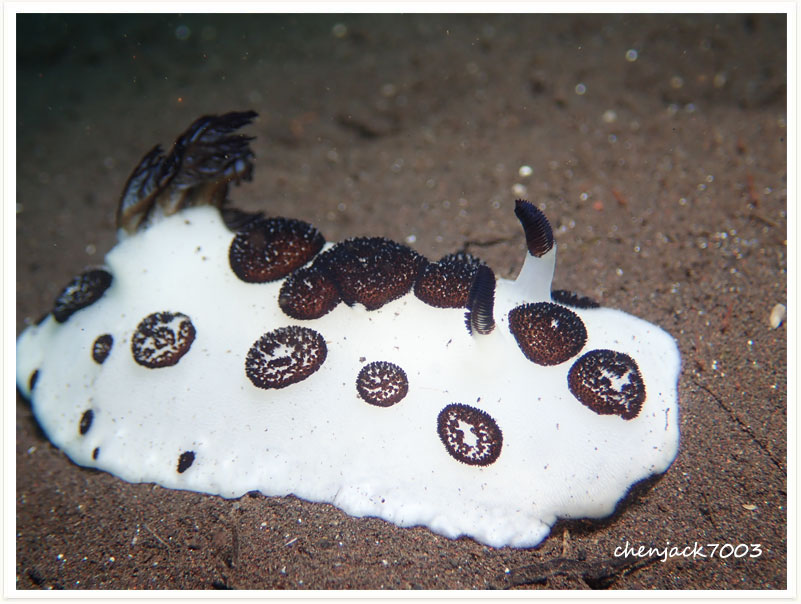
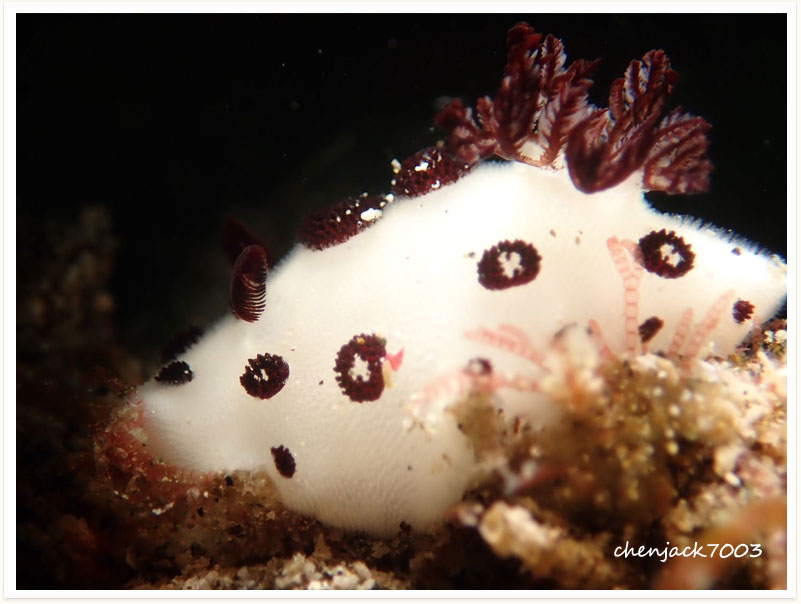
Jorunna alisonae is a species of sea slug, a dorid nudibranch, a shell-less marine gastropod mollusc in the family Discodorididae.
This species was described from Hawaii. Previously identified with the European Jorunna tomentosa.
Jorunna alisonae is a common species usually found in the intertidal zone or shallow depths at protected to moderately exposed rocky sites. It feeds on the violet-brown sponge Haliclona permollis.
This nudibranch feeds on sponges.
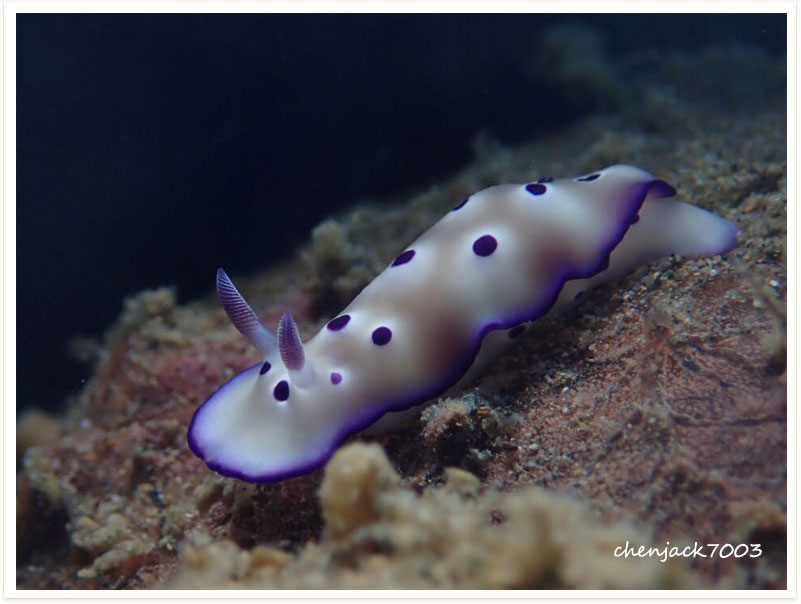
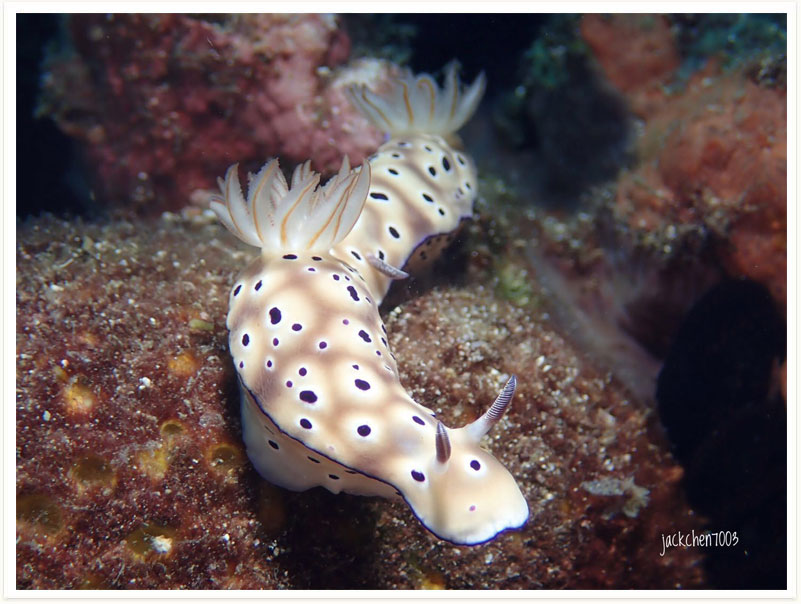
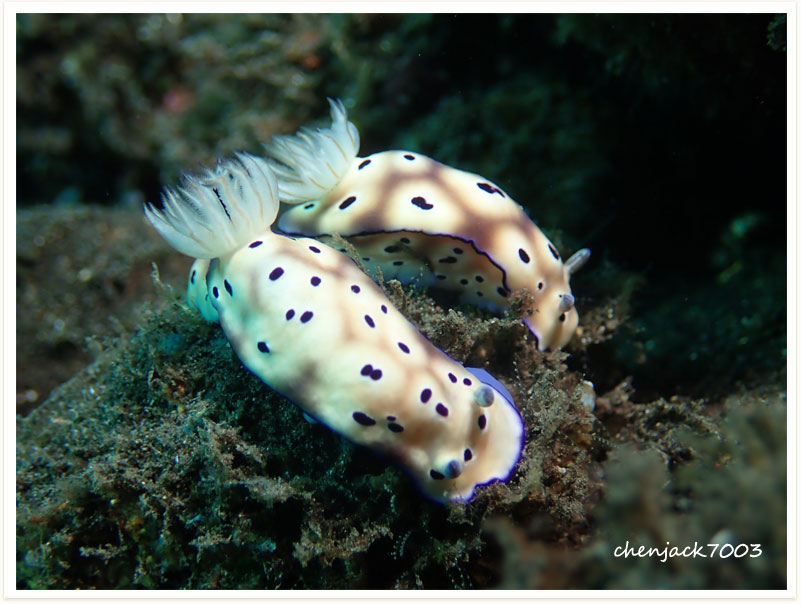
This brown white nudibranch feeds on sponges genus Euryspongia.The mantle margin,rhiniphores and gills are orange-brown in colour.
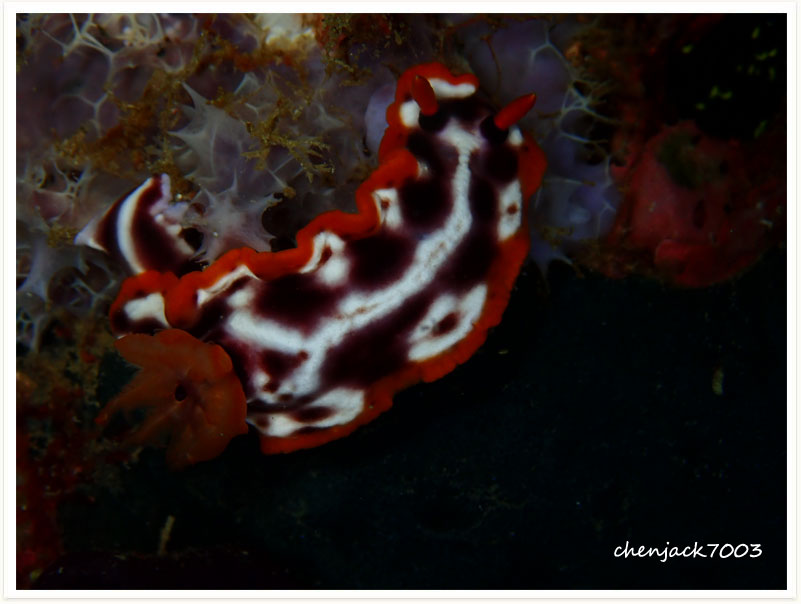
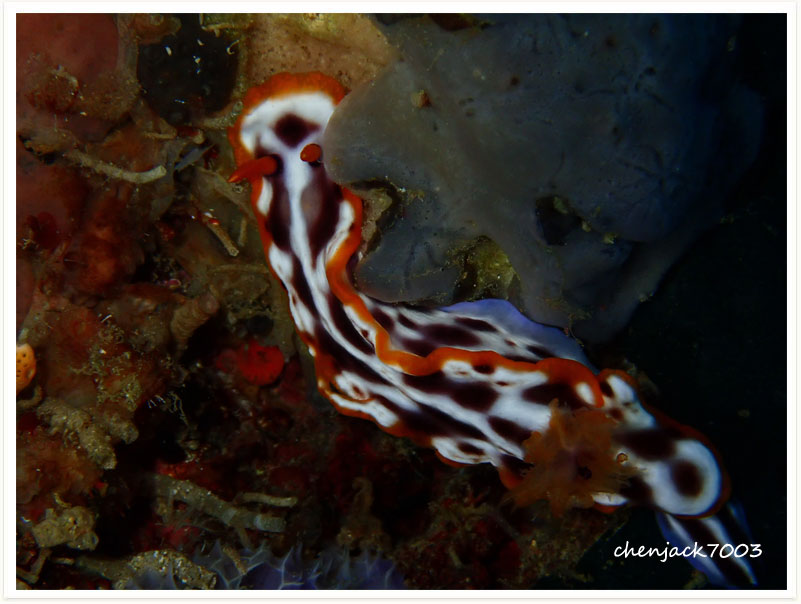
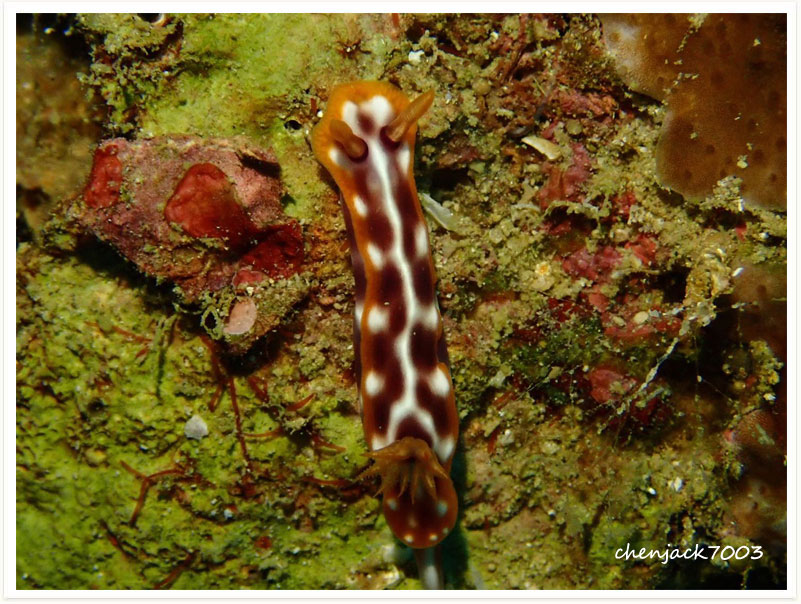
This nudibranch was described from a specimen measuring 70 mm (2.8 in) in length, dredged in 110 m (360 ft) at Recruit Island, Senkaku Islands, 150 miles NE of Taiwan, 25.922745°N 124.558247°E. It is currently identified with an animal which is widespread in shallow water in the central Indo-Pacific region. Many records are incorrect as it has now been shown that at least eight species have been confused under this name in the past. The H. bullockii clade contains seven species, plus H. iba is a mimic of H. bullocki. Six of these can be found in the Philippines. Hypselodoris apolegma is found throughout the western Pacific from Japan (Okinawa), the Philippines, Indonesia Malaysia (Sabah) whereas H. brycei, is found only in Western Australia (Houtman Abrolhos Islands to the Exmouth Region and Dampier Archipelago). Hypselodoris bullockii is considered to be widespread in the western and central Pacific, from Japan, Taiwan, Hong Kong, the Philippines, Indonesia, Malaysia, eastern Australia, the Marshall Islands and New Caledonia, whereas H. melanesica is known only from Papua New Guinea and the Solomon Islands, both of which are areas where H. bullockii is absent. Hypselodoris rositoi is apparently restricted to the northern Philippines and H. violacea is apparently restricted to Sabah, Malaysia and Palawan Island, Philippines. Hypselodoris variobranchia is apparently restricted to Japan (Okinawa), Taiwan, the Philippines, Malaysia, Indonesia and Queensland, Australia.
Hypselodoris apolegma (formerly classified as Risbecia apolegema)feeds on sponges (mainly genus Euryspongia)
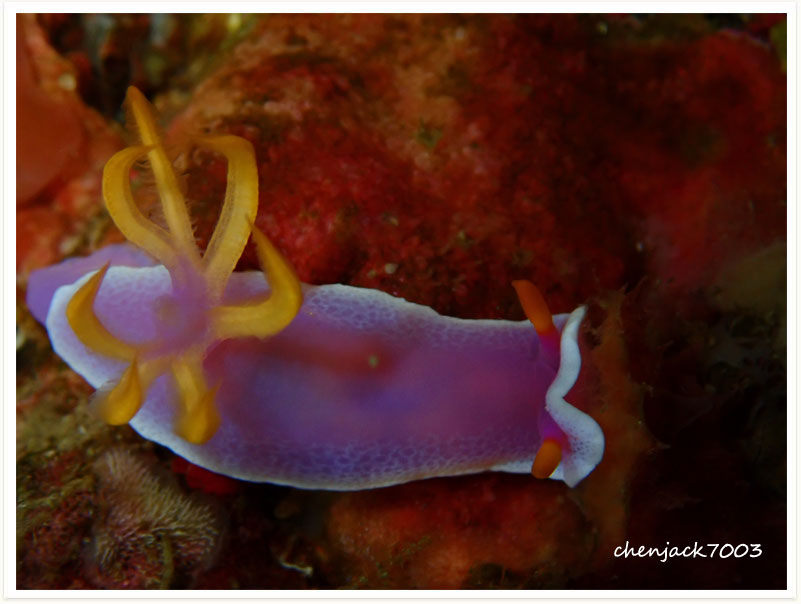
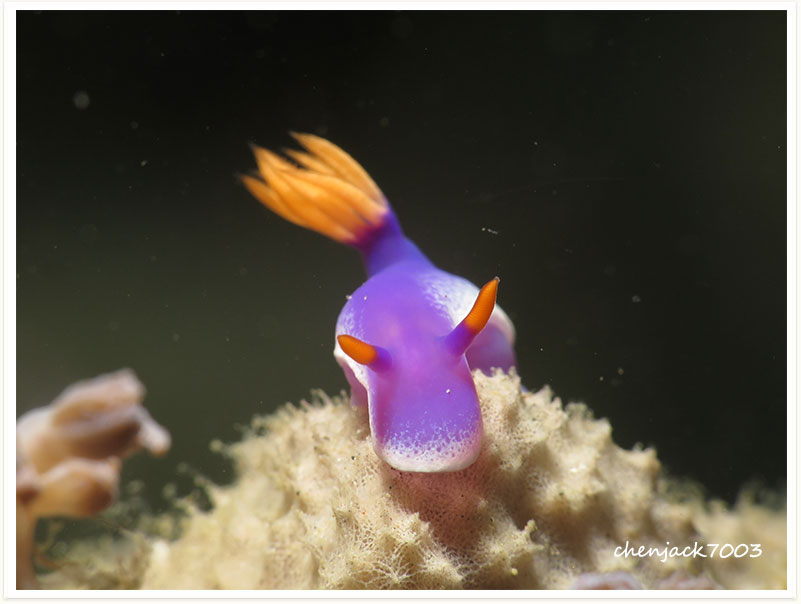

The Spanish dancer is a large dorid nudibranch which can grow up to a maximum length of 90 cm. However, the commonly observed size is between 20 and 30 cm long. Its body coloration is generally orange-red speckled with multiple small white dots but it also can be uniformly bright red or yellow with red scattered spots. Its body is soft and flattened, the anterior dorsal portion has a pair of retractable rhinophores and the posterior part has six contractile gills inserted independently in the body. The pair of oral tentacles are constituted by a fin flexible membrane provided with large digital lobes.
Gymnodoris ceylonica has a translucent white body which is covered with many orange spots. It has translucent orange-lined white gills and orange rhinophores. The foot is translucent white and edged with an orange margin.
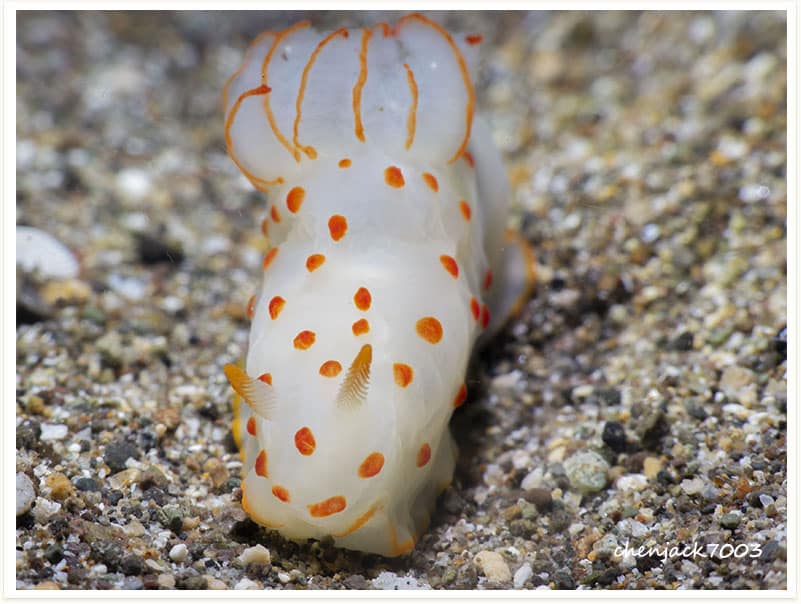
Goniodoridella is a genus of sea slugs, specifically dorid nudibranchs, marine gastropod molluscs in the family Goniodorididae.
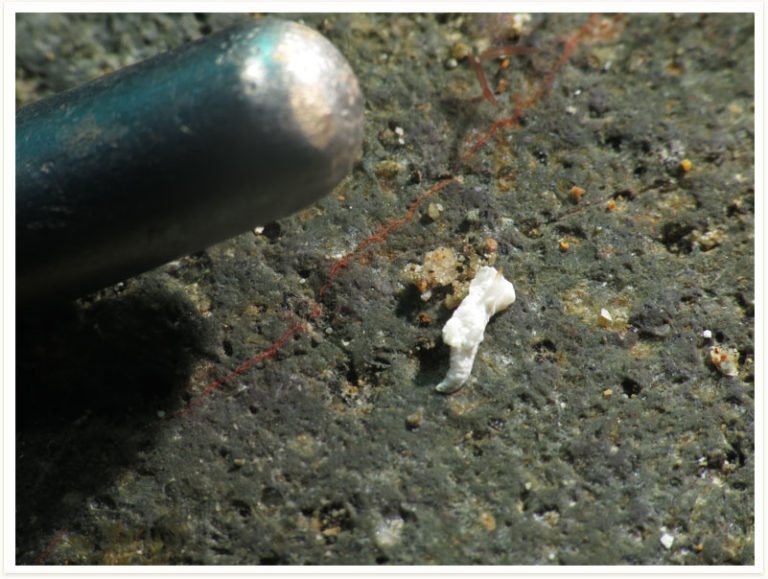
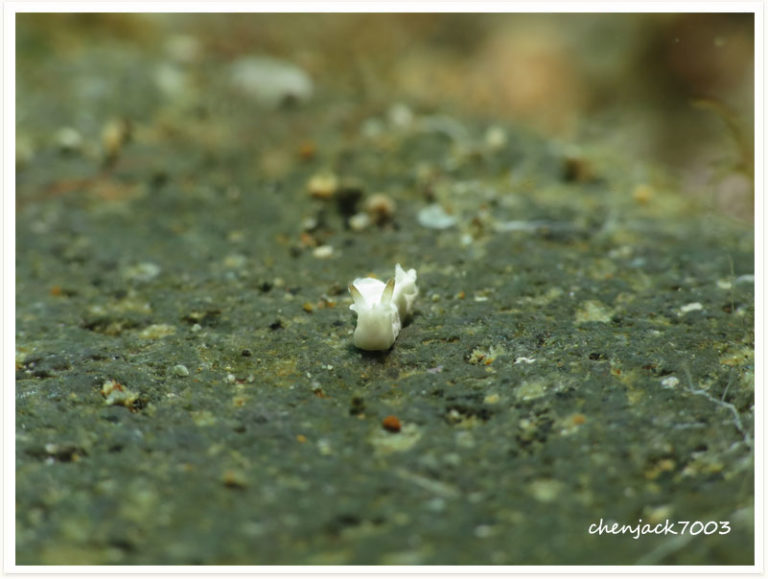
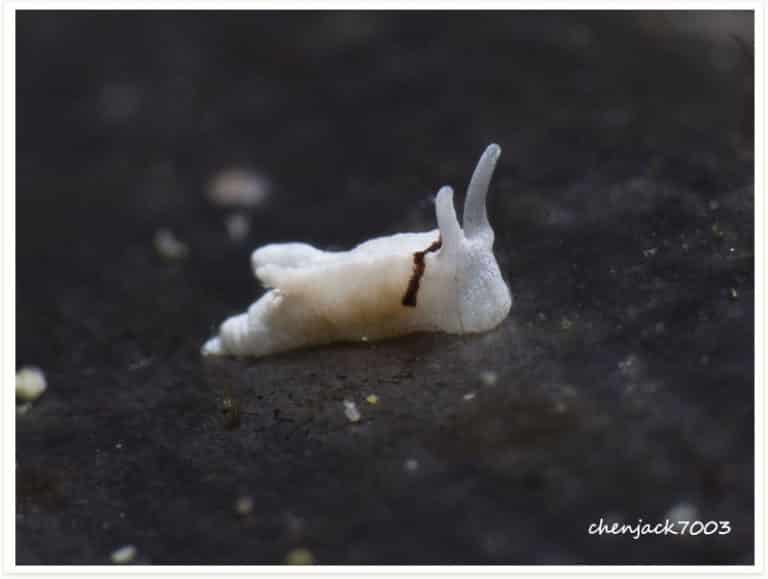
Goniobranchus verrieri has a white mantle with a red margin and a yellow submarginal band. The gills and rhinophores are red with white edging. The length of the body varies between 18 mm and 30 mm
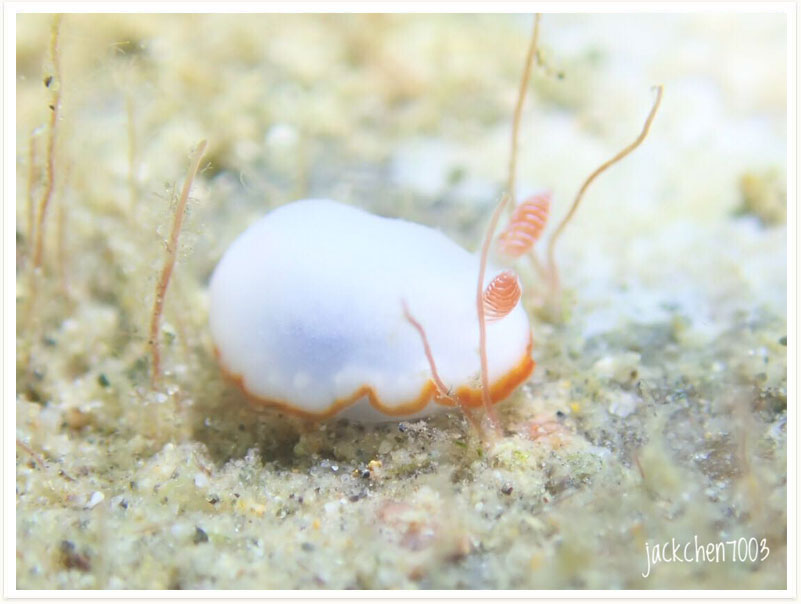
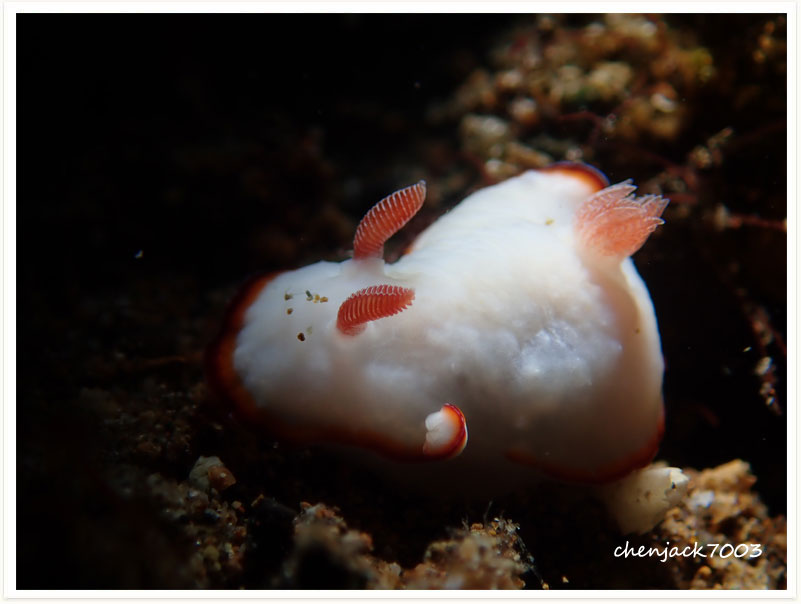
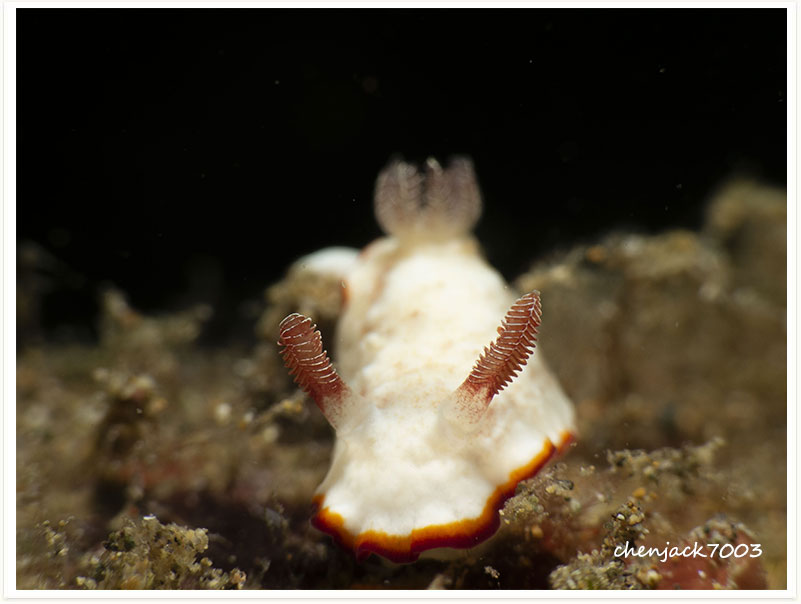
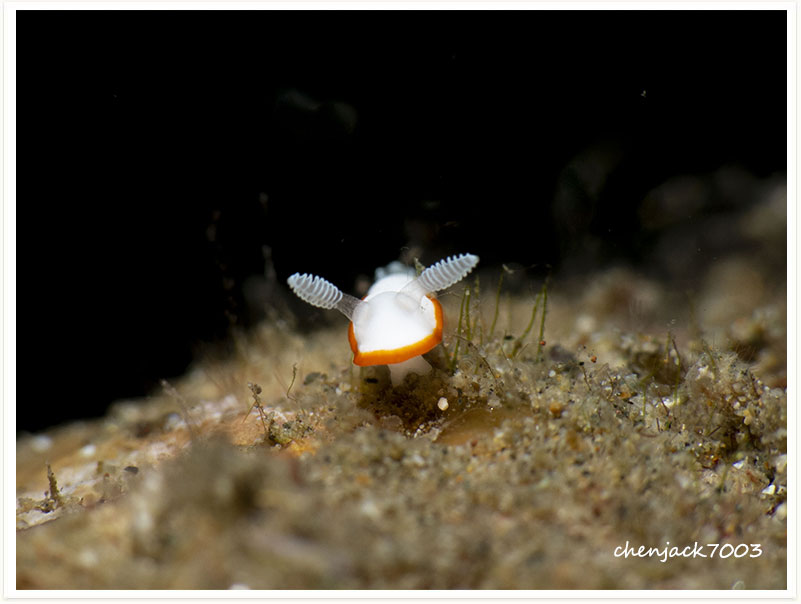
This species feeds exclusively on sponges.
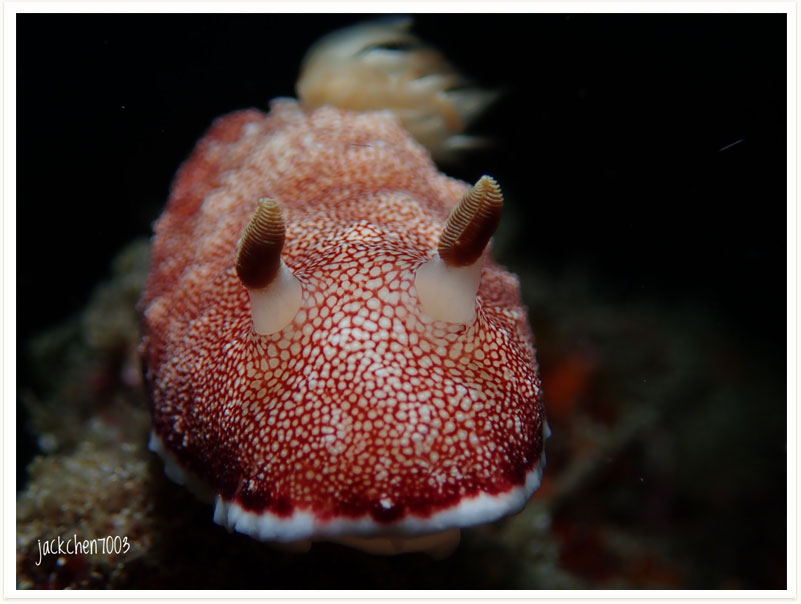
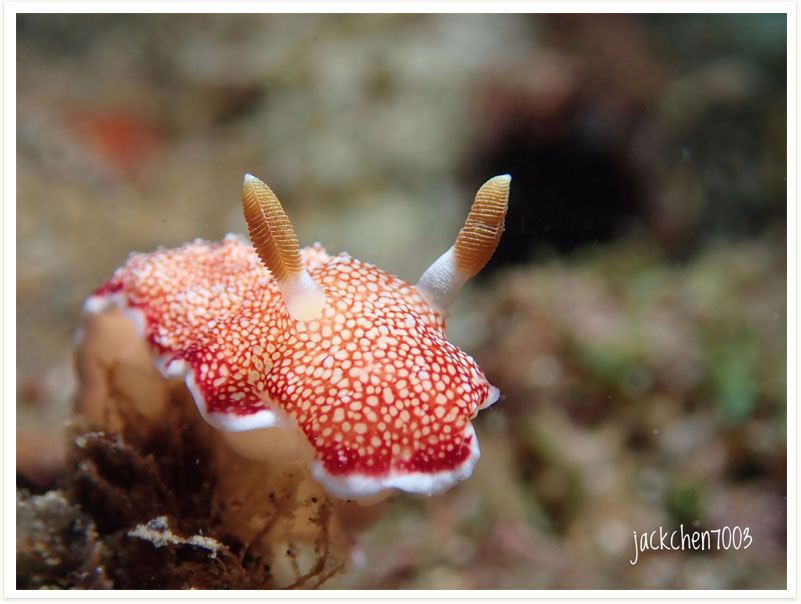
Goniobranchus kuniei has a pattern of blue spots with pale blue haloes on a creamy mantle. There is a double border to the mantle of purple and blue. The length of the body reaches 40 mm.The species Goniobranchus tritos and Goniobranchus geminus have similar colour patterns.
Quite similar in appearance to C. geometrica. Two major points of difference are the rhinophore & gill colour and the presence of a few small white rounded nodules on the mantle, each surrounded by a ring of deep magenta (or purple). The gills and rhinophores are a translucent reddish purple colour edged with a dark line of the same colour. Like C. geometrica the anterior mantle waves up and down rhythmically and its underside is a deep purplish colour.
Goniobranchus geometricus is a small nudibranch which may grow to a total length of 35mm. It is variably coloured, with the ground colour ranging from a creamy brown to purple, The mantle has numerous cream-coloured bumps and has a white margin. The gills and rhinophores are white to greenish. It is very similar to Goniobranchus conchyliatus but has green-grey rhinophores and gills whilst G. conchyliatus has red ones.
Goniobranchus fidelis can reach more than 25 mm (0.98 in) in length.The foot of the animal is cream in color; it is elongate and is almost covered by the edges of the wide mantle. The more central part of the mantle has a creamy-white area with scalloped edges, whereas the entire wide margin of the mantle is orange or red. Where the two differently coloured areas meet, there is a burgundy-colored border which varies in width from one animal to the other. The rhinophores are laminated, contractile and greyish in color with lighter colour at the tip. The shade of grey varies from one individual to another. The gills are the same colour as the rhinophores and they are retractable.
This species feeds exclusively on hydroid polpyps.Unfortunately there is no more information available and we would be grateful for any supplementary references.
This species was found in Anilao, Philippines
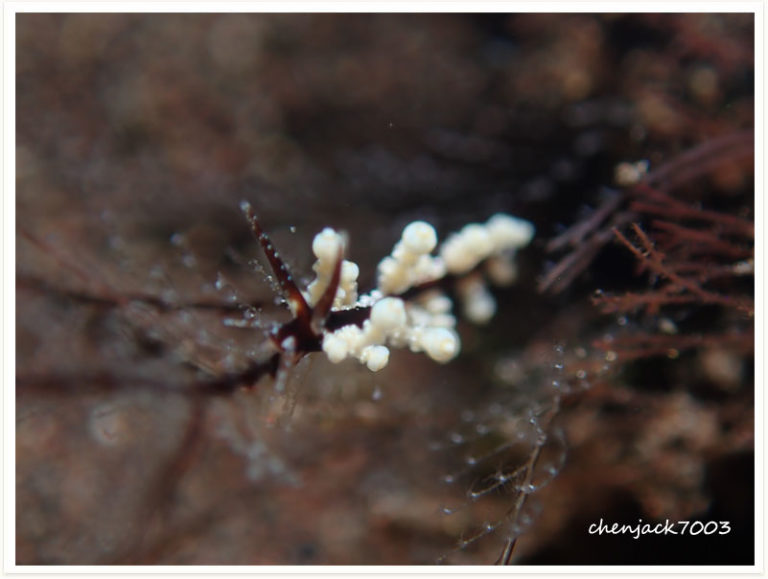
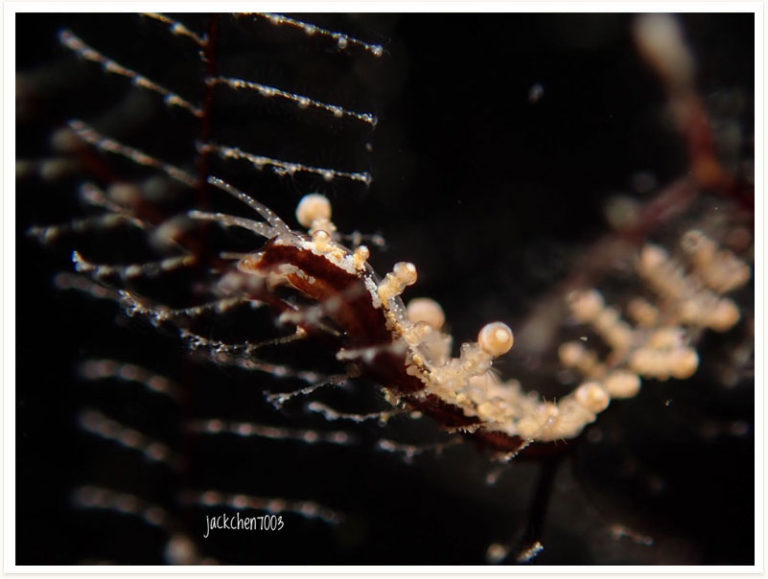
Doriprismatica atromarginata ranges in color from creamy-white through yellow to pale brown. It typically has a black-lined edge running down the outside of a very folded mantle and black rhinophore clubs. The frilly mantle sometimes appears to move like a wave as the animal crawls along. It can reach a total length of at least 60 mm. This species is very similar in appearance to Doriprismatica sibogae and Doriprismatica plumbea, although Doriprismatica atromarginata is by far the more common and is not quite as deep yellow in colour as the other species
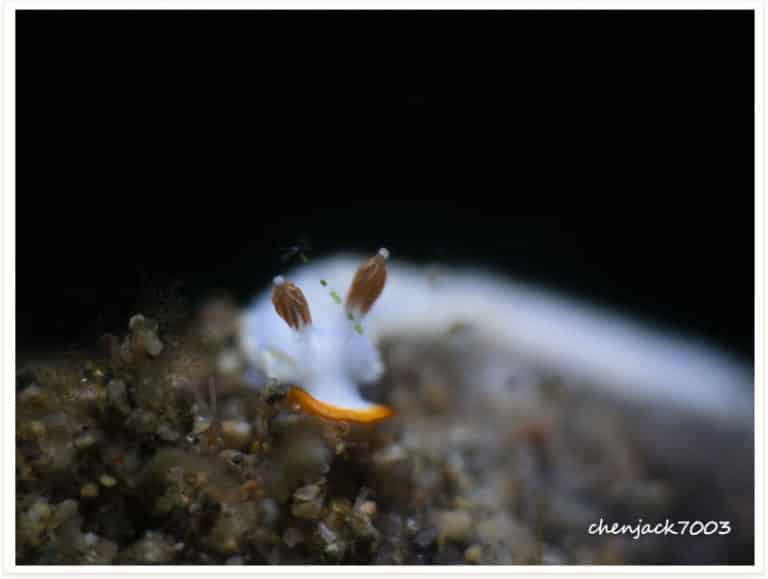
Dendrodoris carbunculosa is a large sea slug and grows at least 25,0 cm.The underside of the mantle is a uniform brown or reddish brown,sometimes with darker patches (Dendrodoris tuberculosa havelarge white oval spots). The tubercles are large and individual (D.tuberculosa have packed close together tubercles, which are often compound.
unknow
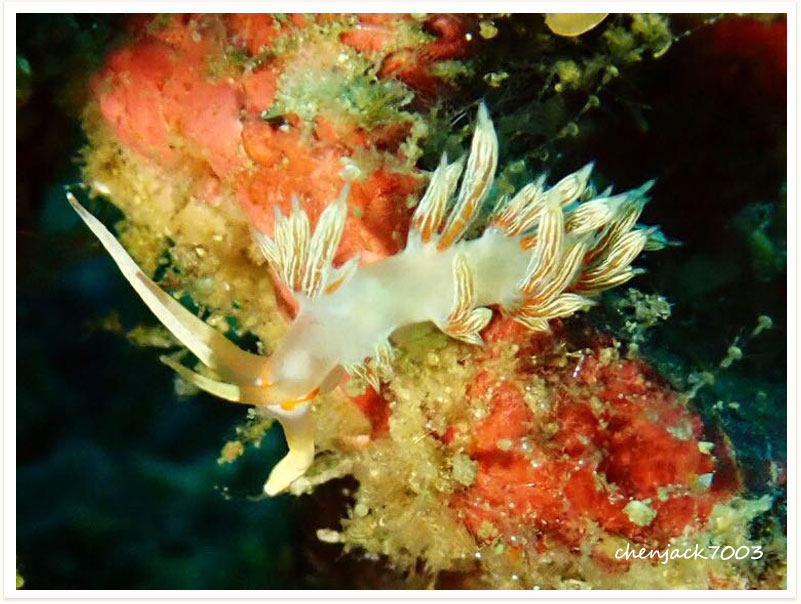
Costasiella usagi occurs in the tropical western pacific. The colour is higly variable (grren, greyish). Rhinophores with black tipps.
This species feeds on the algae Avrainvilla a fan algae.
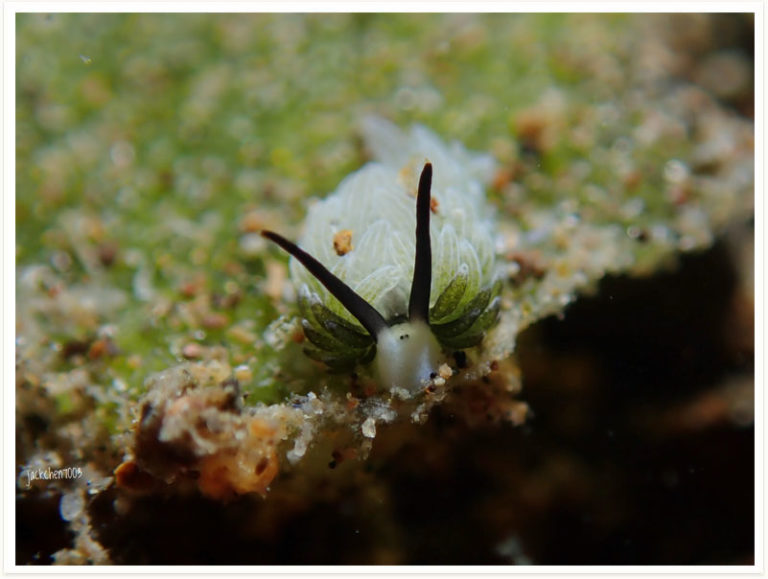
This tiny sea slug is black with large yellowish warts on white patches, because of that the common name is ” Fried Egg Sea Slug”. The diet is unknown.
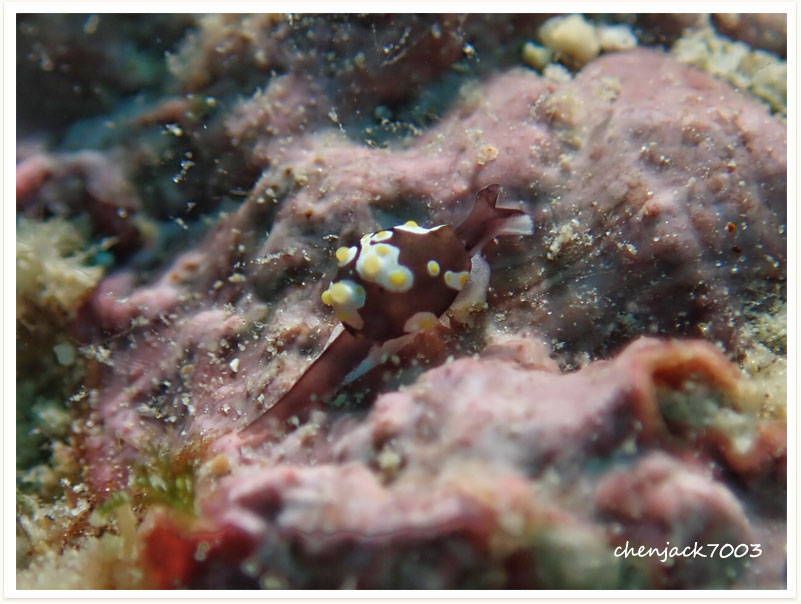
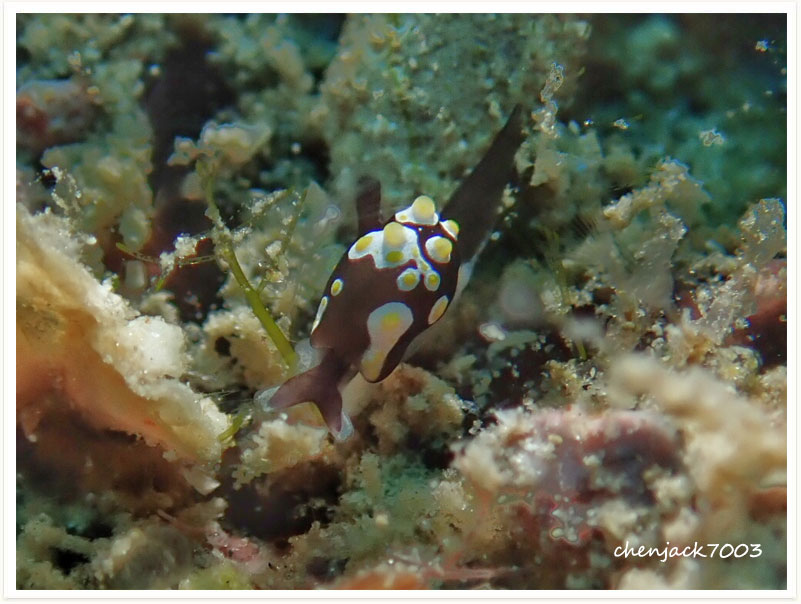
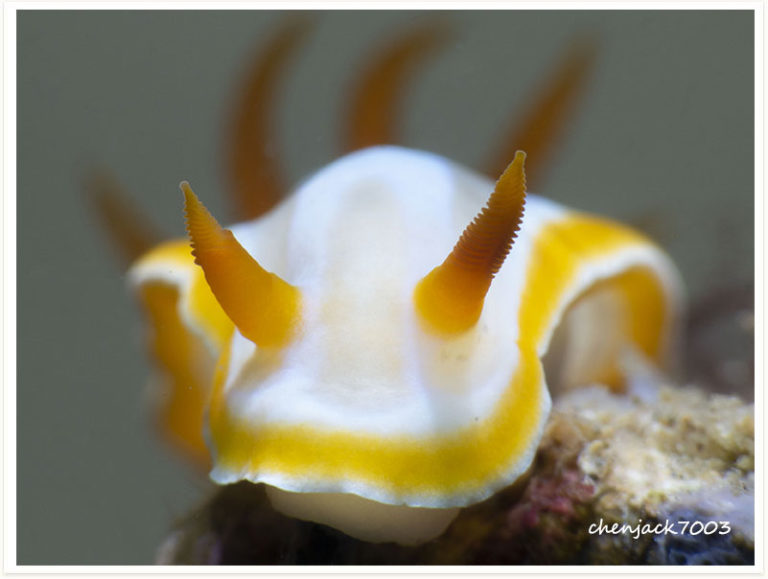
Chromodoris willani is similar in appearance to Chromodoris lochi, Chromodoris boucheti and Chromodoris dianae. This species can be distinguished by the very prominent white specks found on the gills and rhinophores.
Individuals in this species can range in color from dark blue to a translucent white. All have black stripes with the center-most stripe typically being non-continuous
Chromodoris lochi is blue or blueish-white with a white margin and typically dark or black lines running down the mantle and the foot. On the mantle, a continuous line runs around the border passing on the outside of the rhinophore and a second median one can be discontinuous. Individuals can reach at least 4 cm in length.There is some variation between individuals in this species, and the gills (retractile) and rhinophores (contractile) range in colour from a translucent straw-color, through to pink and light orange.This species is very similar in appearance to Chromodoris willani, Chromodoris boucheti and Chromodoris dianae and can be difficult to tell apart. Its most distinguishing feature is the uniform colouring of the mantle and the lack of white specks which are present in some of the other species. A recent study showed that more than one species is currently confused amongst Chromodoris lochi.
Chromodoris elisabethina can reach a maximum size of 50 cm (20 in) length. The body is elongate with a foot which is distinct from the upper body by a skirt like mantle partially hiding the foot. The branched gills and the rhinophores are orange to yellow and can be withdrawn into pockets under the skin in case of danger.
The lightest colour form has a background colour of white with the grey-black reticulate pattern restricted to the dorsal surface of the headshield and posterior shield, and to the small sections of the parapodia which fold over the dorsal surface of the body.
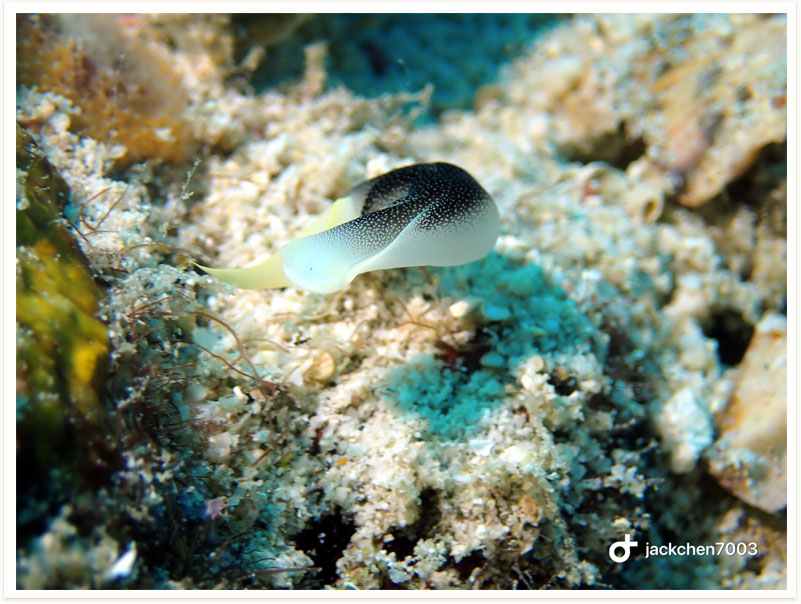
Feed on barnacles, sea squirts, soft corals, and /or sponges sponge (f.e. Halisarca metabola de Laubenfels, 1954).
Cadlinella ornatissima is a widespread and common species, occurring in tropic and sometimes in sub tropical zones.Its body is mostly yellow to orange, sometimes white and filled with many thick and elongated warts.The warts have usually a pink to reddish tip, are their gills and the rhinophores white-transparent. Best left in the wild.
This aeolid is characterised by the swellings on the rhinophores. There is a red patch between rhinophores .
Feeds on small sea anemones.
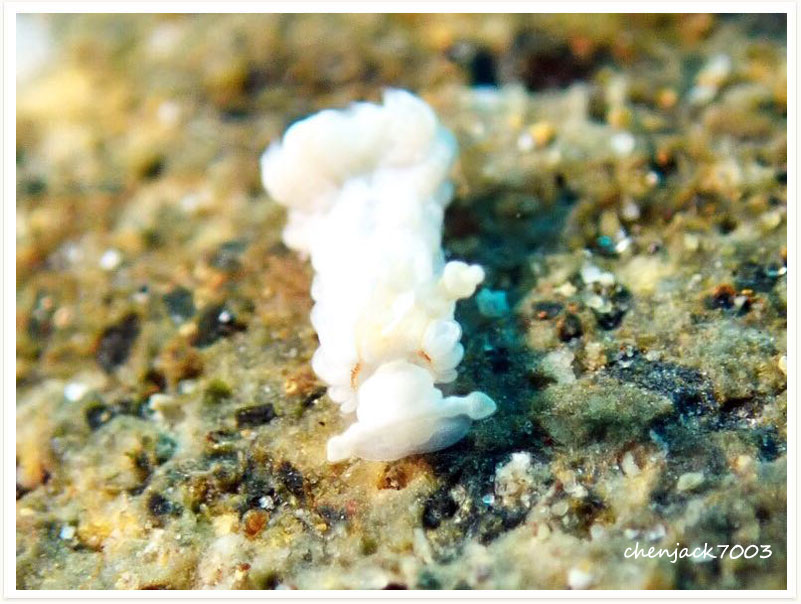
This white nudibranch with a yellow border grows to 12 cm in length.Rhinophores and gills are white.This species feeds exclusively on sponges.
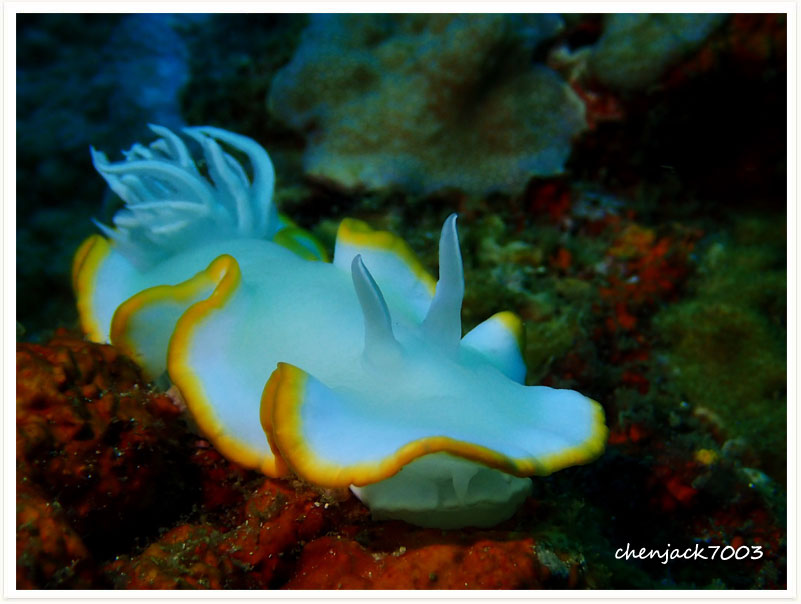
The Napoleon snake eel (Ophichthus bonaparti, also known as the Napoleon eel, the Purplebanded snake eel, or the Saddled snake-eel) is an eel in the family Ophichthidae (worm/snake eels). It was described by Johann Jakob Kaup in 1856, originally under the genus Poecilocephalus.It is a marine, tropical eel which is known from the Indo-Pacific, including Durban, South Africa, Mauritius, Indonesia, Japan, Australia, and the Penghu Islands. It is known to dwell at a depth of 20 metres (66 ft), and inhabits lagoons and reefs; it forms solitary burrows in sand sediments. Males can reach a maximum total length of 75 centimetres (30 in).
The snowflake moray (Echidna nebulosa) also known as the clouded moray among many various vernacular names, is a species of marine fish of the family Muraenidae.
It is widespread throughout the Indo-Pacific area from the eastern coast of Africa throughout Micronesia including the Red Sea and Hawaii. The species is also found in the eastern Central Pacific from southern Baja California, Mexico, and from Costa Rica to northern Colombia.
With distinctively compressed and disk-like bodies, Moorish idols stand out in contrasting bands of black, white, and yellow, which makes them attractive to aquarium keepers. The fish have relatively small fins, except for the dorsal fin, whose six or seven spines are dramatically elongated to form a trailing, sickle-shaped crest called the philomantis extension. Moorish idols have small terminal mouths at the end of long, tubular snouts; many long bristle-like teeth line the mouth. The Moorish idol differs from butterflyfish in having a prominent black, triangular anal fin.
Wunderpus photogenicus, the wunderpus octopus is a small-bodied species of octopus with distinct white and rusty brown coloration. ‘Wunderpus’ from German “wunder” meaning ‘marvel or wonder’. Due to the appearance and behavior of the wunderpus, it is frequently confused with its close relative, the mimic octopus. The wunderpus octopus was not discovered until the 1980s and was only officially described in detail in 2006. The wunderpus octopus are important commercially to the underwater photography, dive and tourism communities, especially throughout Indonesia. The wunderpus is also valued as an expensive ornamental marine species for the home aquarium.
Typical of stargazers, its body is somewhat dorso-ventrally flattened, lacks a swimbladder, and has been found as large as 35.0 centimeters in length, but is usually between 20–30 cm. Its head and jaws are rotated upward, and has very large eyes and mouth. Its body is brown in color and can have numerous small light spots, with a lighter belly. It lives to about 5 or 6 years, and females are larger in size than males.
A relatively small species, few whitetip reef sharks are longer than 1.6 m (5.2 ft). The maximum length this species attains is often given as 2.1 m (6.9 ft), though this was originally based on visual observations and may be dubious. The maximum reported weight is 18.3 kg (40 lb). The whitetip reef shark has a slim body and a short, broad head. The snout is flattened and blunt, with large flaps of skin in front of the nares that are furled into tubes. The eyes are small and oval with vertical pupils and prominent ridges above, and are often followed by a small notch. The mouth has a distinct downward slant (imparting a disgruntled expression to the shark), with short furrows at the corners. There are 42–50 tooth rows in the upper jaw and 42–48 tooth rows in the lower jaw. Each tooth has a single narrow, smooth-edged cusp at the center, flanked by a pair of much smaller cusplets.
The mimic octopus (Thaumoctopus mimicus) is an Indo-Pacific species of octopus capable of impersonating other local species. They are notable for being able to change their skin color and texture in order to blend in with their environment, such as algae-encrusted rock and nearby coral through pigment sacs known as chromatophores. The mimic octopus possesses chromatophores as well as the unique behavior of taking shape of various objects and animals. The mimic octopus is the only currently known marine animal to be able to mimic such a wide variety of animals. Many animals can imitate a different species to avoid or intimidate predators, but the mimic octopus is the only one that can imitate as diverse a range of forms in order to elude predators.
Living in waters 4 to 91 meters, occasionally juvenile seaweed in the tide pools or prosperous region, to fish habitat in the sand on the reef or reef flats mixing zone. Swimming ability is not strong, often perched on the reef, opportunistic predator. Carnivorous, to fish and small benthic invertebrates based. Breeding season is from May to October, buoyant eggs hatch after about 17 hours
Siokunichthys is a genus of pipefishes native to the Indian and Pacific Oceans. One species, Siokunichthys nigrolineatus, has a commensal relationship with mushroom corals of the genusFungia.
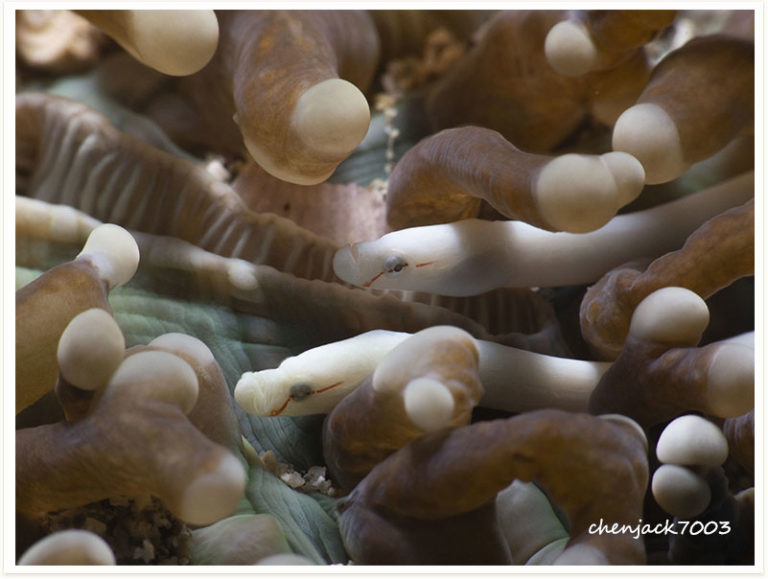
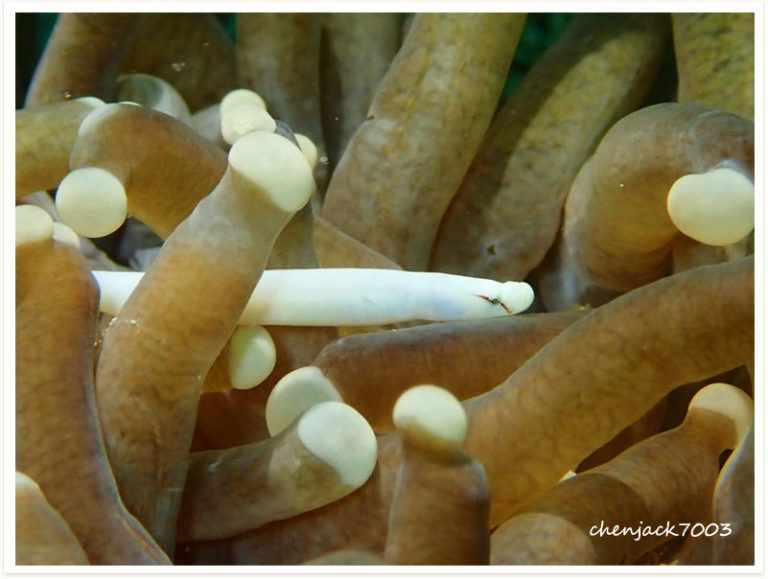
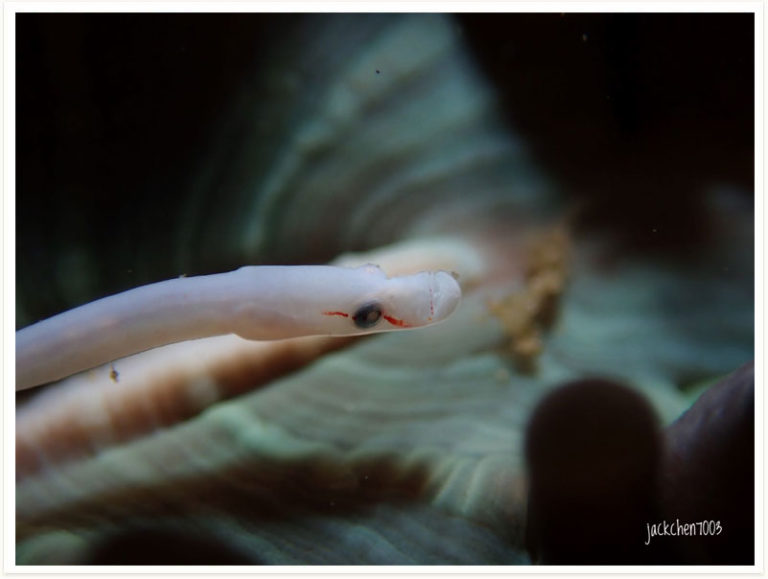
The broadclub cuttlefish is the second largest cuttlefish species after Sepia apama, growing to 50 cm (20 in) in mantle length and 10 kg (22 lb) in weight.Like many cephalopods, the broadclub can be seen displaying a range of colors and textures. Commonly they are light brown or yellowish with white mottled markings. Males are sometimes dark brown, particularly during courtship and mating. The arms have longitudinal white bands that appear as broad white blotches when extended. Some arms have longitudinal brown bands that extend to the head. The dorsal mantle can sometimes be seen with a saddle mark with small white and brown spots. The dorsal mantle also has narrow brown transverse bands, and bold, white, transverse stripes and spots. The eyes are yellow around the ventral margins and the fins are pale with white, transverse stripes extending onto mantle and narrow, white bands along outer margins.
Sebastapistes strongia, the barchin scorpionfish, is a scorpionfish from the Indo-Pacific.The species is commonly seen in areas with mixed sand and rubble in reef flats, shallow lagoons, and channels. The species is nocturnal and can grow to a maximum length of 60 mm (2.4 in)
The false stonefish has a broad head with a wide mouth, a humped back, and a tapering body, and can reach 30 cm (12 in) in length. Its dorsal fin has 12 venomous spines and eight to 10 soft rays. The anal fin has three spines and five to six soft rays. The skin is rough with low conical projections, spines, and tassels. The colouring is a combination of mottled grey and white with reddish-brown blotches and the fish is well-camouflaged among stones and corals. The inner sides of the broad pectoral fins have orange, black, and white blotches and the fins can be “flashed” as a warning. This fish closely resembles the reef stonefish (Synanceia verrucosa).
Interorbital area and snout scaled; small spines at midline between tympanic spines frequently present; interorbital spines present; extra spines usually present on upper rear margin of eye after supraocular spine; dorsal spine, usually non longer than orbit diameter; body often covered with small skin flaps. Distinguished from other species of Scorpaenodes by having suborbital ridge with more than 5 spinous points, usually with 10 or more in adults
Scarus tricolor is a greenish parrotfish which normally shows pinkish or yellowish tints on the posterior portion of its body and a purplish band just inside the margin of each lobe of the caudal fin. The females are dark grey to almost black shading to blue to bluish-green on the lower flanks, with black edging to the scales, a red tail fin, an orange anal fin and sooty yellowish to orange pelvic fins. The terminal phase males are similar to those of Scarus forsteni, the most notable difference being that S. tricolor has a yellow inner pectoral axil.
Is actinopterygii outline scorpaeniformes rockfish suborder Scorpaenidae wherein one of temperate marine fish, distributed in the Northwest Pacific Japan Sagami Bay, length up to 15 cm, a rock perched water bottom sediments, to fish and crab-eating, habits unknown
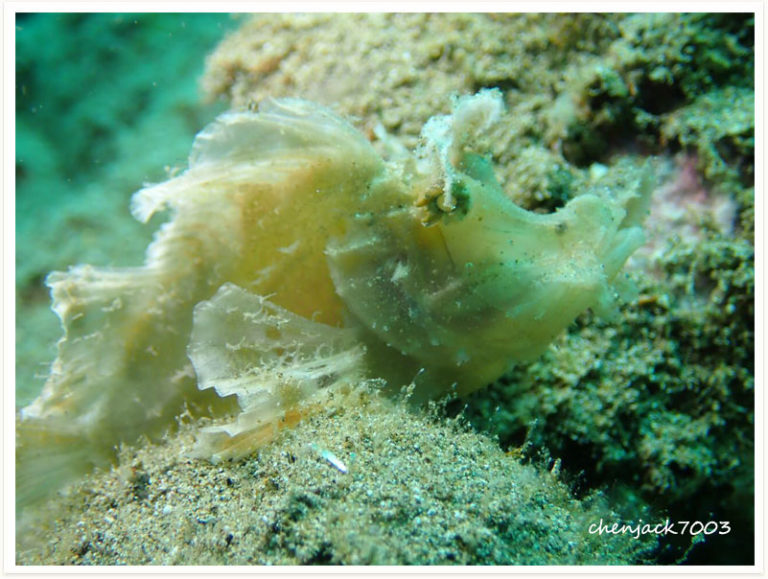
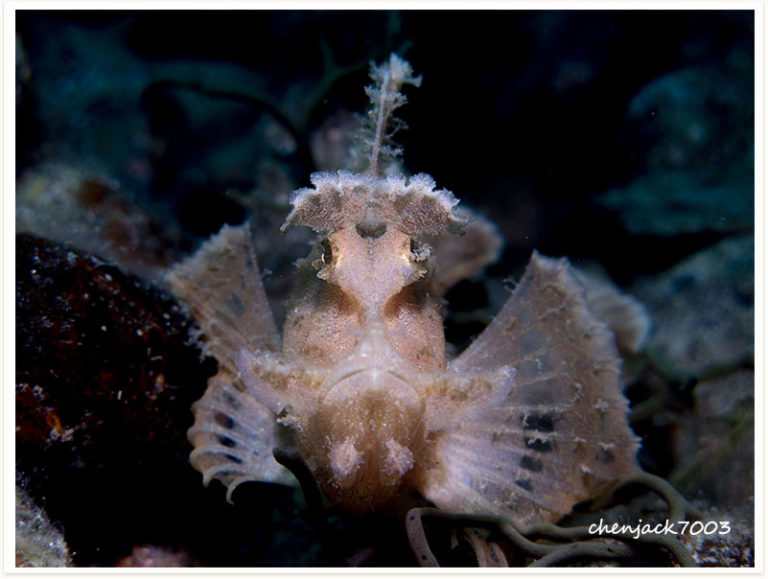
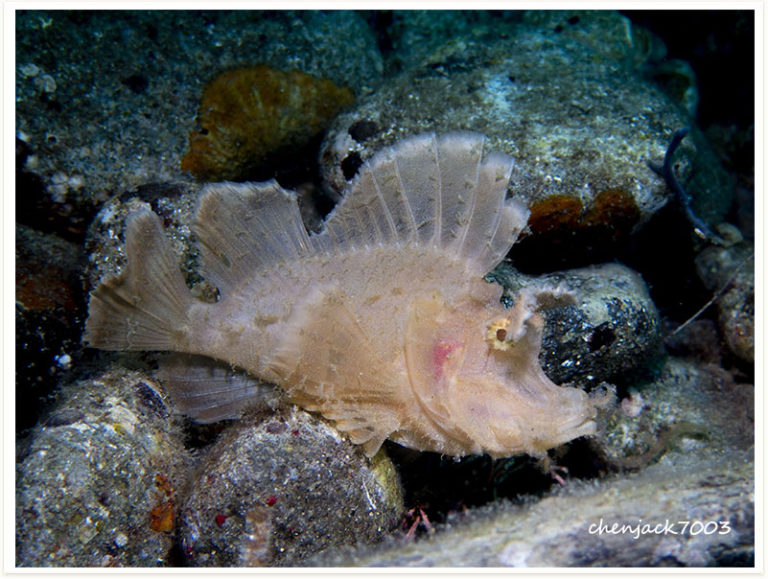
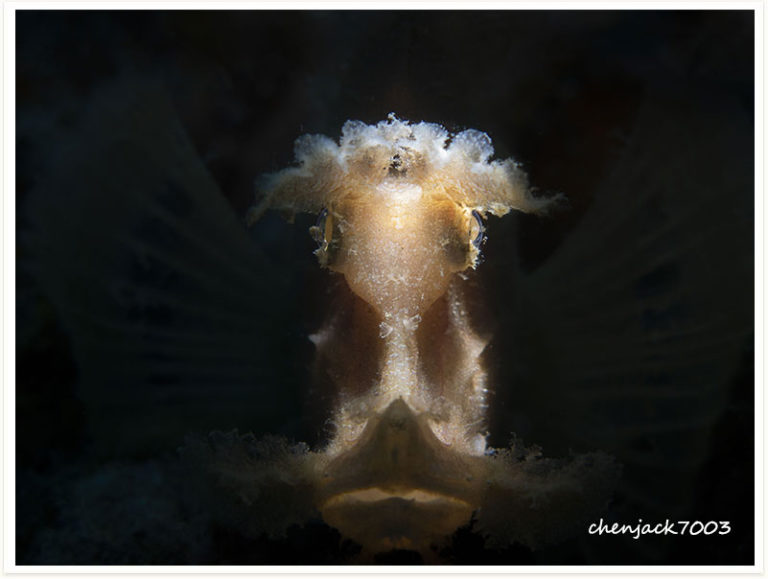
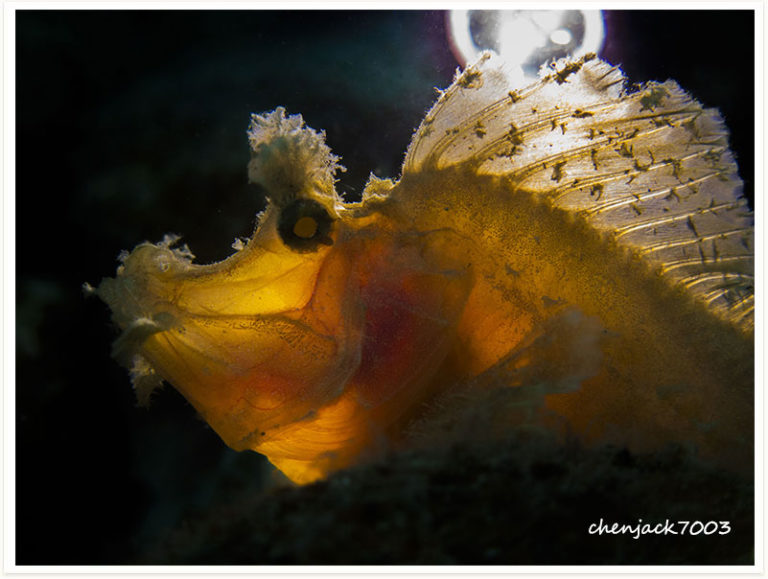
The red lionfish (Pterois volitans) is a venomouscoral reef fish in the familyScorpaenidae, orderScorpaeniformes. P. volitans is native to the Indo-Pacific region, but has become an invasive species in the Caribbean Sea, as well as along the East Coast of the United States and East Mediterranean. This and a similar species, Pterois miles, have both been deemed invasive species. Red lionfish are clad in white stripes alternated with red/maroon/brown stripes. Adults in this species can grow as large as 47 cm (18.5 in) in length, making it one of the largest species of lionfish in the ocean, while juveniles are typically shorter than 1 inch (2.5 cm). The average red lionfish lives around 10 years. As with many species within the family Scopaenidae, it has large, venomous spines that protrude from the body, similar to a mane, giving it the common name lionfish. The venomous spines make the fish inedible or deter most potential predators. Lionfish reproduce monthly and are able to quickly disperse during their larval stage for expansion of their invasive region. No definitive predators of the lionfish are known, and many organizations are promoting the harvest and consumption of lionfish in efforts to prevent further increases in the already high population densities.
Juveniles are dark blue with electric blue and white rings; adults have yellow and blue stripes, with black around the eyes. It takes about 24 to 30 months for an emperor angelfish to acquire its adult coloring. Full adult size is about 40 cm (15.75 in) in length
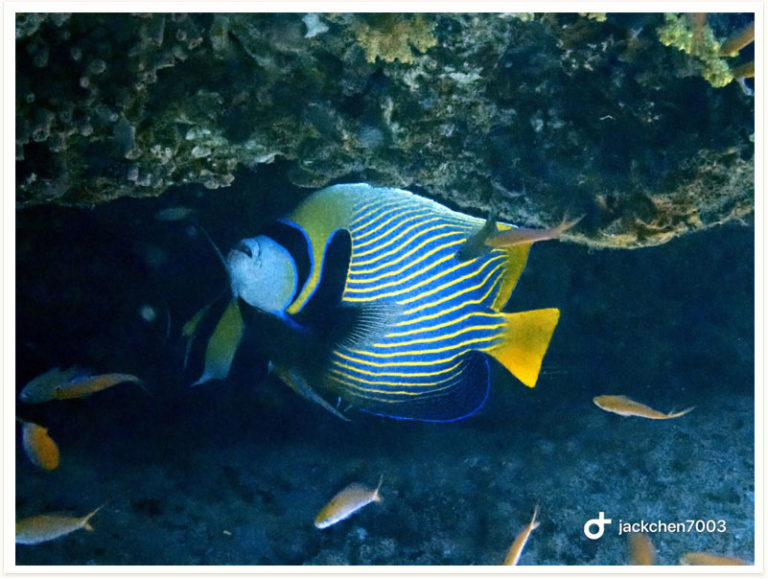
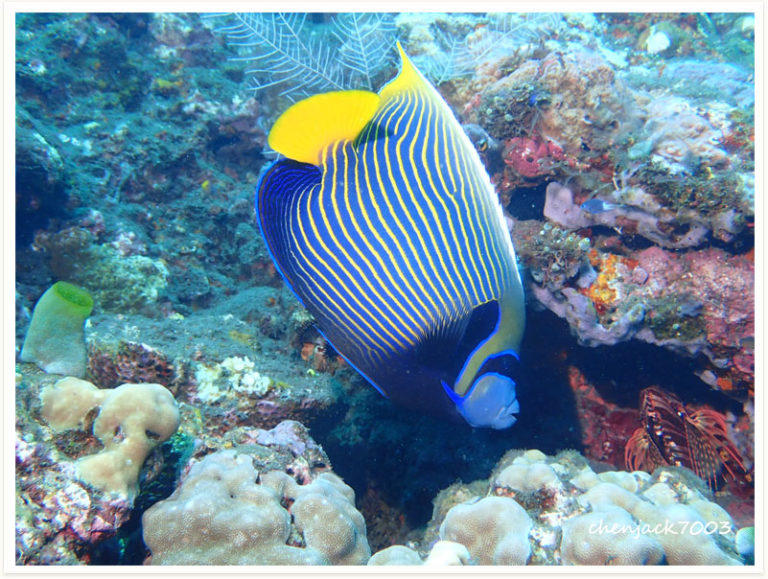
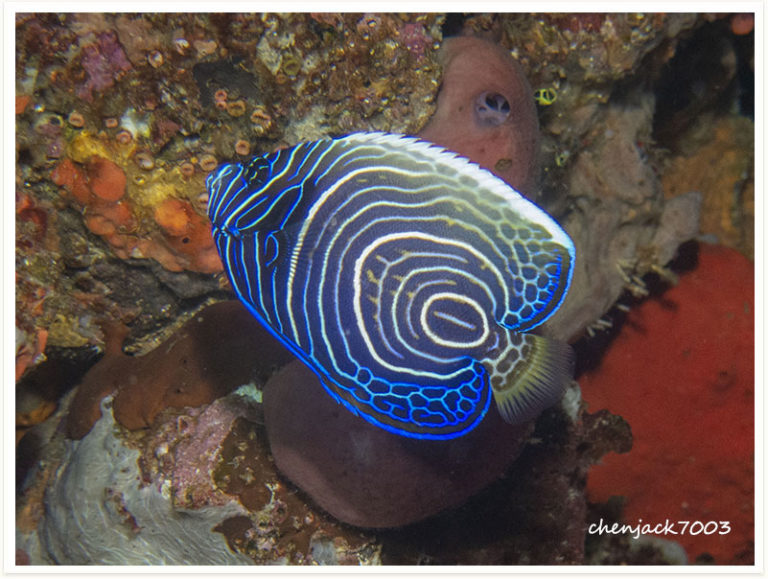
Plotosus lineatus can reach a maximum length of 32 cm (13 in).The body is brown with cream-colored or white longitudinal bands.
The most striking feature of this species is in the fins, in fact the second dorsal, caudal and anal are fused together as in eels. In the rest of the body is quite similar to a freshwater catfish: the mouth is surrounded by four pairs of barbels, four on the upper jaw and four on the lower jaw. The first dorsal and each of the pectoral fins have a highly venomous spine. They may even be fatal.
The Indian Ocean oriental sweetlips reach up to 72 cm (28 in) in SL. Juveniles are striped black. As they age, the stripes in the tail are replaced by black dots on a yellow background.
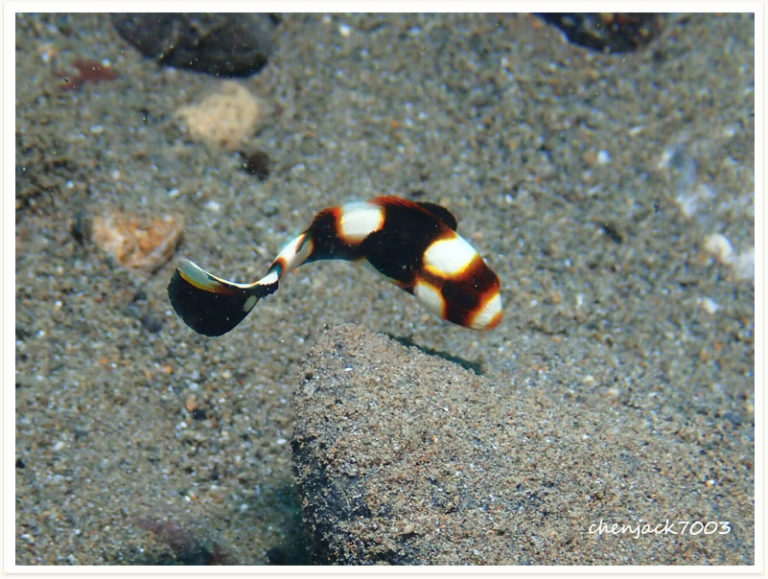
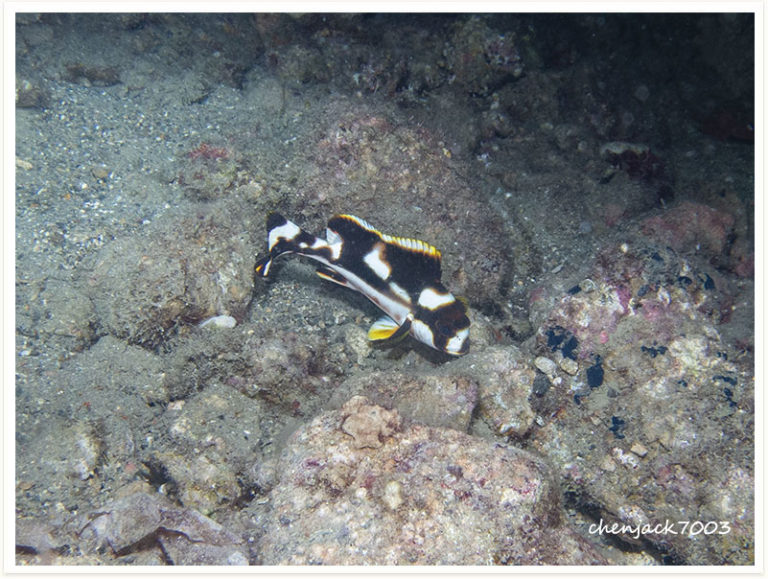
Plectorhinchus lineata also known as the yellowbanded sweetlips, is a species of grunt which inhabits coral reefs of the western Pacific Ocean, where it occurs at depths from 1 to 35 m (3.3 to 114.8 ft). This species can reach 72 cm (28 in) in TL. It is of minor importance to local commercial fisheries and can be found in the aquarium trade.
Plectorhinchus gibbosus, commonly known as the Harry sweetlips, is a marine fish native to the Western Pacific and Indian Oceans.
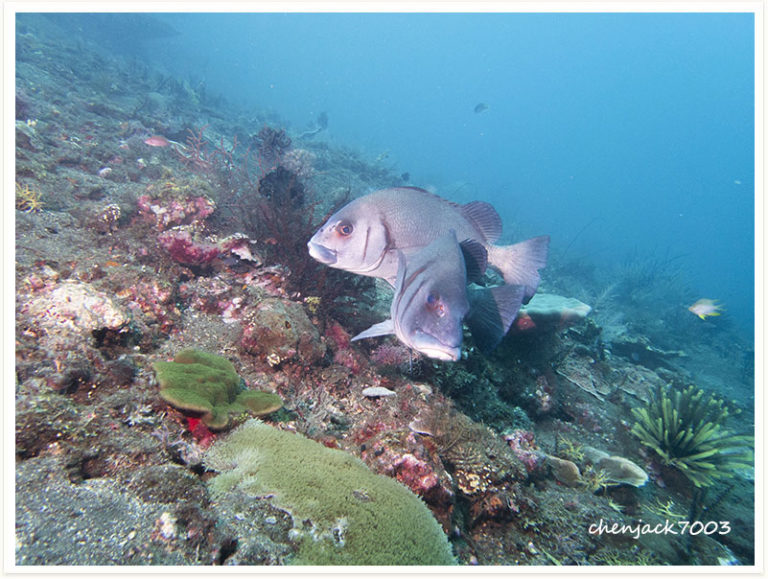
Plectorhinchus chaetodonoides, the harlequin sweetlips, is a species of grunt native to the Indian Ocean and the western Pacific Ocean. It is a denizen of coral reefs found at depths of from 1 to 30 m (3.3 to 98.4 ft). It can reach 72 cm (28 in) in TL. The heaviest known individual weighed 7 kg (15 lb). This species is of minor importance to local commercial fisheries and can be found in the aquarium trade.
Plectorhinchus albovittatus, the two-striped sweetlips, is a species of grunt native to the Indian Ocean and the western Pacific Ocean. They occur in lagoons, reefs, or around seamounts. Juveniles live in turbid inshore and brackish waters. This species can reach 100 cm (39 in) SL. This species can be found in the aquarium trade.
From before birth, their eggs are demersal and adhesive and attach to substrates via a filamentous adhesive pad or pedestal. The bluestriped fangblenny can attain around 90mm in length. Two distinct colour phases of this fish are present; blue with a black stripe from snout to tail, or orange with two narrow blue lines from snout to tail. Unlike most blennies, the bluestriped fangblenny is free swimming. Adults inhabit clear, coral-rich areas of lagoon and seaward reefs and it is fairly common on both coral and rocky reefs, usually occurring singly or in pairs.[citation needed] They are known for being aggressive and feed on skin, mucus and sometimes other fish scales. They bite divers when alarmed.
From before birth, their eggs are demersal and adhesive and attach to substrates via a filamentous adhesive pad or pedestal. The bluestriped fangblenny can attain around 90mm in length. Two distinct colour phases of this fish are present; blue with a black stripe from snout to tail, or orange with two narrow blue lines from snout to tail. Unlike most blennies, the bluestriped fangblenny is free swimming. Adults inhabit clear, coral-rich areas of lagoon and seaward reefs and it is fairly common on both coral and rocky reefs, usually occurring singly or in pairs.[citation needed] They are known for being aggressive and feed on skin, mucus and sometimes other fish scales. They bite divers when alarmed.
Parupeneus barberinoides, the bicolor goatfish, is a species of goatfish native to the western Pacific Ocean. An inhabitant of coral reefs, it can be found at depths of from 1 to 40 metres (3.3 to 131.2 ft). This species can reach a length of 30 centimetres (12 in) TL though most are only around 20 centimetres (7.9 in). This is a commercially important species and can also be found in the aquarium trade.
unknow
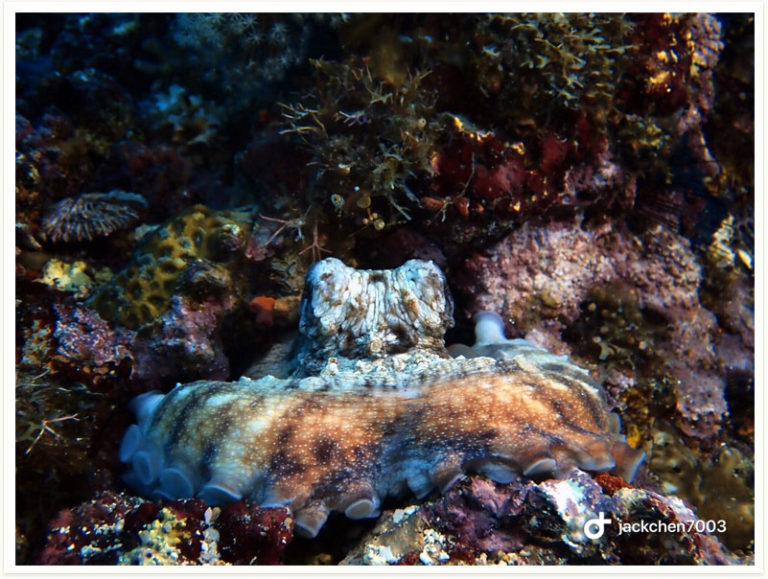
Nemateleotris magnifica, the fire goby, fire fish, fire dartfish, or red fire goby is a species of dartfish native to the Indian and Pacific oceans from the eastern coast of Africa to the Hawaiian Islands and from the Austral Islands north to the Ryukyu Islands. It is an inhabitant of reefs where it can be found at depths of from 6 to 70 metres (20 to 230 ft). It is usually found just above the bottom, facing into the current, where it awaits its prey of small invertebrates.
Micrognathus andersonii es una especie de pez de la familia Syngnathidae en el orden de los Syngnathiformes.
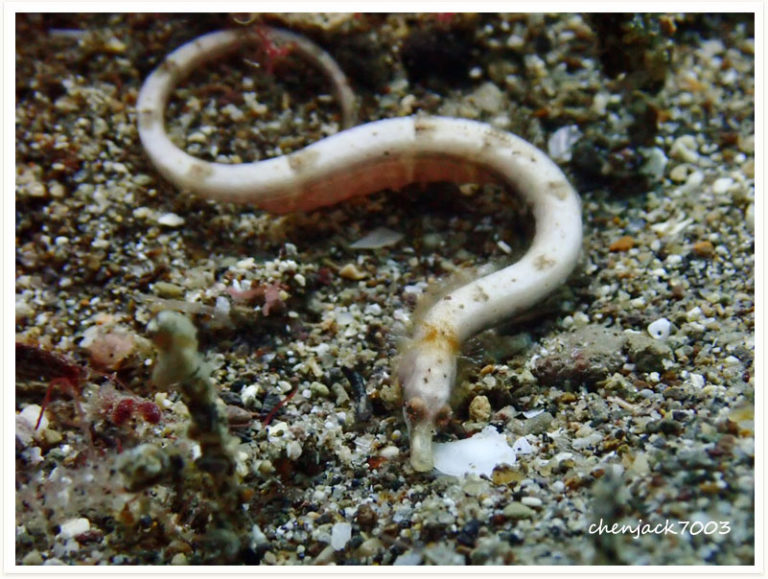
M. pfefferi is a robust-looking species, having a very broad, oval mantle. Arms are broad and blade-like and have four rows of suckers. The modified arm used by males for fertilisation, called the hectocotylus, is borne on the left ventral arm. The oral surface of the modified region of the hectocotylus is wide, swollen, and fleshy. It bears transversely grooved ridges and a deep furrow running along the middle. The sucker-bearing surface of the tentacular clubs is flattened, with 5 or 6 suckers arranged in transverse rows. These suckers differ greatly in size, with the largest located near the centre of the club. Three to four median suckers are especially large, occupying most of middle portion of the club. The swimming keel of the club extends considerably near to the carpus. The dorsal and ventral protective membranes are not joined at the base of the club, but fused to the tentacular stalk. Dorsal and ventral membranes differ in length and extend near to the carpus along the stalk. The dorsal membrane forms a shallow cleft at the junction with the stalk. This particular species of cuttlefish is the only one known to walk upon the sea floor. Due to the small size of its cuttlebone, it can float only for a short time.
The reef manta ray can grow to a disc size of up to 5 m (16 ft) but average size commonly observed is 3 to 3.5 m (11 ft). It is dorsoventrally flattened and has large, triangular pectoral fins on either side of the disc. At the front, it has a pair of cephalic fins which are forward extensions of the pectoral fins. These can be rolled up in a spiral for swimming or can be flared out to channel water into the large, forward-pointing, rectangular mouth when the animal is feeding. The eyes and the spiracles are on the side of the head behind the cephalic fins, and the 5 gill slits are on the ventral (under) surface. It has a small dorsal fin and the tail is long and whip-like. The manta ray does not have a spiny tail as do the closely related devil rays (Mobula spp). The color of the dorsal side is dark black to midnight blue with scattered whitish and greyish areas on top head. The ventral surface is white, sometimes with dark spots and blotches. The markings can often be used to recognise individual fish.Mobula alfredi is similar in appearance to Mobula birostris and the two species may be confused as their distribution overlaps. However, there are distinguishing features.
The midnight snapper (Macolor macularis) is a marine fish native to the western Pacific Ocean.
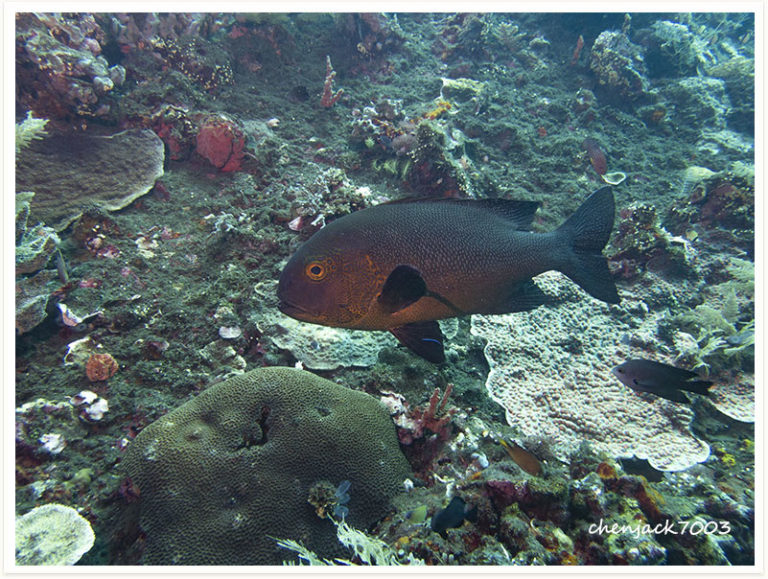 .jpg)
.jpg)
The two-spot red snapper can reach a length of 90 cm (35 in), though most do not exceed 76 cm (30 in). The greatest recorded weight for this species is 12.5 kg (28 lb). These large reddish tropical snappers show darker fins, a rounded profile of head and a groove running from the nostrils to the eyes. They have 10 dorsal spines and 3 anal spines. Juveniles and some adults have two silvery-white spots (hence the common name) on the back close to their dorsal fins, while larger adults lose the spots and become mostly red. Large adults may cause ciguatera poisoning.
Liachirus is a genus of soles native to the Indian and western Pacific oceans.
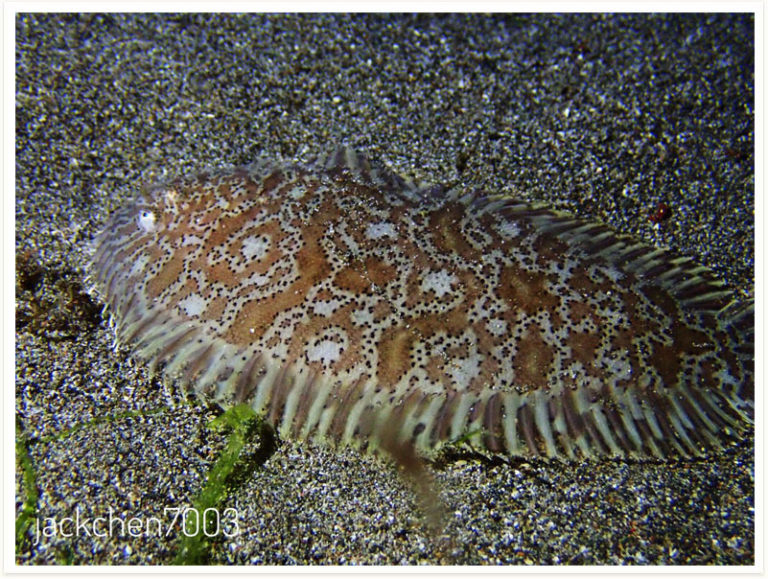
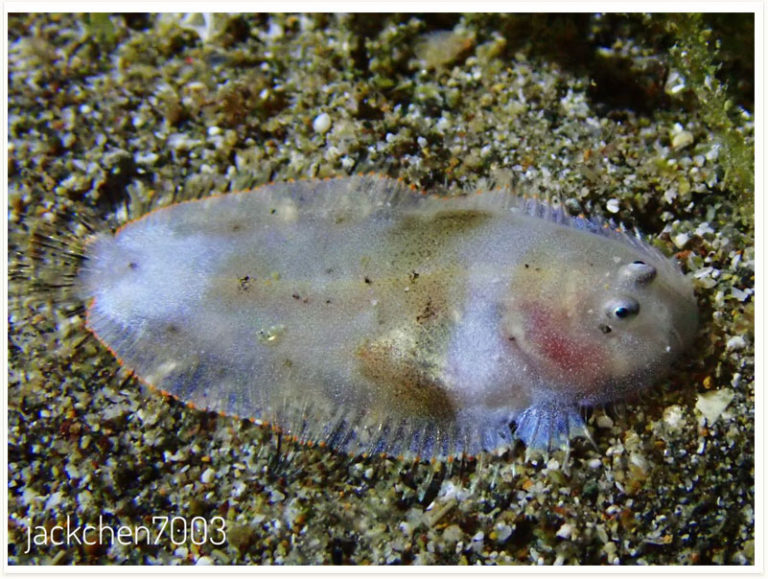
Lethrinus olivaceus can reach a length of about 70–100 centimetres (28–39 in). This large lethrinid has a very long snout, with dark wavy streaks. The basic color of the body is olive-grayish, usually with various irregular darker blotches, but it can have different colour and pattern for a better camouflage. It has 10 dorsal spine, 9 dorsal soft rays, 3 anal spines and 8 anal soft rays. Juveniles show a more forked caudal fin. This species is very similar to Lethrinus microdon.
The threeband pennantfish is a small-sized fish that can reach a maximum length of 18 cm.The body is laterally strongly flattened, with a basic white color and three broad oblique brown bands. The first dark brown band runs from the forehead up to the ventral fins, the second from the dorsal fin to the anal fin, the third is adjacent to the dorsal fin. The first rays of the dorsal fin is elongated and looks like a black and white feather.
The reef bannerfish is a small-sized fish that can reach a maximum length of 25 cm. However, the average size generally observed in the nature oscillates around 15 cm.
Its body is compressed laterally, the first rays of its dorsal fin stretch in a long white filament. The background color of its body is white with two large black diagonal bands. Beyond the second black stripe, the dorsal and the caudal fins are yellow. The pectoral fins are also yellow. The head is white, the eyes are black and linked together by a black band. The snout, spotted with black, is a bit stretched with a small terminal protractile (it can be extend) mouth.
The pyramid butterflyfish is a small-sized fish that can reach a maximum length of 18 cm.
Its body is compressed laterally with a rounded body profile, and its snout protrudes forwards slightly with a small protrusible (extendable) mouth. Its very characteristic livery leaves no doubt about the identification.
The barred thicklip wrasse is a medium-sized fish that can reach a maximum length between 30 cm to 50 cm.
Its body is high, relatively flattened, its head is large and its terminal mouth has thick lips. Its body coloration varies according to age.
During the juvenile phase, this wrasse has a green-yellow background color with six yellow vertical lines and in between them there is thin black vertical lines which are not necessarily visible.
The yellow longnose butterflyfish or forceps butterflyfish, Forcipiger flavissimus, is a species of marine fish in the family Chaetodontidae.
The yellow longnose butterflyfish is widespread throughout the tropical waters of the Indo-Pacific area from the eastern coast of Africa to Hawaii, Red Sea included, and is also found in the eastern Pacific Ocean from Baja California to the Revillagigedo Islands and the Galapagos.
Common in the Solitary Islands Marine Park. Widespread tropical Indo-Pacific: East Africa and Red Sea to the Western Pacific. In Australia recorded from southern Western Australia, across the tropical north, south through Queensland to central New South Wales, and including Lord Howe Island.
The long-snout clingfish is a small type of fish, which can grow up to 5 centimetres (2.0 in).
It has an elongated body and a stretched and spatulate snout. The snout is a criterion for recognizing the sex of the fish, since females have a longer and finer snout than males. This sexual dimorphism reflects a different diet between the two sexes.
The zebra turkeyfish is an unusual looking fish with vertical stripes in orange, white and black on the body, and large, banded fan-like pectoral fins that flare out on either side as the fish lies on the seabed. The front dorsal fin is made up of thirteen tall, quill-like spines and the second dorsal fin has ten to eleven soft rays. The anal fin has three spines and about ten soft rays. The second dorsal fin, the anal fin and the rounded caudal fin are transversely banded in black and white. This fish grows to a maximum length of about 25 cm (10 in).
Dactylopus kuiteri, known commonly as the Kuiter’s dragonet, is a species of marine fish in the family Callionymidae.
The Kuiter’s dragonet is widespread throughout the tropical waters of the central Indo-Pacific region and particularly around Indonesia.
This species can reach 40 cm (16 in) in total length, though most do not exceed 20 cm (7.9 in).As a juvenile, it is a bright red colour with large, black-margined white spots. As an adult, it has a pink face and fins, with the exception of the tail fin, which is bright yellow. The body is green towards the anterior darkening and decorated with bright blue specks towards the caudal peduncle. The fish also gains a very bright orange anterior when it grows into adulthood, and has a drastically shaded body in the posterior region that is dotted with very bright blue spots ringed with dark blue.
Cociella is a genus of flatheads native to the Indian and Pacific oceans.
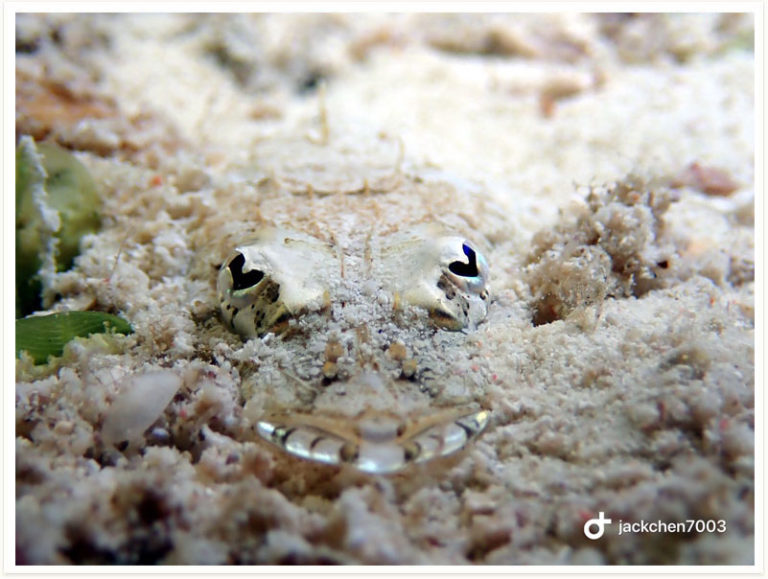
The spotted hawkfish, Cirrhitichthys aprinus is a species of hawkfish widespread throughout the tropical waters of the Indo-West Pacific region.A common species, it is found in rocky and coral areas of subtidal coastal reefs.
It can reach a maximum length of 12.5 cm (4.9 in). It is a food fish for indigenous peoples and can also be found in the aquarium trade. It is red-pink and white in color, and has tassels on the tip of its dorsal fin.
The humphead wrasse is the largest living member of the family Labridae. Males are typically larger than females and are capable of reaching lengths of up to 2 meters from tip to tail and weighing up to 180 kg, but the average length is generally a little less than 1 meter. Females rarely grow larger than one meter in length. This species of fish can be easily identified by its large size, thick lips, two black lines behind its eyes, and the hump that appears on the forehead of larger adults. The color of the humphead wrasse can vary between a dull blue-green to more vibrant shades of green and purplish-blue. This particular reef fish prefers to live singly but adults are occasionally observed moving in small groups.
The vagabond butterflyfish (Chaetodon vagabundus) is a species of butterflyfish (family Chaetodontidae). It is found in the Indo-Pacific region from the Red Sea and off East Africa as far east as the Tuamotu Islands, north to southern Japan and south to the Austral Islands.
The Ornate Butterflyfish, Chaetodon ornatissimus, is a species of butterflyfish (family Chaetodontidae). The Ornate Butterflyfish is widespread throughout the tropical waters of the Indo-Pacific area.
The Coral hind is a small size fish and can reach a maximum size of 20 cm length . It is found in depths down to 36 m.
The black-backed butterflyfish or blackback butterflyfish (Chaetodon melannotus) is a species of butterflyfish (family Chaetodontidae). It is widespread through the Indo-Pacific area from the Red Sea and East Africa to Samoa, to southern Japan and throughout Micronesia.
This fish grows up to 18 cm (c. 7 in) long, and may live for up to 20 years. When observed at night or when frightened, this species changes color; the dorsal portion of the body turns black except for two white patches.
The body of this fish is yellowish brown with 1-2 broad lighter vertical bars, one running from near the origin of the dorsal spine to the belly, and sometimes another running from the middle of the back to the center of the body. A black bar runs vertically across the eye, and the part before this is whitish, with a black snout. The color varies somewhat across the range; western specimens usually have one beige bar, while eastern ones have two white bars. There may be numerous dotted horizontal stripes on the sides, or another dark band between the two light ones in eastern specimens.
The bluelashed butterflyfish or eclipse butterflyfish (Chaetodon bennetti) is a species of butterflyfish (family Chaetodontidae). It is found in the Indo-Pacific from East Africa to the Pitcairn Islands, north to Japan and south to Lord Howe Island and Rapa Iti.
Chaetodon auriga is up to 23 centimetres (9 in) long. Its body is white with `chevron’ markings on the side. Tear edge of the dorsal fin has a prominent black spot, and a prominent black vertical band runs through the eye. The rear of soft-dorsal fin has a trailing filament, and it has a belly patch of descending oblique dark lines as well as bright yellow fins. Two subspecies are sometimes recognised: Chaetodon auriga auriga occurs in the Red Sea population and lacks the dorsal eyespot; Chaetodon auriga setifer is the spotted population occurring outside the Red Sea.
It grows to a maximum length of 20 cm (nearly 8 in). The body is white with diagonal brown stripes on the sides. The dorsal, caudal, anal and pelvic fins are yellow. There are rounded broad black bands on the face, covering the eye, but not continuous from one side of the body to the other but with a separate black spot centered on the forehead.
It is among the largest parrotfishes, growing to a standard length of up to 50 cm (20 in). As in many of its relatives, it is a sequential hermaphrodite, starting as female (known as the initial phase) and then changing to male (the terminal phase). The initial phase is dark brown with a large cream patch on the upper part of the body. The terminal phase is very colourful, overall green with pink spotting to the body and edging to the fins. Juveniles are white with a black spot on the dorsal fin and an orange band through the eye.
The bluefin trevally is a large fish, growing to a maximum known length of 117 cm and a weight of 43.5 kg, however it is rare at lengths greater than 80 cm. It is similar in shape to a number of other large jacks and trevallies, having an oblong, compressed body with the dorsal profile slightly more convex than the ventral profile, particularly anteriorly. This slight convexity leads to the species having a much more pointed snout than most other members of Caranx. The dorsal fin is in two parts, the first consisting of 8 spines and the second of 1 spine followed by 21 to 24 soft rays. The anal fin consists of 2 anteriorly detached spines followed by 1 spine and 17 to 20 soft rays.The pelvic fins contain 1 spine and 20 soft rays.The caudal fin is strongly forked, and the pectoral fins are falcate, being longer than the length of the head. The lateral line has a pronounced and moderately long anterior arch, with the curved section intersecting the straight section below the lobe of the second dorsal fin. The curved section of the lateral line contains 55-70 scales while the straight section contains 0 to 10 scales followed by 27 to 42 strong scutes. The chest is completely covered in scales. The upper jaw contains a series of strong outer canines with an inner band of smaller teeth, while the lower jaw contains a single row of widely spaced conical teeth. The species has 25 to 29 gill rakers in total and there are 24 vertebrae present.The eye is covered by a moderately weakly developed adipose eyelid, and the posterior extremity of the jaw is vertically under or just past the anterior margin of the eye.Despite their wide range, the only geographical variation in the species is the depth of the body in smaller specimens.
Bulbonaricus brauni (Braun’s pughead pipefish) is a species of marine fish of the family Syngnathidae. It is found in the Eastern Indian Ocean, from Indonesia to Western Australia, and off the Ryukyu Islands of Japan. It lives among coral reefs at depths of 1-10m, and can grow to lengths of 5.5 cm. This species is ovoviviparous, with the males carrying eggs in a brood pouch until they hatch. The specific name honours “the collector” Mr J. Braun who brought the living holotype to the Western Australia Museum
Bothus lunatus has a laterally flattened body and orientates itself so that its right side is underneath and its left side is uppermost. Both eyes are on this upper surface and project on short thick stalks. The body shape is rounded and the dorsal and anal fins nearly surround the body. The former has 92 to 99 soft rays and the latter 71 to 76. The pectoral fins are long and often erect. An average adult length is about 35 cm (14 in), with a maximum length of 46 cm (18 in). The upper surface of this flounder is some shade between grey, brown and tan with small blue spots and circular blue markings, the head and fins also being spotted and speckled with blue. There are two or three rather diffuse dark patches on the lateral line. The fish can vary its background colour to make it closely resemble that of its surroundings and thus camouflage itself as it lies on the seabed. Fish in this genus are able to change their colouring in two to eight seconds.
Bodianus dictynna, is a species of wrasse native to tropical and warm temperate waters of the Western Pacific, from the Indo-Malaysian Archipelago east to Tonga, as far north as Japan and as far south as Australia. It is most frequently recorded in association with living coral reefs and the juvenile fish usually occur near black coral and gorgonians, although they sometimes are found in caves near the ceiling. It feeds mainly on benthic invertebrates such as molluscs and crustaceans. The juveniles regularly behave as cleaner fish, removing parasites from other fish. The specific name dictynna is an alternative name for Diana, the Roman goddess of hunting, and refers to the close relationship between this species and Bodianus diana of the Indian Ocean, and a proposed common name of Pacific Diana’s pigfish also reflects this relationship.
Aspidontus dussumieri, the lance blenny or Dussumier’s blenny, is a species of combtooth blenny found in coral reefs in the Pacific and Indian Oceans.The specific name honours the French explorer and merchant Jean-Jacques Dussumier (1792-1883).
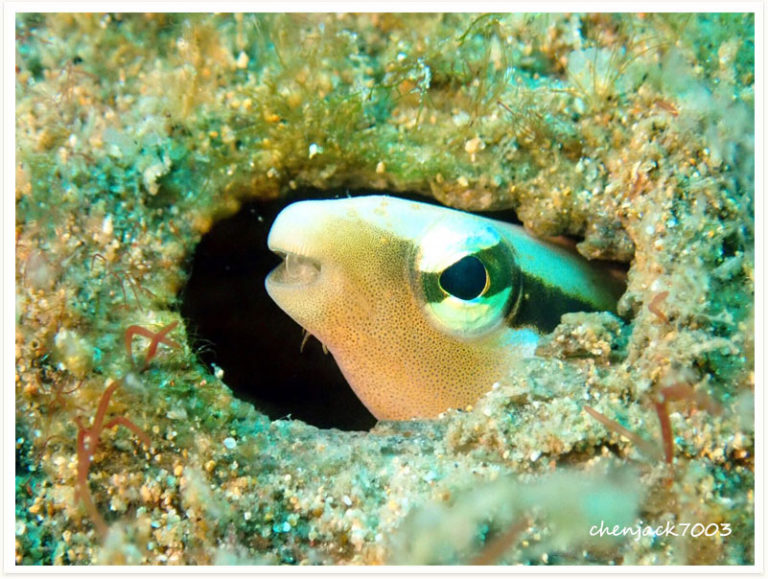
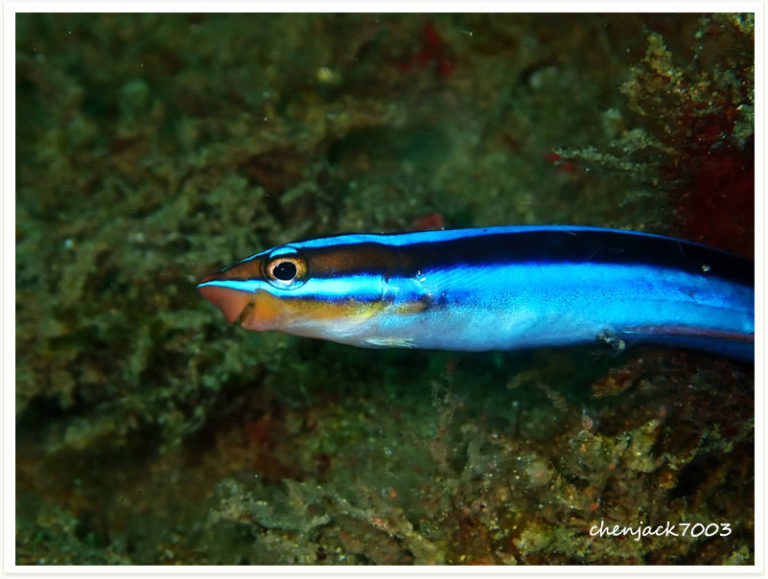
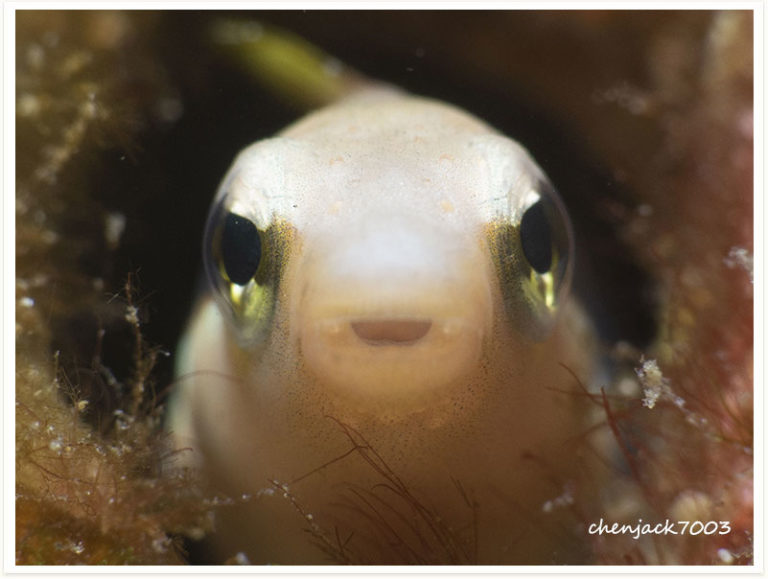
Aseraggodes is a genus of soles native to the Indian and Pacific oceans. These small flatfishes are poisonous.
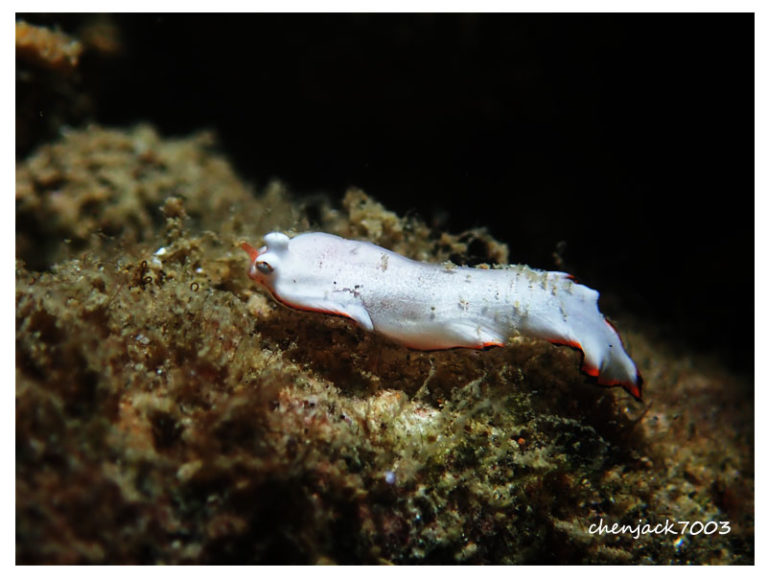
Arothron stellatus is a medium-sized fish which grows up to 120 cm (47 in) in length. Its body is oval shaped, spherical and relatively elongated. The skin is not covered with scales but is prickly. The fish has no pelvic fin and no lateral line. The dorsal fin and the anal fin are small, symmetric, and located at the rear end of the body. The head is large with a short snout that has two pairs of nostrils, and the mouth is terminal with four strong teeth.
Arothron nigropunctatus is a small sized fish which grows up to 33 cm (1 ft) length. Its body is oval shape, spherical and relatively elongated. The skin is not covered with scales. The fish has no pelvic fin and no lateral line. The dorsal fin and the anal fin are small, symmetric and located at the end of the body. Its snout is short with two pairs of nostrils and its mouth is terminal with four strong teeth.
Arothron caeruleopunctatus is a medium-sized fish which grows up to 80 cm length. Its body is oval shape, spherical et relatively elongated. The skin is not covered with scales. The fish has no pelvic fin and no lateral line. The dorsal fin and the anal fin are small, symmetric and located at the end of the body. Its snout is short with two pairs of nostrils and its mouth is terminal with four strong teeth.
This small fish grows up to 22 cm (8.7 in) long. Like other members of its family, it has a rounded, extensible body, and its soft skin is covered with irregularly-arranged dermal spinules resembling hairs. Its large mouth is forwardly extensible, allowing it to swallow prey as large as itself. The coloring of its body is extremely variable because individual fish tend to match their living environments. Frogfishes have the capacity to change coloration and pigment pattern, taking only a few weeks to adapt. The dominant coloration varies from yellow to brownish-orange, passing through a range of shades, but it can also be green, gray, brown, almost white, or even completely black without any pattern. Body and fins can be marked with roughly parallel dark stripes or elongated blotches, some with rays radiating outward from the eye.
The warty frogfish grows up to 15 cm (5.9 in) long. Like other members of its family, it has a globulous, extensible body, and its soft skin is covered with small dermal spinules. The skin is covered with numerous small, wart-like protuberances. Its large prognathous mouth allows it to consume prey its same size. The coloring of its body is extremely variable because it tends to match its living environment.
The blue-spotted wrasse, Anampses caeruleopunctatus, is a species of wrasse found from the Atlantic coast of South Africa through the Indian Ocean to Japan and Australia east to Easter Island in the Pacific Ocean (though absent from Hawaii). This species is found at depths from 3 to 30 m (9.8 to 98.4 ft), with the adults preferring the surge zone on coral reefs or along rocky coastlines. Juveniles orient their bodies and move in such a way as to resemble floating leaves. This species can reach a length of 42 cm (17 in). It is of minor importance to local commercial fisheries and can be found in the aquarium trade.
The body of A. perideraion is pink to peach. It has the white stripe along the dorsal ridge that is common to all members of the skunk complex and a white head bar running vertically just behind the eye. While the largest species of anemonefish can reach a length of 18 cm (7.1 in), A. perideraion is one of the smallest species, with females growing to a length of 10 cm (3.9 in).
The common clownfish is a small fish which grows up to 11 cm (4.3 inches). Its body has a stocky appearance and oval shape. It is compressed laterally, with a round profile. The coloration of its body is orange to reddish-brown, but it can also be black in some particular areas such as the Northern Territory in Australia.It has three vertical white stripes outlined with a fine black line. The first passes just behind the eye, the second in the middle of the body widens forward to the head centrally and the third one circles the caudal peduncle. All the fins are also outlined with a fine black line. A. ocellaris is often confused with Amphiprion percula, which possesses exactly the same colours and patterns at first sight but distinguishes itself by the thickness of the black outlines. Additionally, A. ocellaris has a taller dorsal fin, and typically possesses 11 dorsal-fin spines vs. 10 spines in Amphiprion percula.
A. melanopus adults can grow to 12 cm (4.7 inches). The body of A. melanopus is a dark red to orange with mahogany sides. Juveniles and adults have a white head band, which is wide and starts behind the eye, which may gave a blue tint. The dorsal and caudal fins of the fish have a lighter color than the rest of the fish and can sometimes be a cinnamon color. The pelvic and anal fins are usually black.
Clark’s anemonefish is a small-sized fish which grows up to 10 cm as a male and 15 cm as a female.It is stocky, laterally compressed, and oval to rounded.
It is colorful, with vivid black, white, and yellow stripes, though the exact pattern shows considerable geographical variation. Usually it is black dorsally and orange-yellow ventrally, the black areas becoming wider with age. There are two vertical white bands, one behind the eye and one above the anus, and the caudal peduncle is white. The snout is orange or pinkish. The dorsal and caudal fins are orange-yellow, and the caudal fin is generally lighter in tone than the rest of the body, sometimes becoming whitish.
It’s a small size fish that can reach a maximum size of 8,5 cm length.
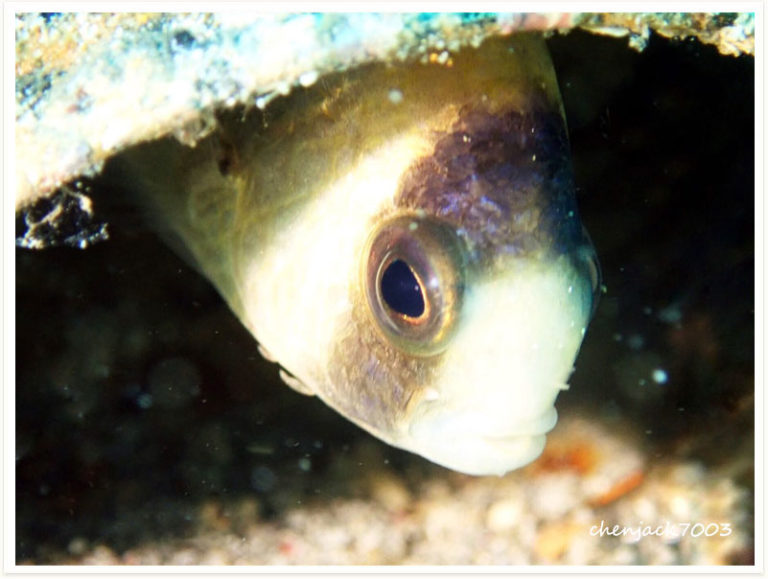
Aluterus scriptus is a medium size fish which can grow up to 110 cm (3.6 ft) in length. The body shape looks like an elongated oval, strongly compressed. Its background body coloration is olive-brown or grey depending on its surrounding environment, irregular blue lines and spots are distributed on the body mixed with some black spots mainly on the head. The colors may quickly vary depending on background similar to an octopus’s. Fish observed in the Virgin Islands might lie flat on the sand and become pure white or change to any of the other representative colors. The mouth is small and at the end of its pointed snout. Like all the Tetraodontiformes, it has no pelvic fin but has two particular dorsal spines; the first anterior one is long, slender and erectile, located just over the eyes, the second is small and not easy to see but it locks the first one when it is erected.[3] The rounded caudal fin is quite long and can be displayed as a fan.
The razorfish is easily identifiable due to its particular body shape as well as its way of moving in synchrone group head down. It is a small fish with a maximum size of 15 cm (5.9 in) long, its body is stretched ending by a long fine “beak”. Its fins are considerably reduced and transparent. The dorsal surface of the razorfish is covered by protective bony plates. They extend past the end of the body and over the tail fin, which terminates in a sharp spine. A black to brown median band runs the length of the fish crossing also the eyes. The color of the body is variable with the habitat. In seagrass environment, the background color of the body can be greenish-yellow with light brown stripes. In open areas like sand patch, rubble or close to coral reef, then the body coloration occurs to be light silver with a black to brown stripe. There is no known sexual dimorphism.
Acanthurus thompsoni is a tropical fish found in the Pacific and Indian Oceans. It is commonly known as the Thompson’s surgeonfish. It is commercial in aquarium use.
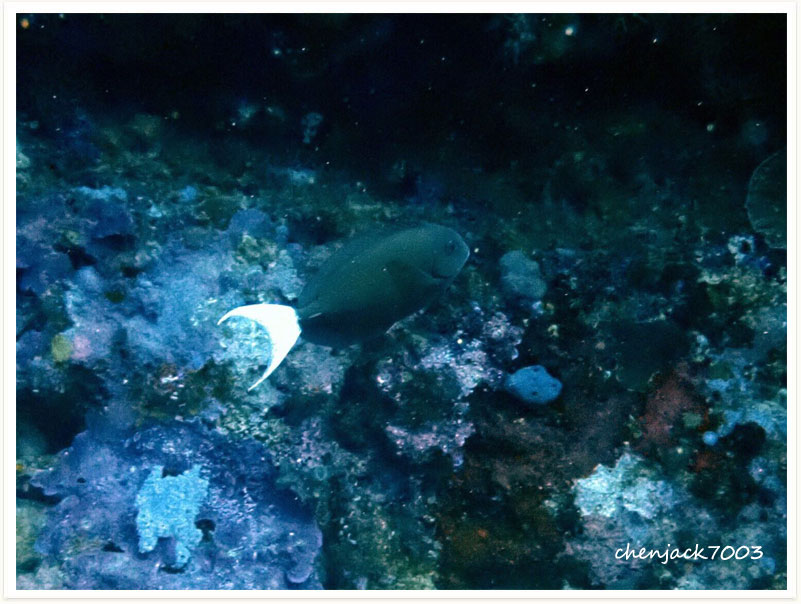
This fish can be up to 6 inches (15 cm) in length. The body compressed laterally, endowed with a dorsal fin starting from the top of the head until joining practically the superior base of the caudal fin. When the dorsal fin is spread, it looks like a crest resembling the one on a cockatoo. The thorns of the dorsal fin are venomous. This fish mostly stays on the substratum and moves by means of its pectoral fins. Its color varies from cream to dark brown, with irregular spots.
Panulirus versicolor is a species of spiny lobster that lives in tropical reefs in the Indo-Pacific. Other names include painted rock lobster, common rock lobster, bamboo lobster, blue lobster, and blue spiny lobster. P. versicolor is one of the three most common varieties of spiny lobster in Sri Lanka, alongside Panulirus homarus and Panulirus ornatus.
The cephalothorax of Allogalathea elegans is droplet-shaped. The extremity of the body corresponds to the triangular rostrum of the animal, which are positioned on each side the pedunculated eyes. The chelipeds or the first pair of legs are endowed with pincers and are longer than the animal body. The last pair of legs are wasted. The body and mainly the legs are covered with small hairs. The animal’s size depends on the sex. Females are usually bigger than males but never grow over 2 cm. The animal’s coloration is variable and is matching the colours of its host but not systematically. It can be uniform and varied from dark red, blackish purple, orange or brown. But generally, the observed animals have longitudinal stripes which the thickness, the number and the tint varies.
Pseudoceros lindae can reach a length of 50–80 millimetres (2.0–3.1 in). The upper surface of the thick and elongated body shows a wine color (burgundy) background with turquoise margins and a variable number oval to round yellow-golden spots. This pattern may vary from one individual to another especially in the density of points. The ventral side is light purple. Each pseudotentacle is formed by a broad simple fold of the anterior margins of the body. Also pharynx is formed by highly elaborated folds. This species is a simultaneous hermaphrodite, so it can make cross fecundation. There is a single male reproductive organ, that penetrates in any part of the mate’s body, and the females have a short vagina directed backwards.
Pseudoceros is a genus of flatworms.
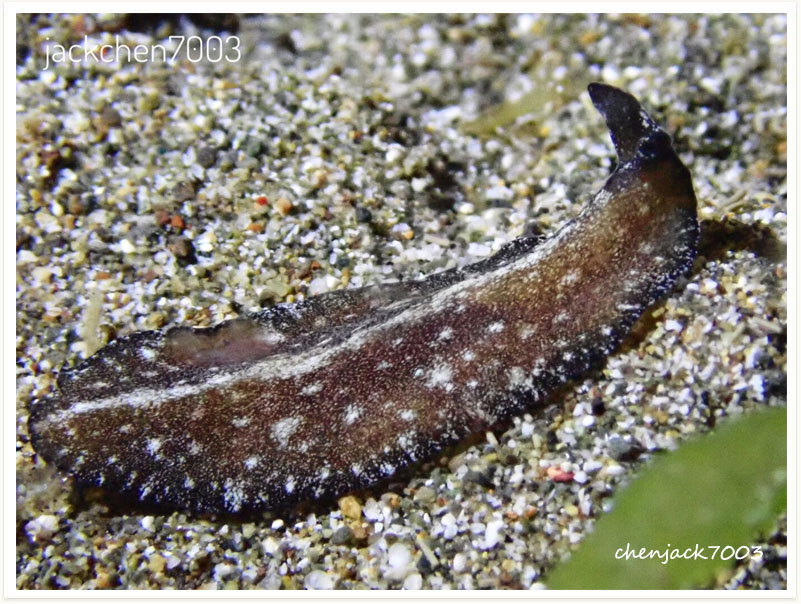
Acanthozoon is a genus of flatworm polyclads belonging to the Pseudocerotidae family.
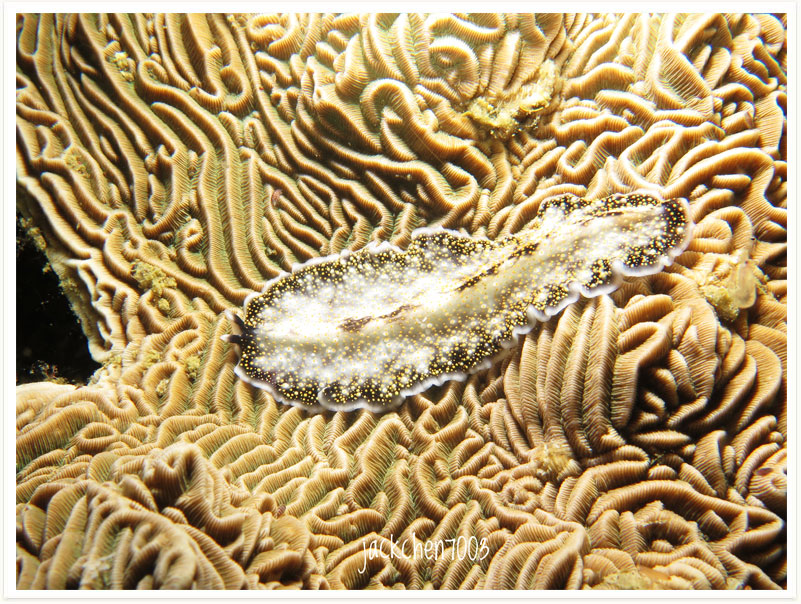
Z. adamsii is a small crab, described as “a torpid, though elegant little crustacean” by the English naturalist Arthur Adams when it was first discovered by him and the Scottish zoologist Adam White during the surveying voyage of HMS Samarang in the Far East between 1843 and 1846. The carapace and limbs are smooth and hairless and are adorned with long spines. The colour is pink with dark, reddish-brown vertical stripes.
The males are bright blue in color with white spots and with characteristically long chelipeds, while the females have a duller green/brown, with a more rounded carapace. The carapace can be up to 20 centimetres (7.9 in) wide.
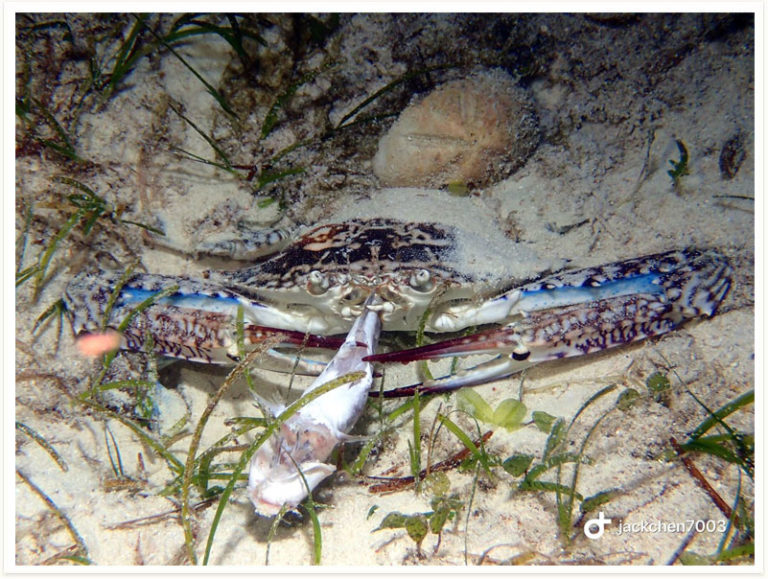
Neopetrolisthes maculatus is a species of porcelain crab from the Indo-Pacific region.It is a small, colourful crustacean with a porcelain-like shell. This porcelain crab is usually found within the stinging tentacles of a number of sea anemone species.
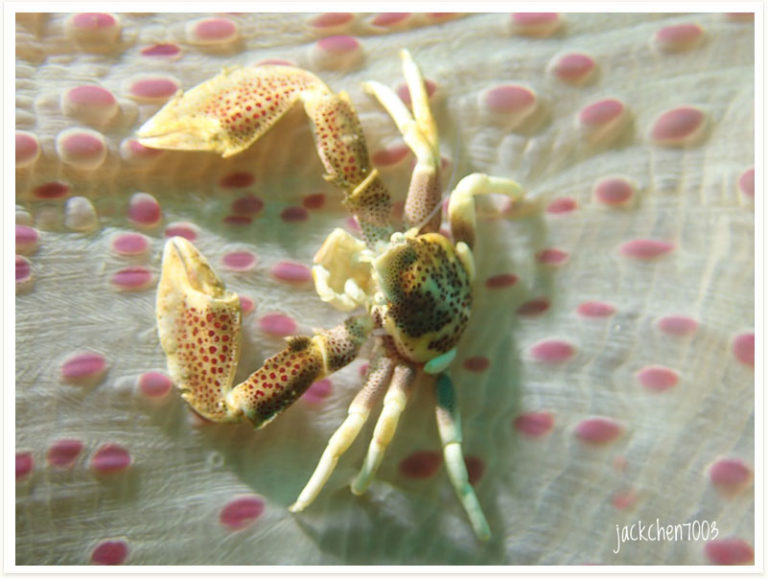
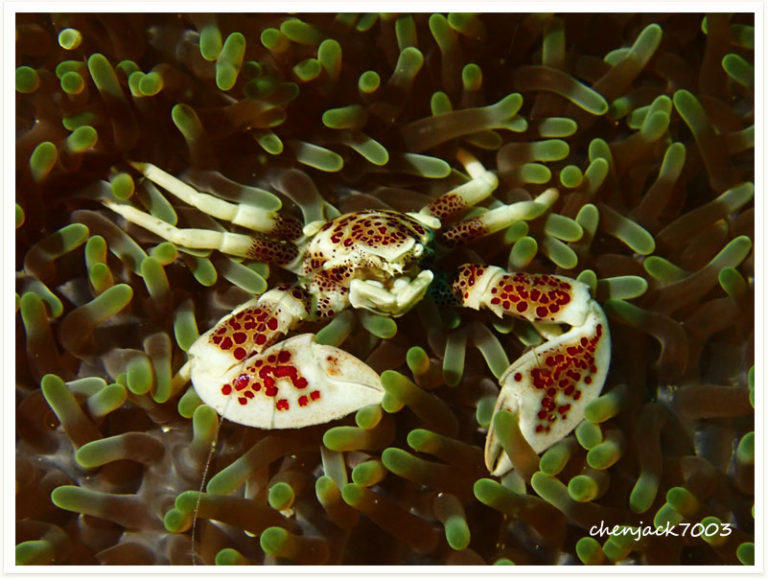
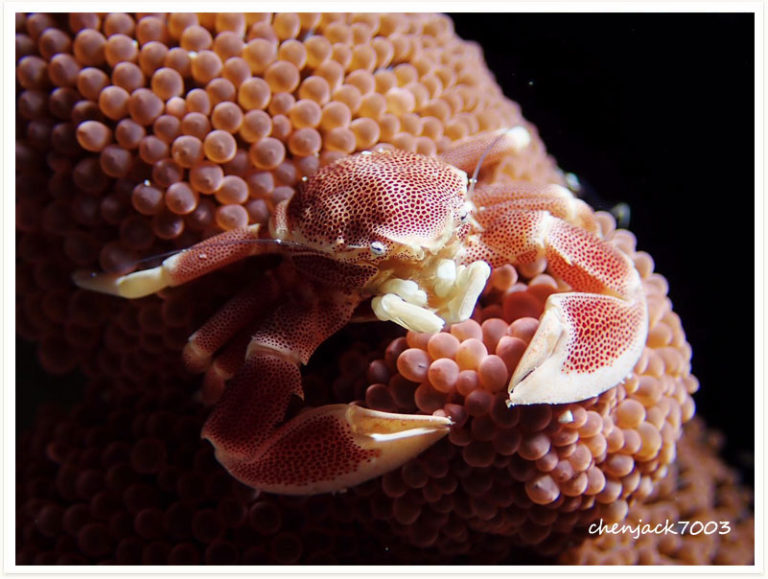
Lissoporcellana nakasonei is a ten-pot species from the Porcellanidae family. The scientific name of the species was first validly published in 1978 by Miyake.
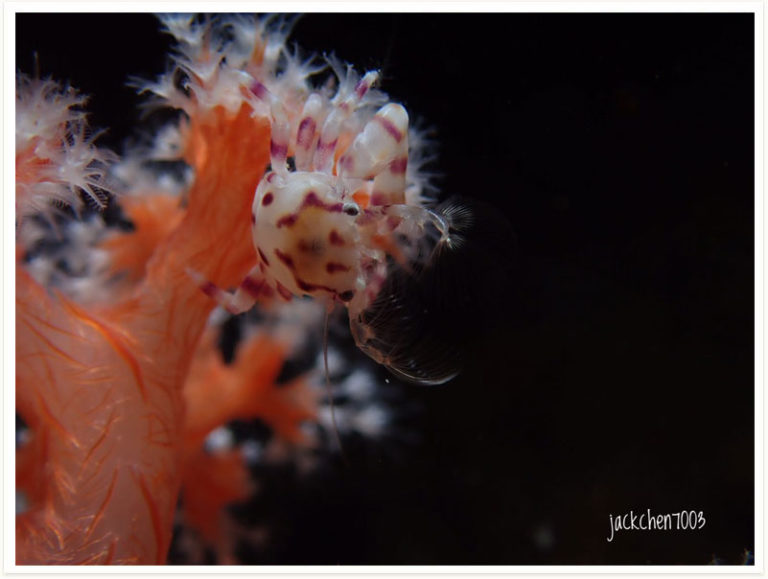
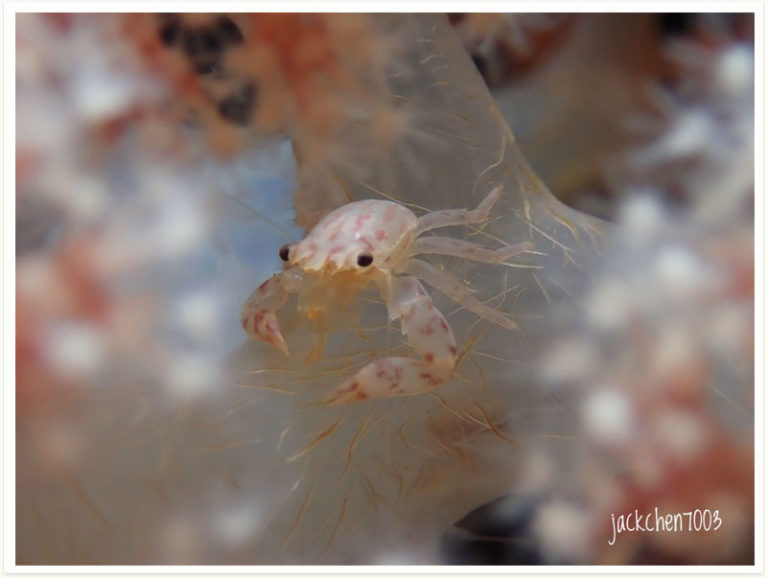
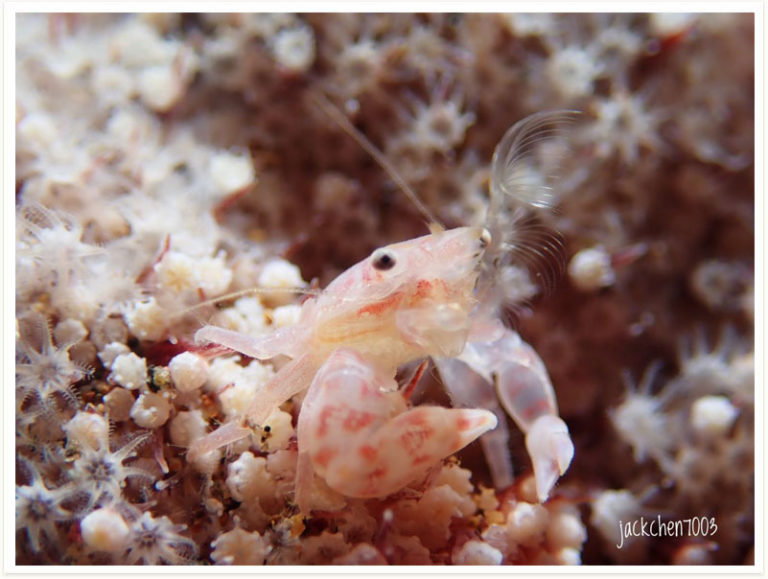 .jpg)
.jpg)
Hoplophrys oatesi is a very colourful crab that grows from 1.5 to 2 cm. It lives on various species of soft coral in the genus Dendronephthya. It camouflages itself by mimicking the colours of the polyps among which it hides. It adds further camouflage by attaching polyps to its carapace. Colours vary depending on the colour of the coral, and may be white, pink, yellow or red.
Colonies of Plerogyra sinuosa are in the form of an inverted cone that may be as much as a metre (yard) across. The corallites in small colonies are monocentric and trochoid, but become flabellomeandroiid (arranged in valleys, the neighbouring valleys having separate walls) in larger colonies. The septa have smooth margins but are irregularly arranged giving the colony an untidy appearance. The costae on young colonies sometimes form lobes which develop spines. These spines then elongate and a new polyp develops, this budding method being an unusual occurrence among corals.
Paracorynactis hoplites polyps can vary in diameter from as small as only 2 mm (0.08 in) to as large as 21 cm (8 in). Their tentacles end in extremely sticky balls (acrospheres) covered with stinging cells
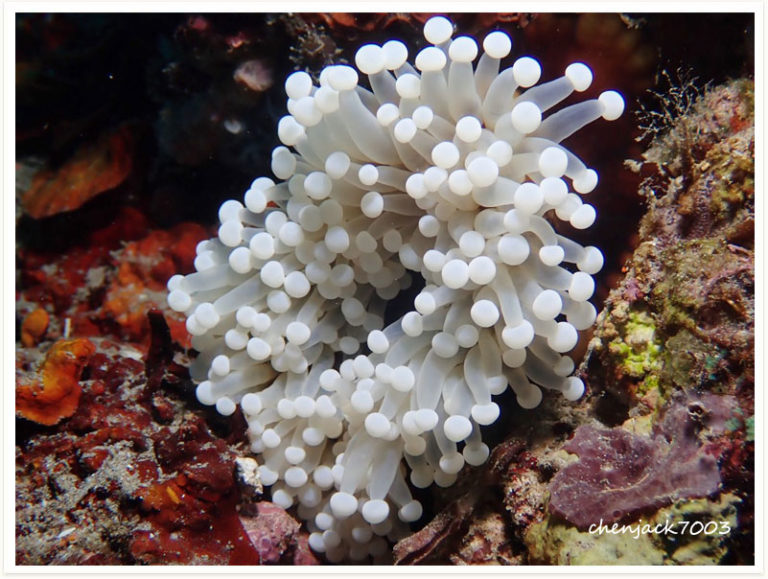
Pachycerianthus is a genus of marine tube-dwelling anemones in the family Cerianthidae.
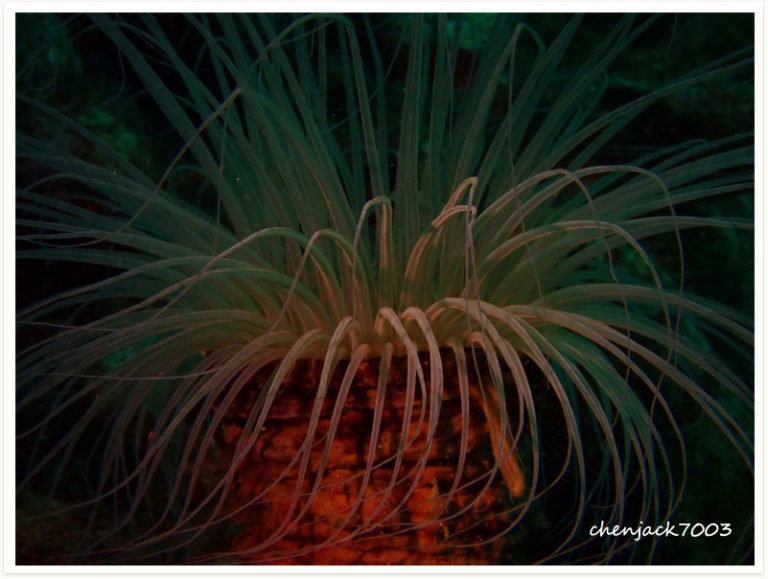
Ovabunda is a genus of soft corals in the family Xeniidae.

The magnificent sea anemone is characterized by a flared oral disc which reaches between 20 and 50 cm in diameter, but in some specimens, this can reach 1 m. The oral disc, the base of the tentacles, and the oral orifice have the same color going from light beige to white.
The numerous tentacles exceed 8 cm long. The sea anemone, being a member of the Hexacorallia, usually carries tentacles in multiples of six that are positioned in concentric circles. Their tips are fingered and often lighter in coloration than the tentacle body and are sometimes vividly colored.
Goniopora, often called flowerpot coral, is a genus of colonial stony coral found in lagoons and turbid water conditions. Goniopora have numerous daisy-like polyps that extend outward from the base, each tipped with 24 stinging tentacles which surrounds a mouth.
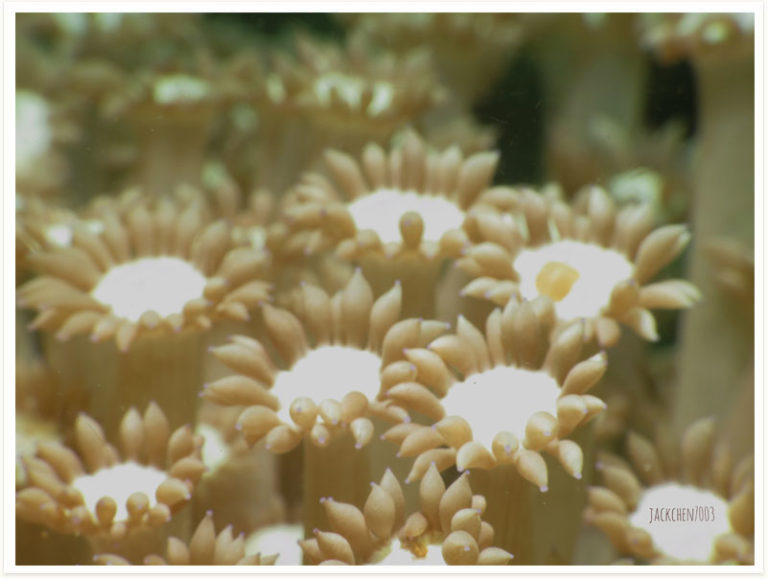
This type of madreporial colony is easy to identify because of its puffy tubular tentacles with T-shaped tips. The coral is blue-gray to orange in color, sometimes with green on the tentacles. It can demonstrate full or partial viral infection of green fluorescent protein, a trait highly sought for aquarium specimens. Colonies are usually no more than a meter across, but at times can reach several meters.
Bubble-tip anemone (Entacmaea quadricolor) is a species of sea anemone in the family Actiniidae. Like several anemone species, E. quadricolor can support several anemonefish species, and displays two growth types based on where they live in the water column, one of which gives it the common name, due to the bulbous tips on its tentacles.
unknow
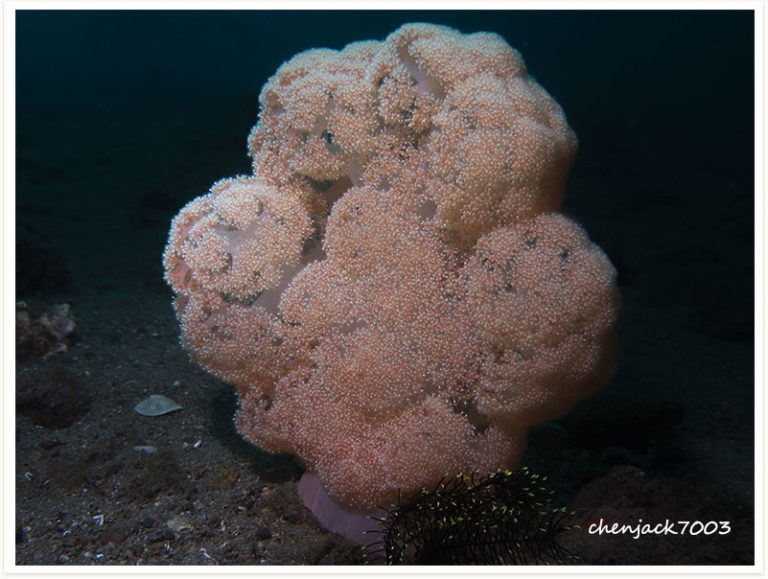
The visible part of its body corresponds to its oral region and forms a flexible disc, when it is deployed, endowed with cone-shaped tentacles. Its diameter can reach 40 centimetres (16 in) and its coloration is light beige to brown.
